

Visit Corsica: Top 35 Things to Do and Must See Attractions
The 35 best things to do in corsica (bucket list).
You’re planning to visit Corsica, this beautiful island in the South of France during your next holidays? You want to know more about the best places to visit?
You’re at the right place!
In order to help you plan your stay, I have prepared this guide of the 35 best things to do in Corsica , with all the must-see attractions of the island.
I will tell you everything about the most famous cities such as Bastia , Calvi , Ajaccio and Bonifacio , the world famous Scandola Nature Reserve , the best beaches and many more amazing secret places to visit during your trip 😉.
And at the end of the article, I will also give you detailed itineraries to plan your visit depending on the duration of your stay.
So, where to go in Corsica? What are the best points of interest?
Let’s find out!
2. Cap Corse
3. saint florent, 4. agriates desert, 5. l’île rousse, 7. the perched villages of balagne, 8. the revellata peninsula and our lady of the serra, 9. the fango valley, 10. scandola nature reserve and girolata – porto, 11. the calanques de piana, 12. hiking in corsica, 13. the gr 20, 14. corsica’s best beaches, 15. spelunca gorge, 16. the forest of aïtone, 17. cargese, 18. ajaccio and the sanguinaires islands, 19. propriano, 20. sartene, 21. bonifacio, 22. the lavezzi islands, 23. porto-vecchio, 24. the ospedale, 25. the aiguilles de bavella, 27. the asco valley and monte cinto, 28. restonica gorge, 29. visit east corsica, 30. diving in corsica, 31. the other outdoor activities in corsica, 32. take the trinicellu, the corsican train, 33. discover corsica’s gastronomy, 34. the wine route, 35. the “route des sens authentiques”, corsica tours, tourist map of corsica, by ferry boat, renting a boat in corsica, you’re traveling to corsica these articles will help you , visit corsica: the 35 best places to visit and must-see attractions.
In order to help you plan your stay in Corsica, I have prepared detailed itineraries depending on your trip duration . You should read them after reading this article.
You can find them here, simply click on the orange links to read the articles:
- Itinerary: 2, 3, 4 or 5 days in Corsica – The perfect itinerary for a short stay in Corsica
- Itinerary: 1 week in Corsica – The best Itinerary to visit Southern Corsica
- Itinerary: 6, 7 or 8 days in Corsica – The definitive guide to visit Northern Corsica in 1 week
- Itinerary: 10 days in Corsica – The best 10 days itinerary in Corsica
- Itinerary: 2 weeks in Corsica – How to visit Corsica in 14, 15 or 16 days.
They will allow you to plan your trip very easily!
And if you have any question, don’t hesitate to ask me in the comments section, at the end of the article. I would be glad to help you plan your stay.
Let’s start this Corsica travel guide with B astia, t he island’s economic capital.
Located in the north , the city is a good starting point for a trip to Corsica. With its port and international airport, you can easily get there by plane or with the ferries from France (from Nice and Toulon for example) or Italy .
Here are the best places to see in Bastia :
- St. Nicholas Square and its many restaurants and cafés
- Napoleon Street, a lovely pedestrian street with many shops
- The market which takes place every Saturday and Sunday morning
- The church of St. John the Baptist and its 2 bell towers, in the Terra Vecchia district
- The Old Port, the best place to have a drink on a sunny terrace !
- The Romieu gardens and stairs
- The citadel of Bastia where the Terra Nova neighborhood is located
- The Governors’ Palace housing the Bastia History Museum
- St. Mary’s Cathedral, built in 1619, where you can find masterpieces by Italian painters.
And if you want to take a dip, try one of Bastia’s most beautiful beaches :
- Arinella beach, a large sandy beach where you can enjoy many nautical activities
- The beaches of the Marana, located next to Arinella
- The pebble beach of Toga , only a 5 minutes walk from the city centre
- Ficaghjola cove, in the old Bastia
You can find detailed information about Bastia in my article: The 17 best things to do in Bastia.
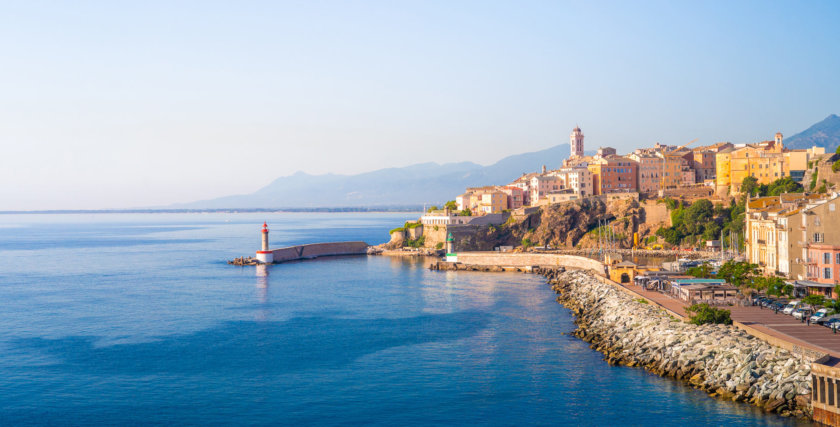
Located North of Bastia, Cap Corse is among the best places to see in Corsica.
What are the best things to do in Cap Corse?
- Take the customs officers’ Path (“Chemin des douaniers” in French) that connects the Macinaggio and Centuri villages. During this 19 km long walk along the coast, you will enjoy splendid views .
This trail is divided into 2 sections :
- The most interesting part goes from Macinaggio to Barcaggio. This 3h30 walk along the seaside offers many beautiful beaches where you can stop for a swim.
- The other part, from Barcaggio to Centuri, is a bit more difficult and takes about 4 hours . As the path is mainly overlooking the sea, it’s harder to find a beach to take a dip!
- Do a 2-hour commented cruise departing from Macinaggio: you will discover the Cap Corse and its Genoese towers, the Finocchiarola archipelago and Barcaggio. You will also enjoy a short swimming stop. It’s the best way to discover Cap Corse if you don’t feel like walking! (Information available here)
- Discover the beautiful villages of Cap Corse: Rogliano, Barrettali, Canari, Pietracorbara… From there, you can also enjoy many walking trails.
- Visit Nonza and its famous black pebble beach.
- Stop at the Mattei mill’s and enjoy a breathtaking view over most of Cap Corse.
- Drive along the Patrimonio wine route (I will give you more information about it later in this article).
If you want to organise your visit to Cap Corse, have a look at my detailed article: Cap Corse : the 15 best things to do.
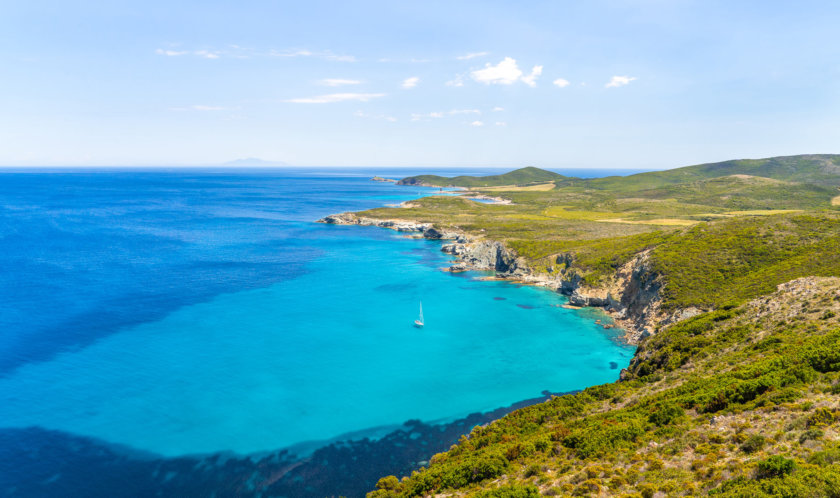
Saint Florent is the second largest marina in Corsica, after Ajaccio. Often compared to Saint-Tropez , this charming village welcomes many tourists every summer and even a few french and international stars!
Take a short walk along the port, and climb up to the citadel through the village’s beautiful small alleys. It won’t take long, and you will enjoy a beautiful panorama, overlooking the Gulf of Saint-Florent .
You should also take some time to visit Santa Maria Assunta cathedral, entirely built in white limestone.
Saint Florent is also the starting point for the Agriates desert boat tours . With its magnificent sand beaches and amazing preserved landscapes, it’s clearly one of Corsica’s must-see attractions !
For more information about Saint-Florent, you can read my detailed article: The 12 best things to do in Saint-Florent.
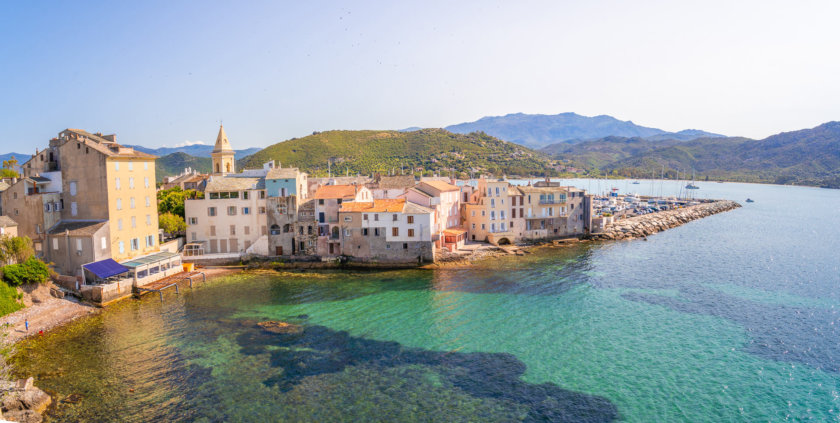
The fastest way to get to Agriates Desert is to take a boat from Saint-Florent .
Agriates Desert is mostly renowned for its 2 magnificent beaches , often ranked among Corsica’s most beautiful:
- Saleccia, a splendid sandy beach with turquoise water, surrounded by a pine forest.
- Lotu beach, another beautiful beach with translucent water.
If you wish to spend a whole day sunbathing and swimming during your holidays in Corsica, you’re in the right place!
You will find every information you need to visit the Agriates in my article: Visit the Agriates Desert: the definitive guide.
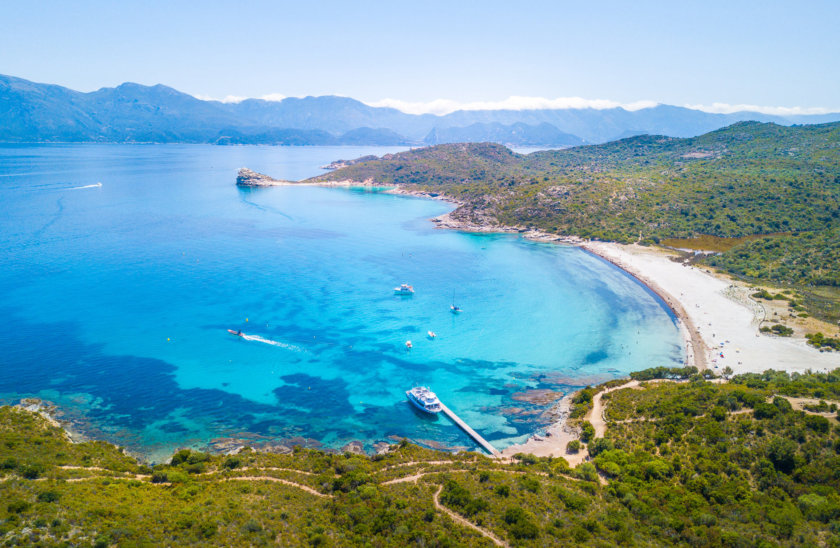
L’Île Rousse is a small seaside resort located between Saint-Florent and Calvi. It’s also a great starting point for an itinerary in Corsica, as you can get there with ferries from Nice, Toulon and Marseille .
Take a walk in the old town and discover the Place Paoli and the Port. From the port, you can also take the lighthouse road to reach Pietra peninsula and its lighthouse. There, you will enjoy a splendid view of L’Île Rousse and the perched villages of Balagne.
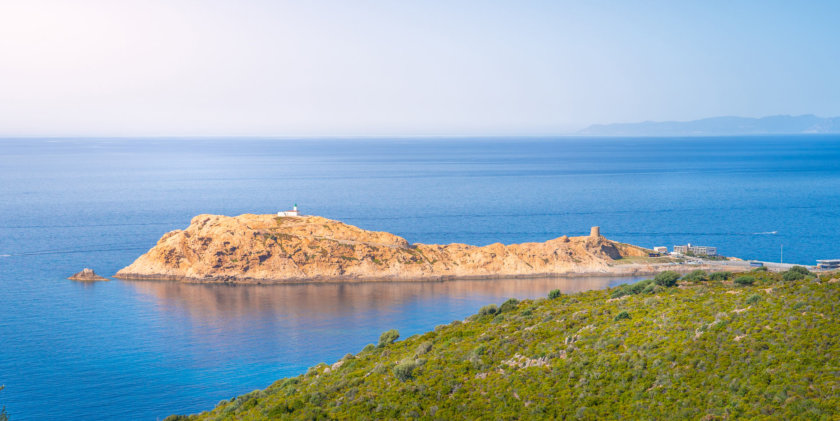
The city of Calvi is another place you should discover during your trip to Corsica.
Calvi must-see places are:
- The church of Saint-Jean-Baptiste
- The former palace of the Genoese governors
- Saint Anthony’s Oratory
- The old town and its paved alleys with many shops and restaurants
- The port and the Quai Landry, also with many restaurants!
- Calvi Beach , a long sandy beach surrounded by a pine forest
And after your stroll, how about trying one of the many nautical activities?
In Calvi, you can choose between paddle, catamaran, windsurfing, kayaking or towed buoy. There are also several diving centres offering first dives.
And if you want more details about the best things to do in Calvi, you should read my article : Visit Calvi : the definitive guide.
If you want to enjoy something different than sunbathing all day at the beach, you should go to the forest of Bonifatu. Located a 30-minute drive from Calvi, this forest offers many beautiful walking trails and natural pools to swim in the river!
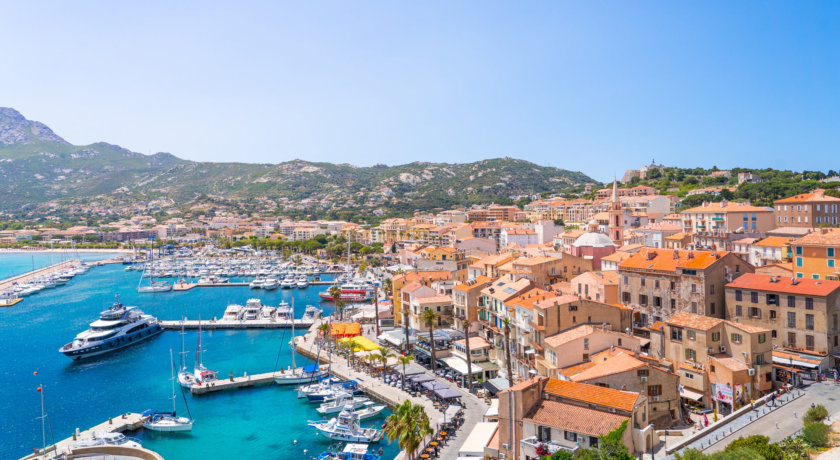
From Calvi, drive to the small village of Moncale, located only 20 minutes away. There, you will reach the beginning of the panoramic road that connects Balagne’s most beautiful villages.
During your tour, you should stop at:
- Zilia, whose spring water is sold throughout the island
- Montemaggiore and its view of the Calvi bay
- Sant Antonio
- The abandoned village of Occi: even if this village is in ruins, the place offers a splendid view of the mountains, Calvi Bay and the Revellata in the distance. You can access Occi by foot, from Lumio or from the “Panoramic Campsite” on the Lavatoggio Road. It’s a great place to enjoy the sunset, but don’t forget to walk down before dark!
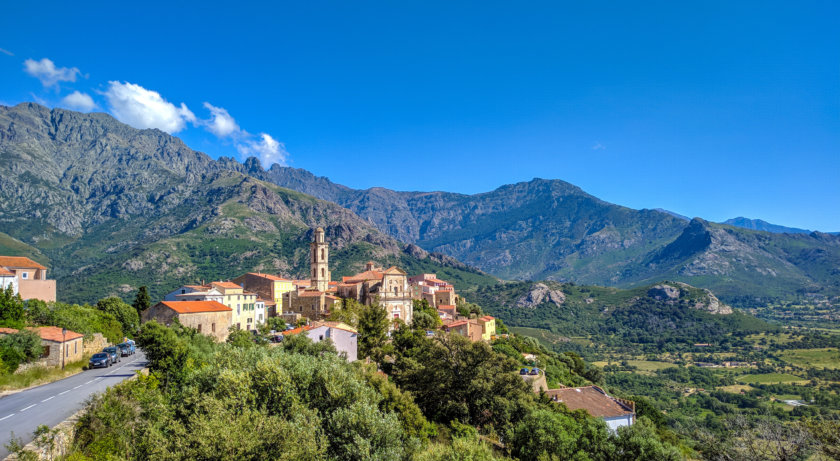
Let’s stay in Calvi’s surroundings to visit a less known tourist site: the Revellata .
The Revellata peninsula is a rather wild area. With its many walking trails, small and quiet white sandy beach and many preserved coves, it’s the perfect place to spend a relaxing day walking, sunbathing and swiming.
And if you want to discover the most beautiful point of view over Calvi bay , drive to the chapel of Notre-Dame-de-la-Serra , located only 5 minutes away from The Revellata.
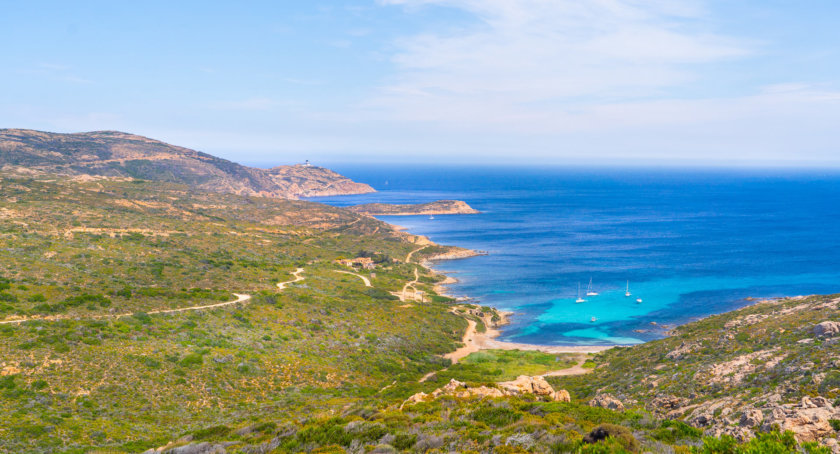
Let’s continue this Corsica travel guide and discover the Fango valley, classified as a natural biosphere reserve by UNESCO.
Located 40 minutes south of Calvi , the place is famous for its many natural pools where you can swim. It’s the perfect place for a relaxing family trip, as you can swim with children and picnic on the river’s shores .
From the valley, you can also enjoy many strolls and hikes of various difficulties.
Nearby, you can also go to the village of Galeria, located a 10-minutes drive from the Fango valley . From there, you can rent a canoe to explore the Fango Delta and discover its amazing wildlife!
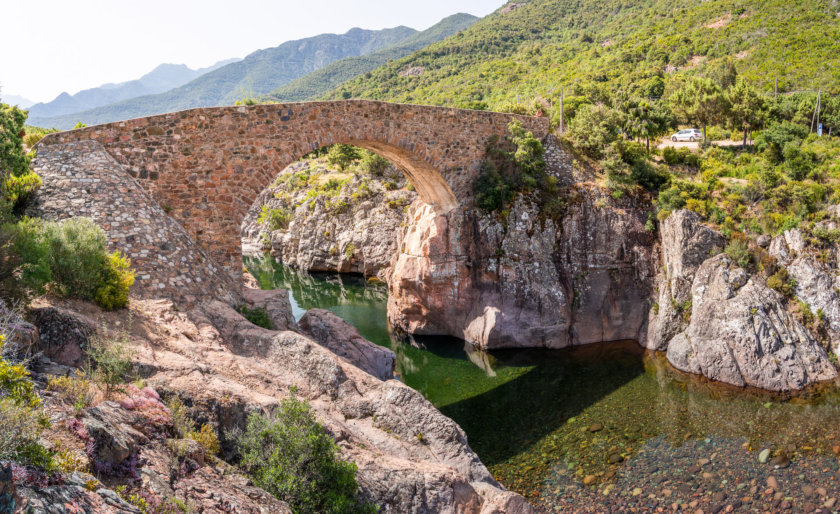
The nature reserve of Scandola is one of Corsica’s must-see attractions.
Scandola reserve is listed as a UNESCO World Heritage Site and hosts an exceptional and well-protected marine and terrestrial wildlife. The only way to reach Scandola is by boat , and it’s strictly forbidden to walk, hunt, fish or dive there.
If you wish to visit the reserve, you will need to go to the small port of Porto, in Corsica. (Not to be mistaken with Porto in Portugal!)
From there, you can choose between many different boat excursions.
All these tours also include a stop in Girolata, a former fishing village only accessible by boat or a hiking trail.
During your tour, you will discover magnificent red volcanic cliffs. Try to spot the ospreys living there!
Click on the button below to book your visit of Scandola and Girolata:
You will find every information you need to visit Scandola in my article Visit Scandola: the 12 best things to do.
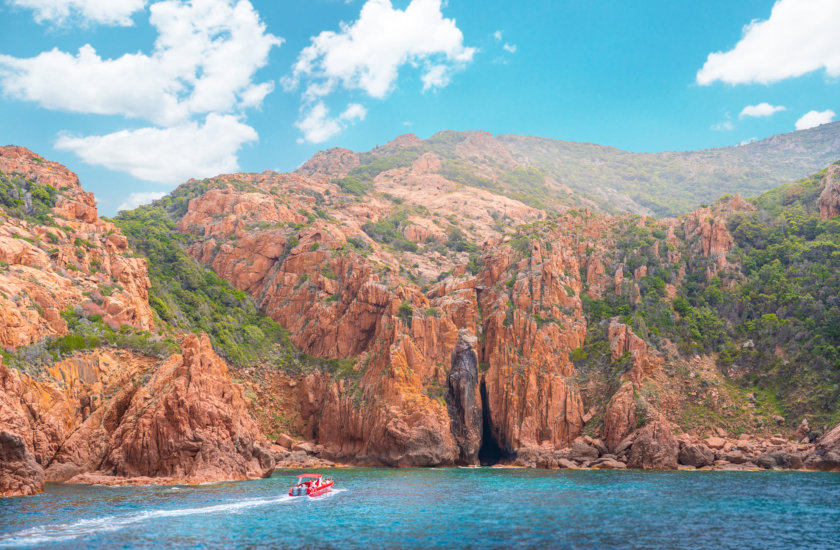
The Calanques de Piana are clearly among Corsica’s most beautiful places .
Going on a boat trip (also departing from the port of Porto ), is the ideal to discover the sublime landscape. You will by amazed by the incredible shapes and colors of its red granite cliffs overlooking the sea!
For more information and to book your boat tour, simply click the button below:
Contrary to Scandola, hiking is allowed in the Calanques. You can choose one of the many walking trails to explore the place and discover the magnificent viewpoints over the Gulf of Porto.
If you want more information about the Calanques de Piana, you should read my detailed article: How to visit the Calanques de Piana?
If you wish to visit the Calanques de Piana and Scandola reserve on the same day, you will need to opt for a 4-hour boat tour.
You can book it right here:
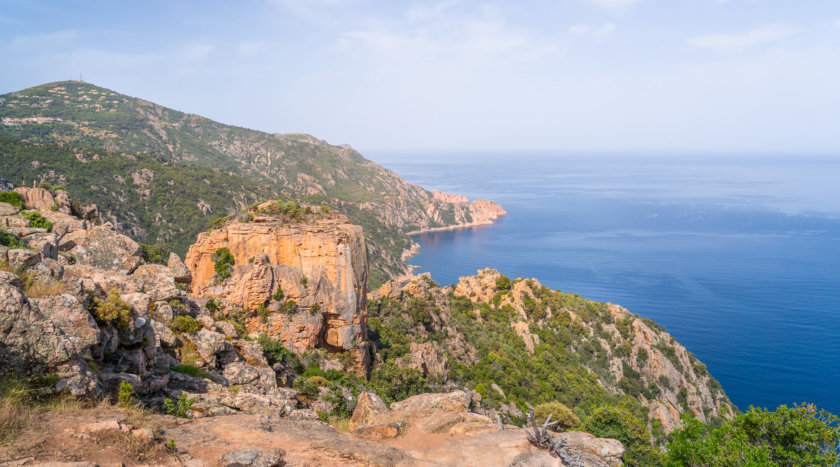
During your trip to Corsica, you should really go on a few hikes! It’s clearly one the best things to do on the island, and the best way to discover the amazing natural landscapes.
There are many hiking trails all over Corsica. Whether you’re in the North, the South, the East or the West of the island, you will always find a trail that suits you!
Here is a short list of Corsica’s most renowned trails:
- The GR 20 , (I’ll tell you more about it in the next paragraph)
- Mare a Mare trails, crossing the island from East to West or vice versa.
- Mare e Monti North, from Calenzana to Cargese
- Mare e Monti South, from Porticcio to Burgu
- The Cap Corse customs officers’ path ( already detailed at #2 )
- Cuscionu Plateau to discover the pozzines
- The many trails in the Calanques of Piana ( already detailed at #11 )
- Lake Nino, starting from Vergio Pass
- The “Cascades des Anglais” trail, where you can discover beautiful natural pools and waterfalls
- Purcaraccia waterfalls
- Spelunca gorge, connecting Ota to Evisa
- Parata and the customs officers’ path leading to Saint Antoine’s beach
- Piscia di Gallu waterfall, in the Ospedale forest
- Bavella pass and the “trou de la Bombe” hike
- Restonica valley to Melo Lake and Capitello.
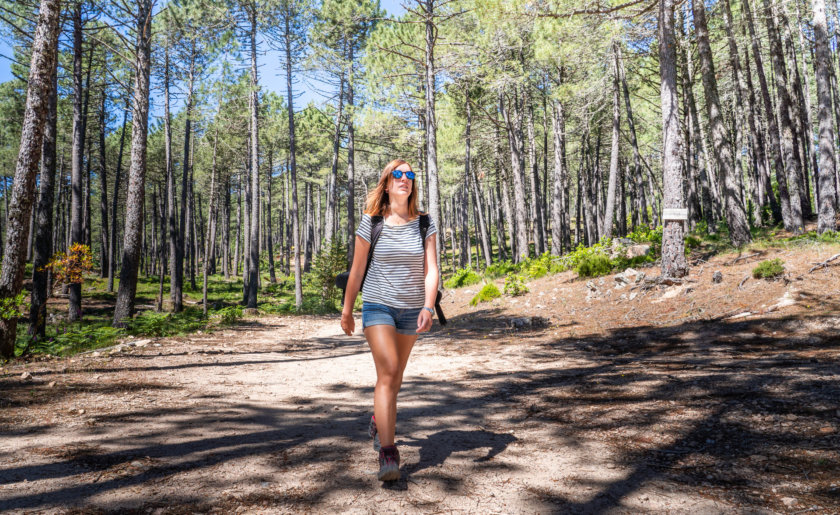
The GR20 is Corsica’s mythical Hiking Trail .
This 200-km long trail crosses Corsica from North to South, between Calenzana and Conca. The road will take you through the mountains, inside Corsica’s Regional Natural Park.
The GR20 is divided in 16 stages (approximately lasting 1 day each). Be aware that this trek is for experienced hikers and requires a good physical condition.
It’s also very important to be well-prepared : study the different stages, book your accommodations and of course use adapted equipment and shoes. Don’t forget that the GR20 is considered as the most difficult hiking trail in Europe .
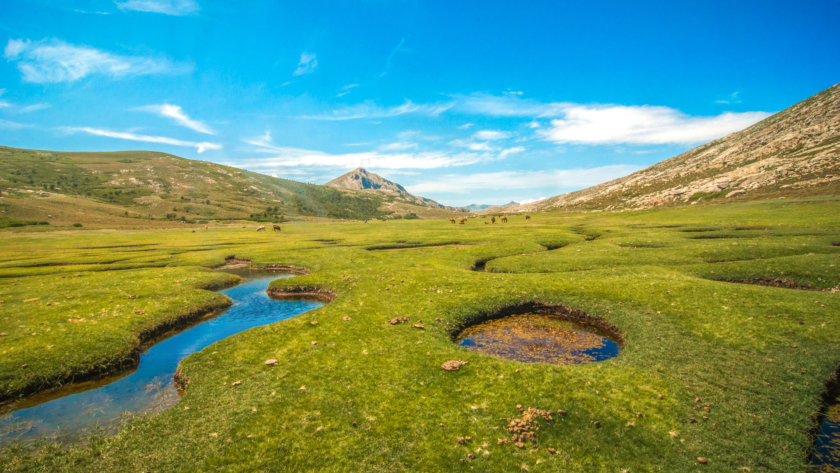
Where can you find Corsica’s most beautiful beaches?
Everywhere!
Corsica is the perfect place if you want to go sunbathing or swimming, as you will find magnificent sandy beaches and coves all around the island.
And even in the mountains, you can find many rivers featuring natural swimming pools to take a dip!
The most famous beaches in Corsica are:
- Palombaggia, located close to Porto-Vecchio , regularly ranked among the most beautiful beaches in the world!
- Rondinara Bay, 20 km away from Porto-Vecchio
- The beaches of Saleccia and Lotu in the Agriates Desert
- Ostriconi Beach, between Saint-Florent and Calvi
- Little Sperone Beach, close to Bonifacio
- The Lavezzi Islands ‘ Beaches, accessible by boat from Bonifacio
- Paragan Beach, also located near Bonifacio
- Roccapina Beach in Sartene
- Arone Beach, located close to the Calanques of Piana
- Mare e Sole and the “Plage d’argent” (“Silver beach”), towards Ajaccio.
If you want to discover Corsica’s best places to swim, you should read my article: The 23 Best beaches in Corsica
The best way to discover Corsica’s most beautiful beaches ( Ostriconi, the Agriates Desert or the best beaches of southern Corsica) is to opt for a VIP boat trip, away from the other tourists!
You have 2 options:
1) Book a private boat trip in Corsica
In my opinion, this is the best way to make the most of your day at sea in Corsica!
You will rent a boat with an experienced skipper that will take care of showing you the most beautiful places of Corsica’s coast.
Motorboat, sailboat, catamaran or even yacht: choose the boat you want to spend a dream day!
As you can imagine, this type of VIP day at sea is extremely popular, so you should rent your boat with skipper as soon as possible. It would be a shame to miss this day because all boats are already rented!
You can find all boats with skipper in Corsica by clicking on the button below:
2) Rent a boat to discover the coast of Corsica
If you have a boat license, your second option for a great day at sea is simply to rent a boat!
To do so, it’s very simple: you just have to click on the button below:
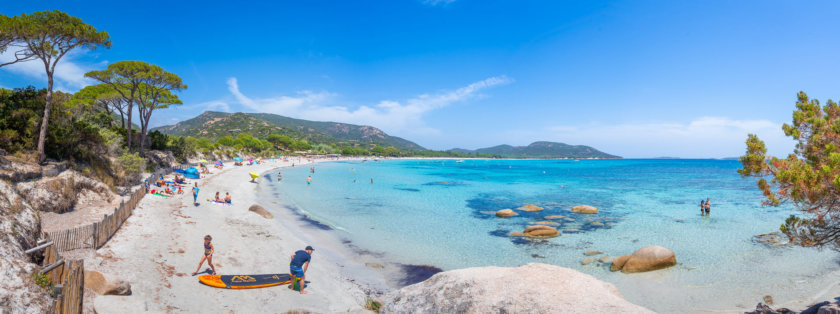
The Spelunca Gorge trail is among the Corsica’s most beautiful and popular walks.
This mule track connects the 2 small villages of Evisa and Ota, located near Porto and the Calanques of Piana.
It takes around 5 hours to do the whole hike: 2 hours down the Gorge from Evisa, and 3 hours to climb back up.
If you don’t feel like walking that much, you can always do the shorter and easier trail, starting from Ota . You’ll walk along the river, then climb up a bit and go down to reach the small stone bridge of Zaglia , classified as a historical monument.
This part of the trail is the most frequented. It takes about 1 hour to do it, if you don’t stop to take photos or for a dip in the river!
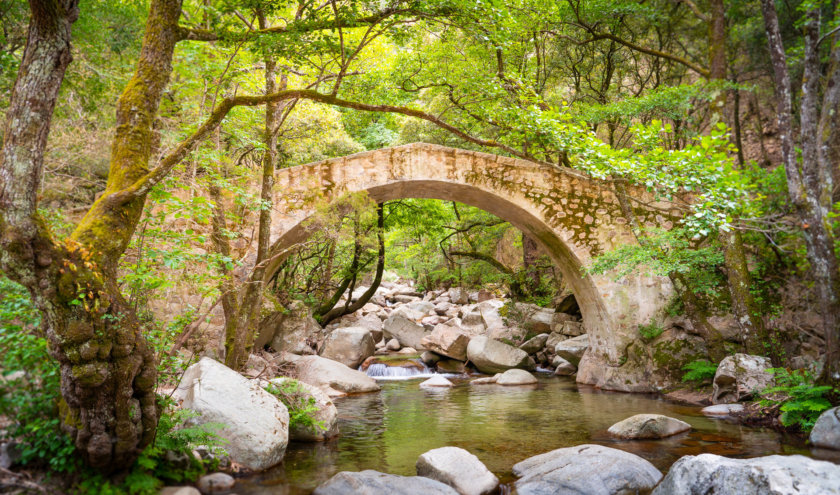
If you want to take a dip in a crystal clear river and enjoy a beautiful preserved nature, then you should definitely visit the forest of Aïtone.
Located only a 40-minute drive from Porto and close to Spelunca Gorge , this magnificent 4000-hectare forest is renowned for its huge hundred-year-old Laricio pines.
There, you can enjoy many walking trails. The easiest reaches the river in only 10 minutes and allows you to swim in beautiful natural pools!
If you want to enjoy a bit of fresh air and beautiful nature, it’s clearly a great place to visit during your holidays in Corsica.
As the place is often crowded, you should go there at the end of the day (around 4 or 5 p.m) to avoid the rush!
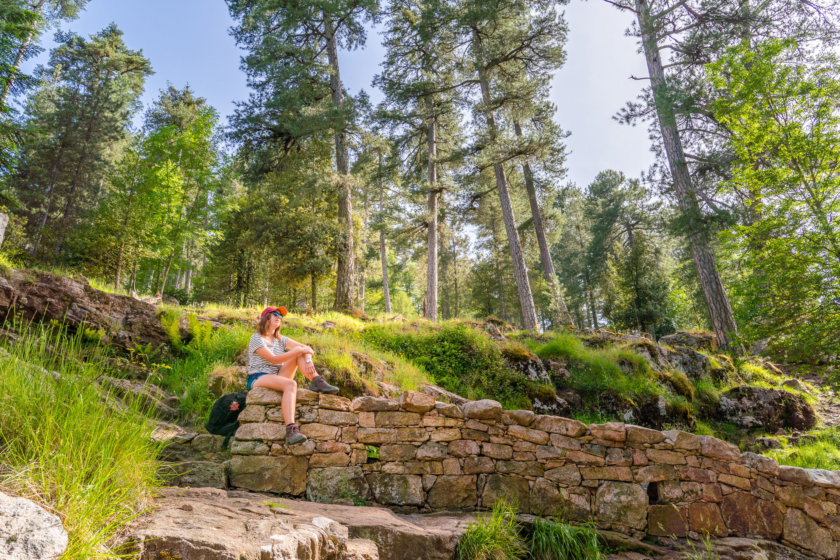
Cargese is a small Corsican village located between Porto and Ajaccio. The most interesting thing about this village is its particular history.
It was built in 1774 as a refuge for a Greek community, whose ancestors had left Greece and Peloponnese to escape the Ottoman domination. About a hundred houses were built for the Greeks, as well as the only Byzantine church in Corsica!
50 years later, as there were more and more Corsican people living in Cargese, a Latin Church was also built. Today, these 2 churches facing each other are the village’s landmark.
From Cargese, you can reach 5 beautiful beaches:
- Chiuni beach
- Menasina beach
- Capizollu beach
- Stagnoli beach
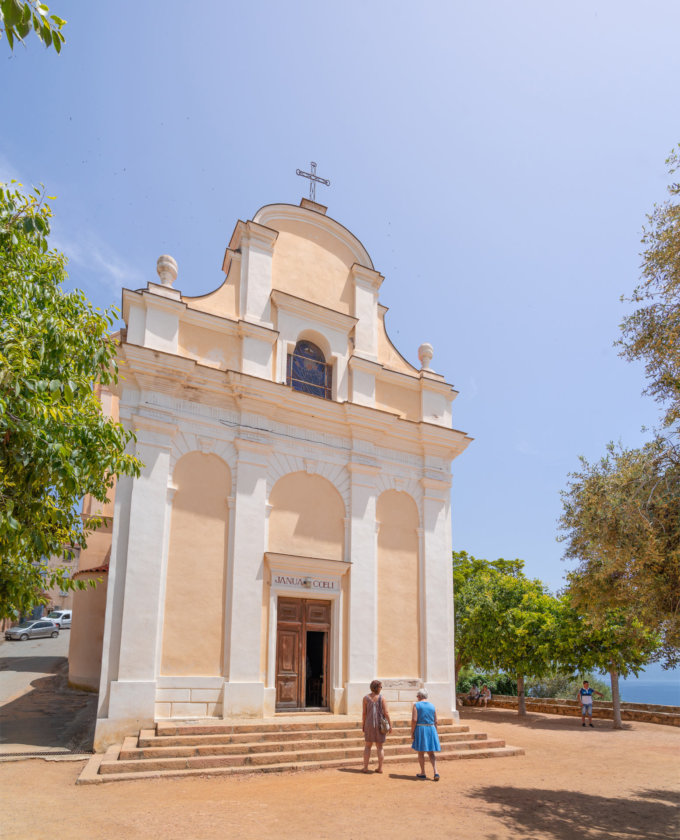
Ajaccio is the island’s biggest city and a must-see tourist attraction during your trip to Corsica.
Here are the best things to do in Ajaccio and its surroundings:
- The traditional market, held every morning on Foch square
- The Bonaparte house where Napoleon spent a part of his childhood
- The Fesch Museum and its collection of Italian paintings
- The cathedral, where Napoleon was baptized
- Bonaparte cave and Austerlitz square
- Parata Point , the best point of view on the Sanguinaires islands
And if you want to go swimming near Ajaccio, you can choose between:
- Marinella beach: the closest beach to the city, always very crowded!
- The beach of Terre Sacrée, a pretty beach with big rocks at the water’s edge
- Capo di Feno beach, a large wild beach
You want to learn more about the best things to do in Ajaccio? Have a look at my article Ajaccio: the definitive guide.
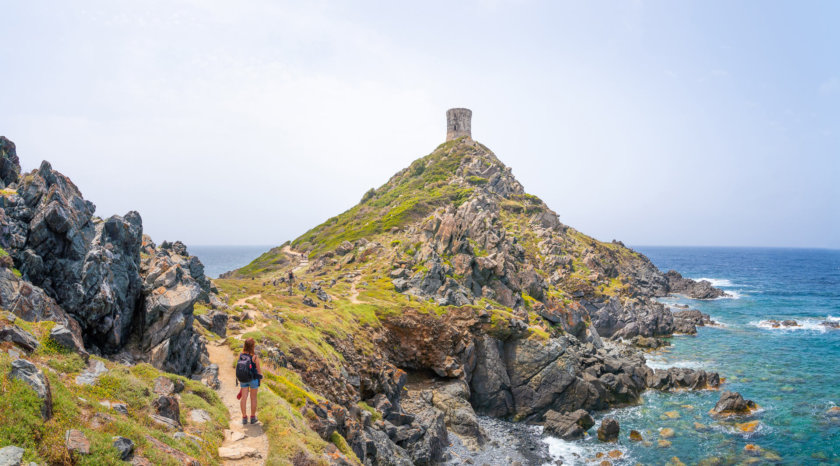
Propriano is located between Ajaccio and Bonifacio .
In this famous seaside resort, you can enjoy many restaurants and shops. Propriano is also the starting point of many full-day boat trips to the Sanguinaires Islands, and even to Scandola nature reserve.
Close to Propriano, you can enjoy Portigliolo beach , a huge wild beach located at the mouth of a small river. You can also reach the unspoilt natural site of Campomoro .
There, you will find several marked trails along the seaside, as well as small wild coves for your swimming breaks!
And, if you’re looking for a thrilling experience, the skydiving school is waiting for you! Would you dare to jump from a plane flying at more than 4000 meters of altitude?
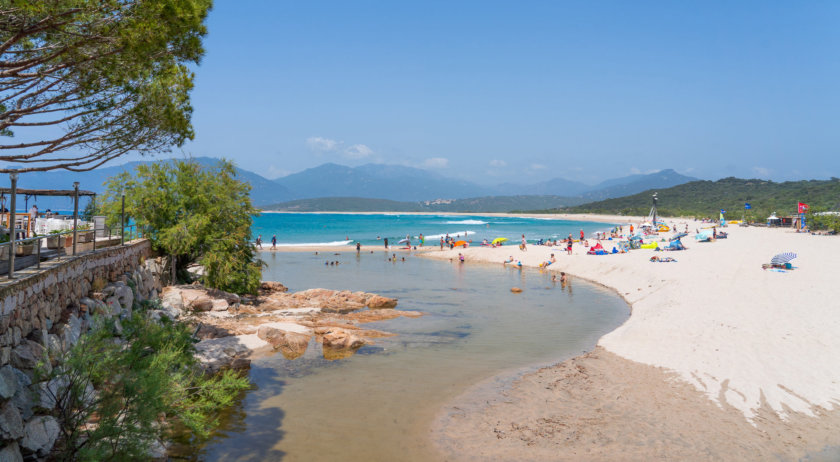
Let’s continue this Corsica travel guide with Sartene, a typical village with beautiful stone houses .
Start your tour at the central Liberation Square , where Sainte-Marie church is located, and walk down the paved alleys to discover the old town .
The village is rather small and often crowded (as many tourist buses stops here), but also very pretty!
And if you want to learn more about the village’s history, you can rent an audio guide for 5€ at the tourist office.
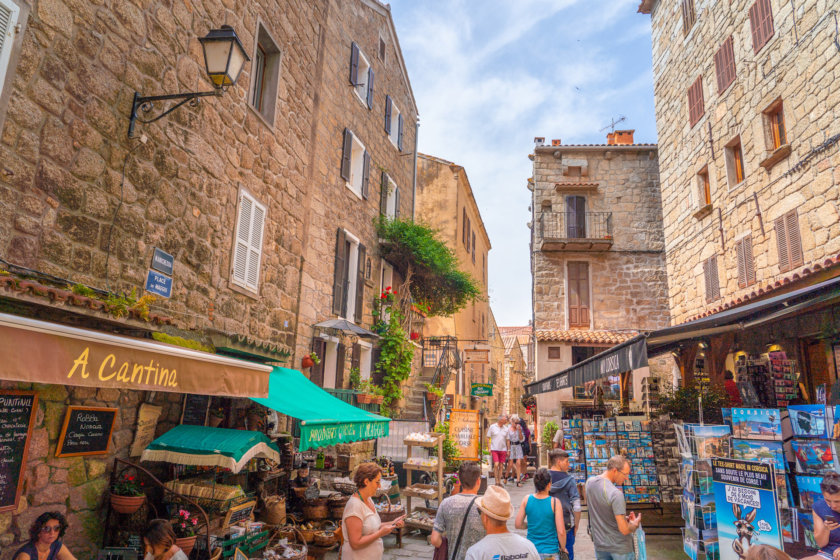
Bonifacio is clearly one of the must-see cities in Southern Corsica.
While preparing your trip to Corsica, you have probably seen the photo of Bonifacio houses, perched on top of a white cliff, overlooking the sea. It’s clearly one of the island’s most iconic picture.
Located in the extreme south of Corsica, Bonifacio and its surroundings offers splendid panoramas , and beaches ranked among Corsica’s most beautiful. That’s why you should definitely spend a few days in Bonifacio during your stay!
What are the best things to do in Bonifacio, Corsica?
- Take a stroll in the Citadel
- Visit the Fortress of the Standard
- Go down King of Aragon’s staircase
- Do a boat tour to see the city from the sea and discover the nearby marine caves
- Follow the path from “Col Saint Roch”, the perfect spot if you want to take pictures of Bonifacio’s cliffs!
- Enjoy a drink on a sunny café terrace on the port, and admire the yachts
- Take a walk to Pertusato lighthouse and Saint-Antoine beach
- Go to Lavezzi Islands
- Enjoy the magnificent beaches of Petit and Grand Sperone , ranked among the island’s most beautiful.
You can find detailed information about Bonifacio in my article: The 20 best things to do in Bonifacio .
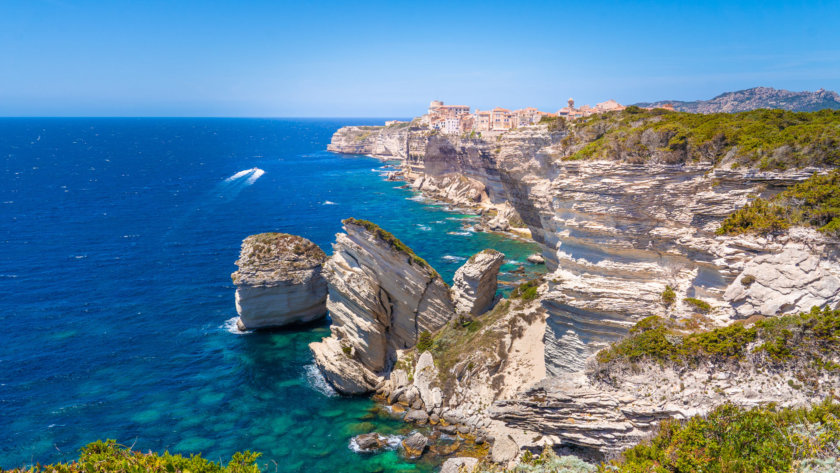
The Lavezzi Islands are clearly among the best places to see around Bonifacio.
It takes only 30 minutes by boat to reach the islands from the port of Bonifacio. There, you will enjoy splendid coves and beaches. The program of that day will be very simple: swimming, sunbathing and relaxing!
You can also walk all around the island.
Even if it’s supposed to last only 1 hour, you should count at least 2h30, as you will stop many times to take pictures and enjoy the panorama!
In my opinion, “Chiesa” is the island’s most beautiful beach . It offers a splendid scenery, with huge rocks and turquoise water. It’s also one of the quietest places on the Islands, as you can’t access it by boat.
You will find every information you need to visit the islands in my article: How to visit the Lavezzi Islands?
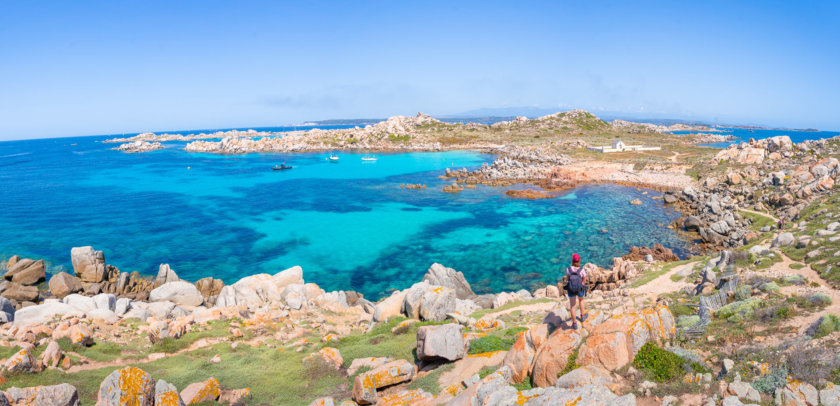
What are the best places to visit in Porto-Vecchio, in Southern Corsica?
I must warn you: the city itself isn’t that interesting. It has a pleasant but very tiny old town, and there isn’t much to do!
In fact, most people come to Porto-Vecchio to enjoy the sumptuous beaches of the surroundings.
Here are the 5 most beautiful beaches around the city:
- Rondinara Beach
- Santa Giulia Beach
- Palombaggia Beach
- Tamaricciu Beach
- Pinarelllu Beach
It can be difficult to choose one, as they all offers white sand and crystal clear water. You will have to try all of them to make up your mind!
And if you want to enjoy something different, you should go to Cavu Valley.
The river offers beautiful natural swimming pools . It’s really a great spot if you’re visiting Corsica with children!
You will find every information you need to visit Porto-Vecchio area in my article: The 17 best things to do in Porto-Vecchio.
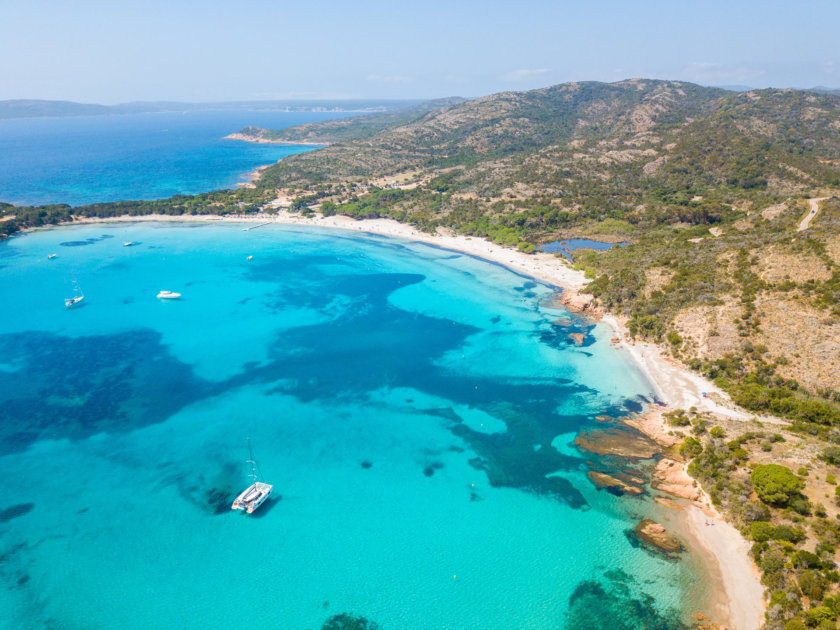
Located North of Porto-Vecchio , the Ospedale forest is another place you should visit during your trip to Corsica.
The road to get there offers beautiful views over the Porto-Vecchio Bay .
On the way, you will also discover the Ospedale Lake, located in the middle of the mountains. It reminded me a bit of Canada !
From the Ospedale, a 2-hour hike takes you to Corsica’s largest waterfall: the Piscia di Gallu. Be careful, as the last part of the trail is very steep.
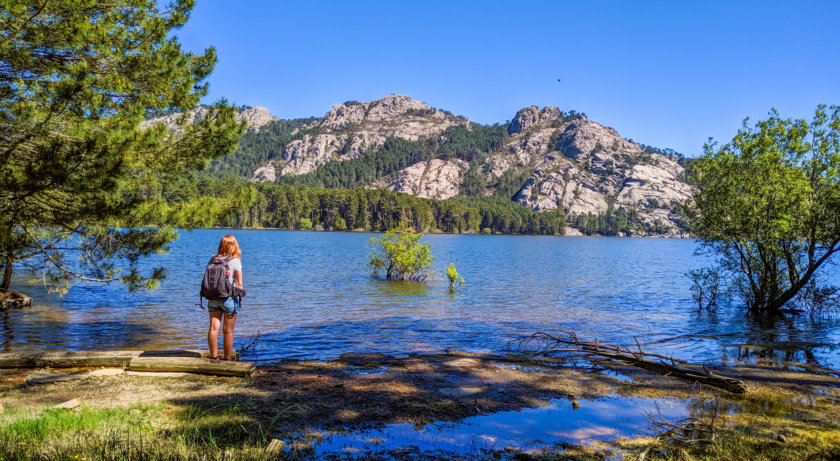
The “ Aiguilles de Bavella” are another famous tourist site in Corsica, and one of the best places to hike on the island.
From the Bavella Pass, located in the Regional Natural Park of Corsica, you can choose between several marked trails. During your walk, you will enjoy beautiful panoramas over the rocky peaks.
The most famous hike is the “Trou de la bombe” (literally “Bomb Hole”).
This 2h30 easy hike in the shade of a pine forest takes you to a natural geological formation, a 8-meter diameter hole (named tafonu in Corsican) carved into the cliffs, overlooking a huge ravine.
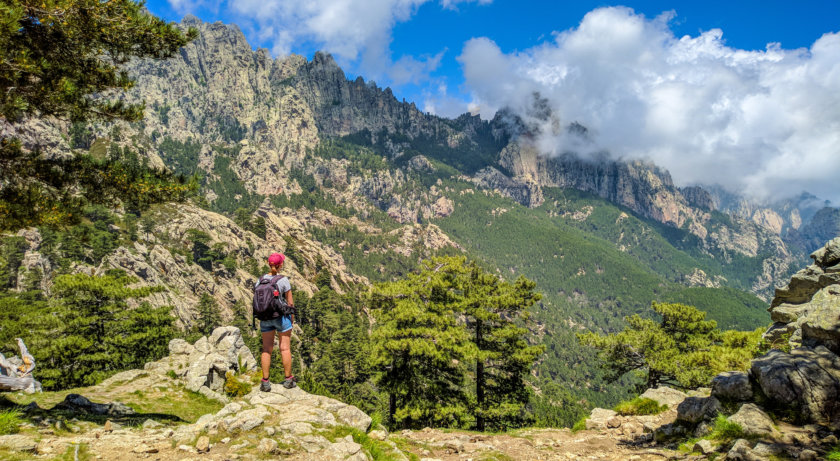
Let’s continue this list of Corsica’s best points of interest with the city of Corte .
Located at the heart of the island , Corte is home to Corsica’s only university. It has therefore more students than inhabitants!
When visiting Corte , the main place to discover is its old town . Divided into an upper and a lower town, it’s definitely the most interesting part of the city!
During your visit, you should go to:
- The belvedere dominating the city
- The citadel, where you will find the Regional Museum of Anthropology . There, you will discover a collection of ancient objects, picturing the Corsican way of life through the ages.
You can find every information you need to visit Corte and its surroundings in my article: The 20 best things to do in Corte.
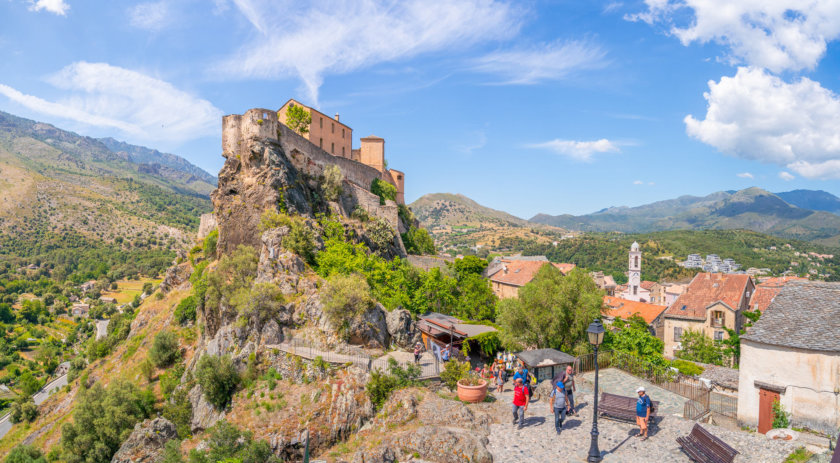
If you want to discover the Asco Valley, you first have to drive to Ponte-Leccia. There, take the D147 road and drive along the gorges for about 10 kilometers. As you drive along the river, you can stop for a swim whenever you want!
The Genoese Bridge , classified as a historic monument, is one of the Asco Valley’s most famous places.
This beautiful ancient bridge is located below the village of Asco. The place is also famous for its large natural swimming pool, perfect if you want to take a dip!
From the ski resort of Haut-Asco , you can also climb the 2,706 meter-high Monte Cinto, Corsica’s highest peak. This hike is for experienced hikers.
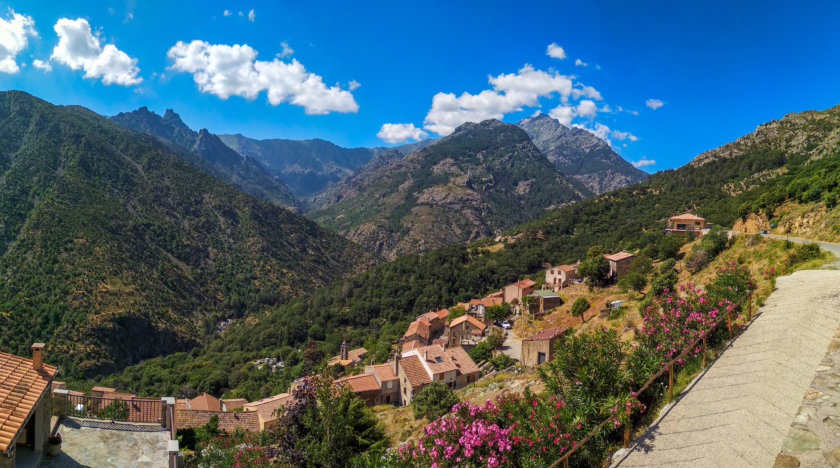
The Restonica Gorge trail is among Corsica’s most famous hikes.
This trail starts at the “Bergeries de Grotelle” (“Grotelle Sheepfold”), located 16km away from Corte. There, follow the path to reach Melo Lake, at 1,711 meters of altitude. And if you’re still motivated, you can continue up to Capitello Lake, at 1,930 meters.
The round-trip to Melo Lake takes around 3 hours, and you can add 1.5 hour if you decide to go to Capitello.
After your hike, you can relax and swim in the many natural pools in the gorge!
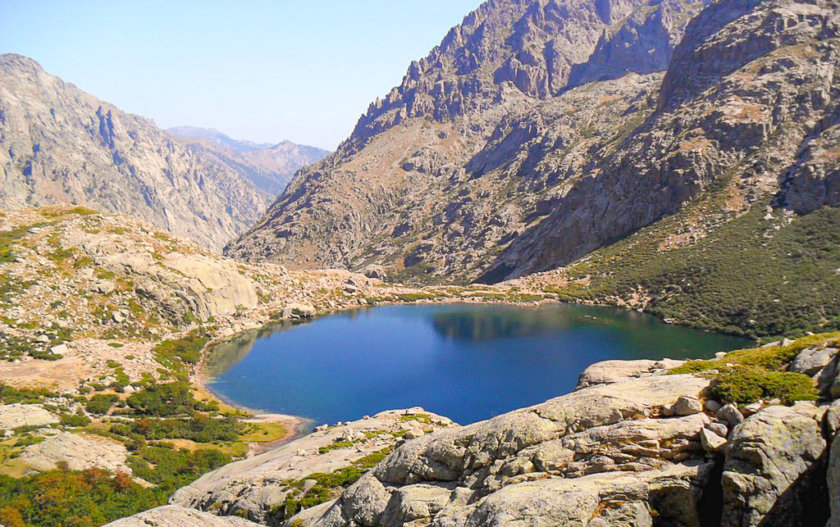
Eastern Corsica is really less touristy than the rest of the island, as the main cities and tourist attractions are located on the West Coast and near the Cap Corse.
Howerver, there are still a few points of interest you can visit if you’re in the East:
- The archeological museum and the ancient site of Aleria , Corsica’s first city, founded in the 6th century
- The Pond of Diane, producing the island’s best oysters
- Padulone beach (the side close to the Pond of Diane is wilder)
- Pinia beach, located near Ghisonaccia
- The Côte des Nacres, from Solenzara to Fautea, where you can enjoy many sandy beaches
- The many hiking trails starting from Piedicroce
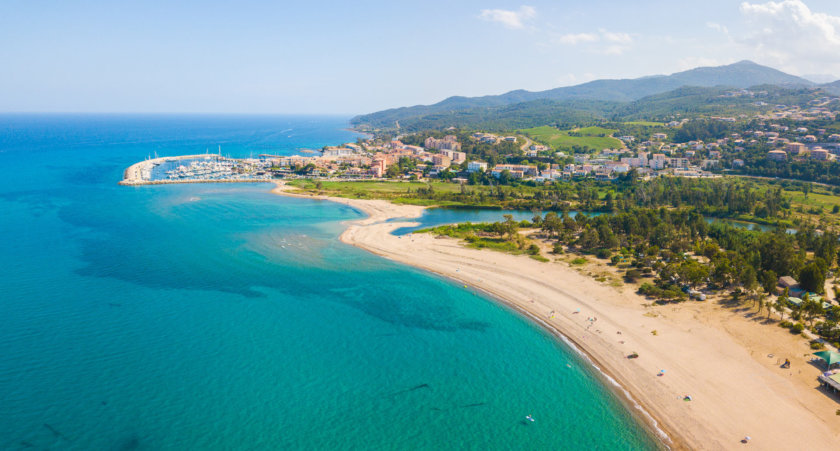
During your stay in Corsica, you should definitely go diving .
Whether you are a beginner or an experienced diver, there are diving sites for everyone in Corsica!
Corsica’s most beautiful diving sites includes:
- Revellata peninsula, next to Calvi
- The wreckage of the B-17 bomber , an American plane shot down by the Germans, near the citadel of Calvi
- The Gulf of Porto
- The Cathedrals, towards Ajaccio
- Punta Locca, near Liamone beach
- Circus Marifaja
- Pecorella Shipwreck, a small cargo that sank next to Porto-Vecchio
- Merouville, in the Lavezzi Islands’ nature reserve
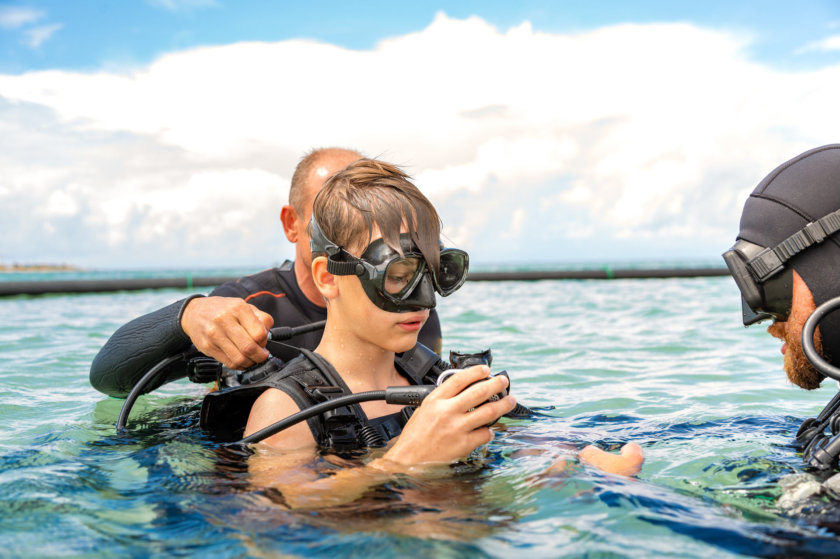
With its many beaches, mountains, canyons and rivers, Corsica is the perfect place to enjoy a wide range of outdoor activities!
You should really try some of them during your stay.
Here is a list of the activities you can practice all over the island:
- Canyoning: the most famous canyons are Richiusa canyon, Verghellu canyon and Zoïcu.
- Quad biking in Calvi (click here to book) , in the Agriates desert or towards Bonifacio
- Boat trips to Cap Corse, Saint-Florent, Porto, Bonifacio or the Lavezzi Islands
- Tree climbing: the biggest adventure park is located in Vero, a small village on the heights of Ajaccio
- Kayaking, for example at Pianterella beach, close to Bonifacio
- Climbing: the most famous spots are in Balagne region + The Restonica Valley and the Aiguilles de Bavella
- Paragliding, in Ajaccio, Calvi and Saint-Florent
- Horseback riding
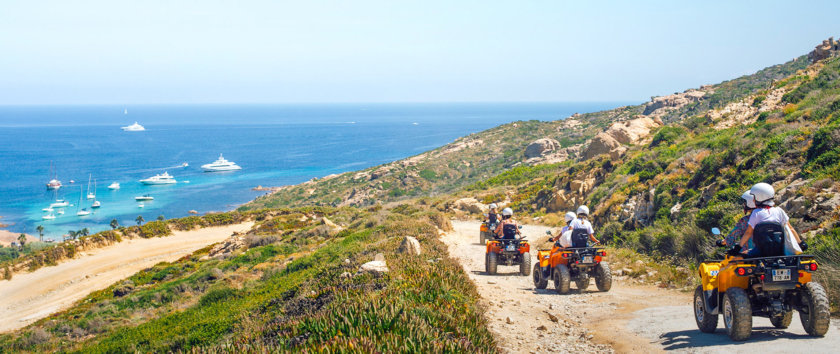
If you want to enjoy something different than visiting Corsica by car or motorcycle, you should definitely try a train ride.
The Corsican train, affectionately nicknamed the Trinichellu (“the little jiggling train”, literally) by the locals, is a unique experience. During your journey, you will discover beautiful landscapes you can’t access by car.
You can choose between 2 lines: from Bastia to Ajaccio and from Calvi to Ajaccio .
Both are crossing the regional natural park of Corsica. Don’t hesitate to stop whenever you want! The Trinichellu’s particularity is that you can get off at a stop, visit or take a stroll, then get back on the next train.
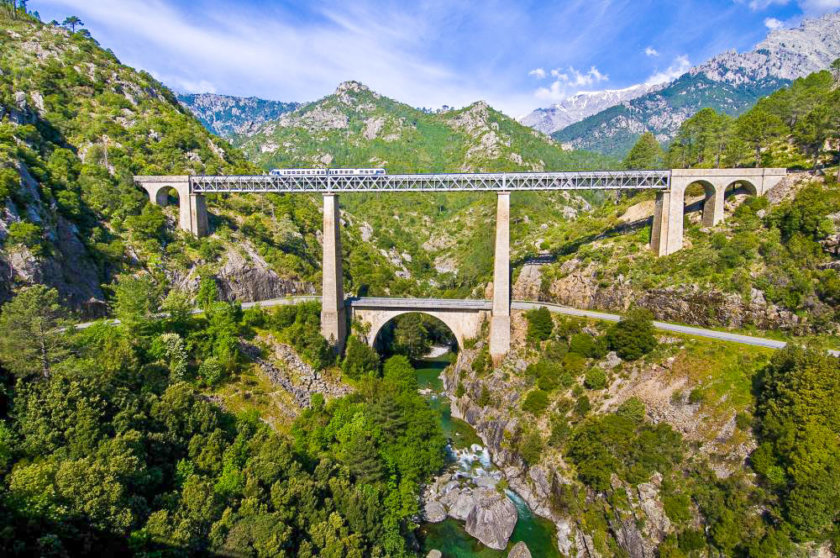
While visiting Corsica, you will have plenty of time to discover some of the best local specialties:
- Brocciu, a local sheep or goat cheese. You should really try the cannelloni with brocciu, or the brocciu donuts, it’s delicious!
- Figatellu, a fresh sausage made from pork liver
- Lonzu, a pork-based delicatessen
- Fiadone, the traditional Corsican dessert: a lemon-flavored brocciu flan
- Pietra, the famous Corsican beer
- Pulenta, the Corsican chestnut flour used in many traditional cakes and pancakes recipes
- Canistrelli, small biscuits with a lemon, anise or hazelnut flavor (and you can find many more!)
- Stir-fry veal with olives and pasta
- Herb pie , a puff pastry filled with chard
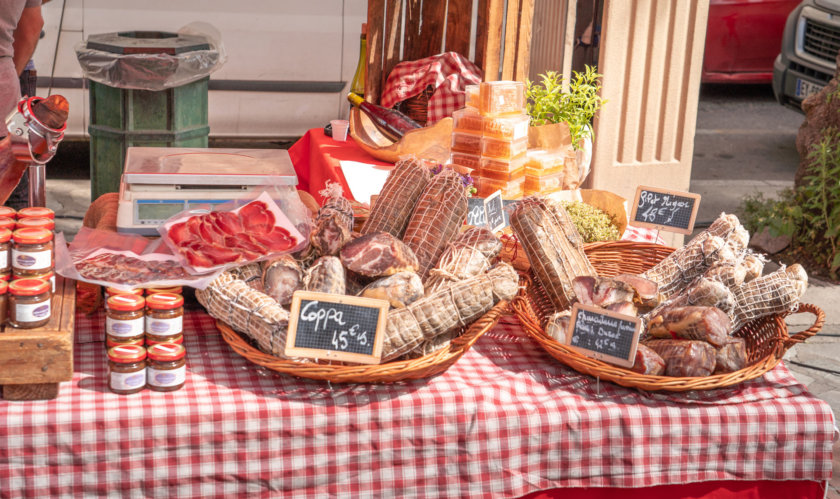
If you are a wine enthusiast, you certainly know that Corsica produces excellent wines . There are 9 PDO (Protected Designation of Origin) on the island :
- Coteaux-du-Cap-Corse
- Muscat-du-Cap-Corse
- Porto-Vecchio
- Corsica (East Coast)
The island’s largest vineyards are often offering wine-tasting tours, and most of these wines are also available in the island’s restaurants. You will find every information you need about the different wineries in the tourist offices.
If you want to enjoy some excellent wine, don’t hesitate to visit vineyards during your itinerary in Corsica!
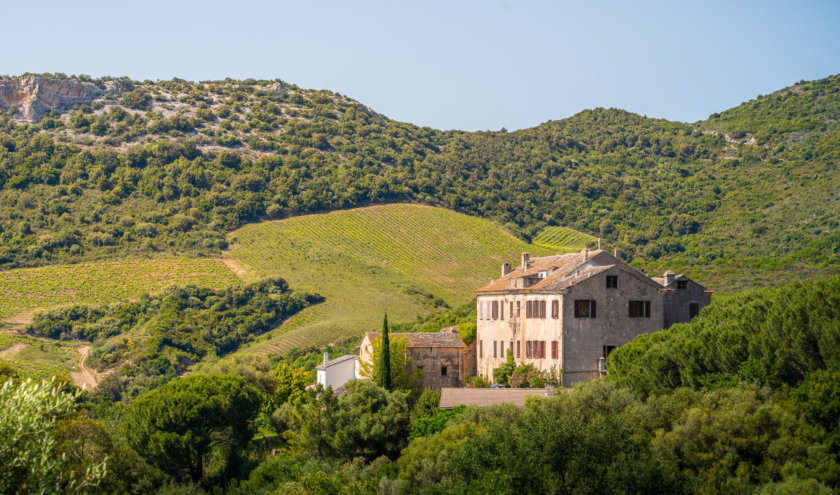
It’s now time to finish this list of the 35 best things to do in Corsica with the “Route des Sens Authentiques” .
While doing your road trip in Corsica , you will sometimes find blue “Route des Sens” road signs. You clearly can’t miss them!
They always indicates traditional workshops and farms you can visit to discover the Corsican craftsmen skills and the best local products.

And you, what do you plan to visit during your trip to Corsica?
On Voyagetips.com , I give you all my best tips and itineraries to plan your trip to Corsica by yourself. (All my Corsica articles are here)
However, if you prefer to book a Corsica tour with a travel agency , I recommend you to check the 10 best Corsica tours by clicking the button below:
I have made a tourist map of Corsica for you , to help you picture what the island looks like and where the best places to visit are located. You can display the map legend by clicking on the top left button (the one with a little arrow).
How to get to Corsica?
Corsica has 4 international airports :
- Figari (near Porto-Vecchio)
As always, you should book your plane tickets as early as possible to get the best prices. You have to know that the flight prices to Corsica can vary a lot throughout the year!
So to check the rates and schedules, you can use our flight comparator, in partnership with Skyscanner:
You can also take the Boat to Corsica from the French cities of Toulon, Nice and Marseille, or from Italy.
If you want to rent a boat for a nice day at sea during your stay in Corsica, you should book it with Samboat.
Motorboats, sailboats, yachts, small boats without a license, with or without a skipper: they simply have the most complete offer for boat rental!
So, what are you waiting for to book your boat trip in Corsica? 😊
Discover all my articles about Corsica : All my articles to help you plan your trip to Corsica are listed there.
- Itinerary: 10 days in Corsica – The best 10 days itinerary in Corsica
- Road trip in Corsica – The best itineraries for 2, 3, 4, 5, 7, 10, and 15 days
- Ajaccio: The 20 Best things to do
- Bastia: Top 17 places to visit
- Bonifacio: Top 20 things to do and see
- Calvi: The 15 things you must do!
- Cap Corse: The 15 must-see attractions
- Corte: 20 things to do and see
- Porto: Top 12 things to discover
- Porto-Vecchio: Top 17 things to do and must-see attractions
- Saint-Florent: The 12 best things to do
- Agriates Desert – The definitive guide
- Calanques de Piana – How to visit the Calanques de Piana by boat, by car and on foot
- Lavezzi Islands – Oganize your trip to the Lavezzi island easily!
- Scandola Nature Reserve – All my best tips to visit Scandola
- The 23 Best Beaches in Corsica : The definitive guide to the most beautiful beaches!
- Where to stay in Corsica? My guide of the best hotels, ordered by cities and budget
You’re using Pinterest? Here is the picture to pin!
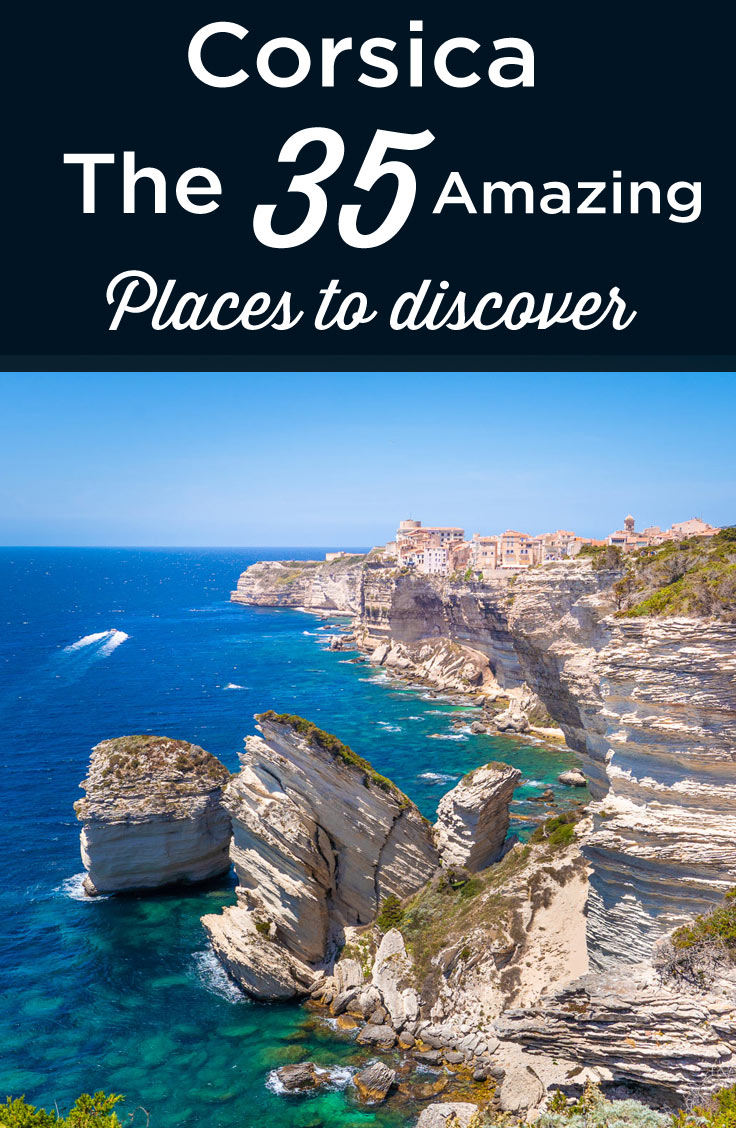
Creator of the Voyage Tips blog, travel and photography lover. I give you all my best tips to plan your next trip.
Related Stories
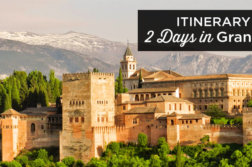
2 Days in Granada: The Perfect Itinerary (First Time Visit)
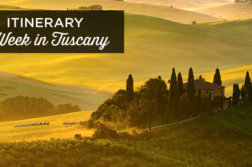
One week in Tuscany: Epic 6-7-8 Day Itinerary (First Time Visit)
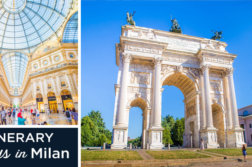
4 days in Milan: the perfect Itinerary (first time visit)
Leave a reply cancel reply.
Your Name (required)
Your Email (required)
Your Website (optional)
Save my name, email, and website in this browser for the next time I comment.
- Middle East
- North America
- Cheap car rentals: my best advice
- Back to Homepage

17 Top-Rated Attractions & Places to Visit in Corsica
Written by Lisa Alexander Updated May 3, 2023 We may earn a commission from affiliate links ( )
With its stunning seaside scenery, expanses of pristine forests, and soaring snowcapped mountains, Corsica lives up to the label, "Island of Beauty." Along the coast are attractive port towns, and the hillsides are dotted with picturesque villages.
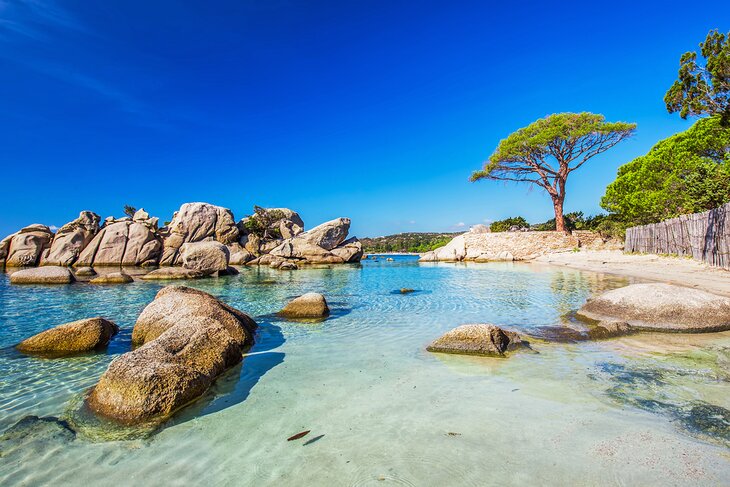
Corsica offers no shortage of things to do. This idyllic island is a paradise for beach lovers , hikers, and outdoor sports enthusiasts. The island boasts some of Europe's most inspiring rugged landscapes and a 1,000-kilometer shoreline with translucent waters, perfect for snorkeling or scuba diving.
Although Corsica has been part of France since 1769, the island has its own culture. Donkeys still roam the countryside; the music is unique; and the cuisine features distinctive specialties, such as strong spicy cheeses, chestnut polenta, and chestnut cookies.
Discover the best places to visit on this enchanting island with our list of the top tourist attractions in Corsica.
2. Bonifacio
5. cap corse, 6. sant'antonino, 8. beaches near porto vecchio, 9. village of piana and calanques de piana, 10. castagniccia region, 11. réserve naturelle des bouches de bonifacio, 12. belgodère, 13. réserve naturelle de scandola, 14. désert des agriates, 15. extreme hiking on the gr20 trail, 16. col de bavella, 17. forêt de valdo niello, map of attractions & places to visit in corsica.
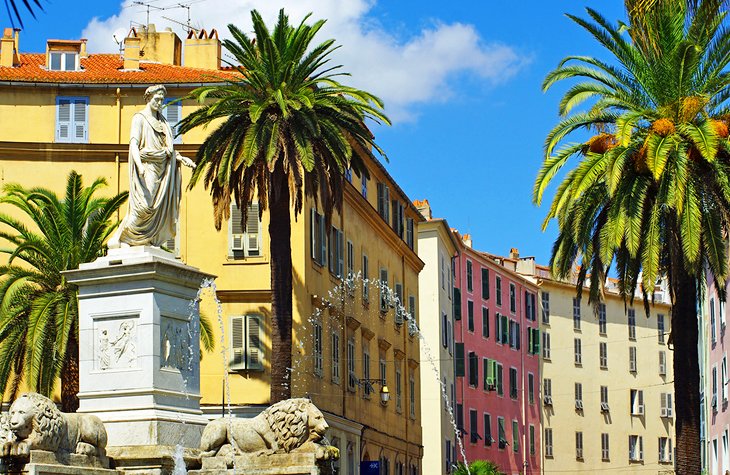
Corsica's most famous native son, Napoléon Bonaparte, was born in this bustling capital city, pleasantly situated on the Gulf of Ajaccio. Sensational views of the sea can be admired from various spots throughout the town.
At the center of Ajaccio is the Place de Gaulle , a grand square with an equestrian statue of Napoléon I (created in 1865 by Viollet le-Duc).
Next, visit the Musée National de la Maison Bonaparte (Rue Saint-Charles) to see the house where Napoléon I was born. The Bonaparte family lived here in the late 17th century and the 18th century. In the 19th century, Napoléon III inherited the house and refurbished the decor. Today, the Maison Bonaparte is classified as a Monument Historique and presents portraits, memorabilia, and family documents.
Continue your discovery of the Napoleonic era at the Palais Fesch (Musée des Beaux-Arts). The Collection Napoléonienne galleries display imperial portraits of Napoléon I and Napoléon III (both were titled "Emperor of the French") as well as medallions and coins that depict Napoléon I and Napoléon III.
The old town of Ajaccio is also worth exploring. Spend some time wandering around to discover the historic charm within its maze of winding, narrow streets.
Not to be missed in the old town is the 16th-century Cathédrale d'Ajaccio (Cathédrale Notre-Dame de l'Assomption), where Napoléon Bonaparte was baptized in 1771. The cathedral's most noteworthy work of art is the La Vierge au Sacré Côur painting by Eugène Delacroix.
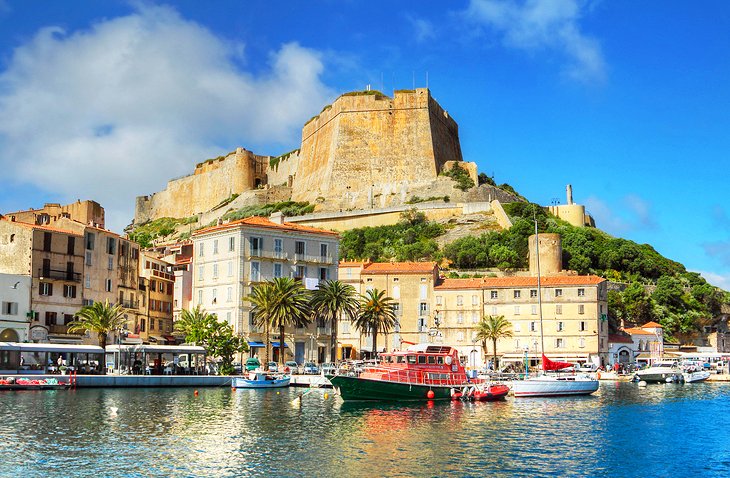
Bonifacio is a well-preserved fortified town perched on a steep limestone cliff with stunning sea views. Brimming with old-world ambience, the town is a jumble of medieval lanes and narrow alleyways.
At its heart is the 12th- to 13th-century Eglise Sainte-Marie-Majeure , a Romanesque church with early Gothic elements. Also worth visiting is the 13th-century Eglise Saint-Dominique, which has an austere facade and a simple interior.
Bonifacio is found within Corsica's largest nature reserve, the Réserve Naturelle des Bouches de Bonifacio, which encompasses limestone cliffs, seaside grottos, and the Lavezzi Islands.
Near the town are numerous beautiful beaches. Another destination within easy reach of Bonifacio is the port of Santa Teresa di Gallura in Sardini, just a one-hour ferry ride away.
Read More: Best Beaches in Corsica
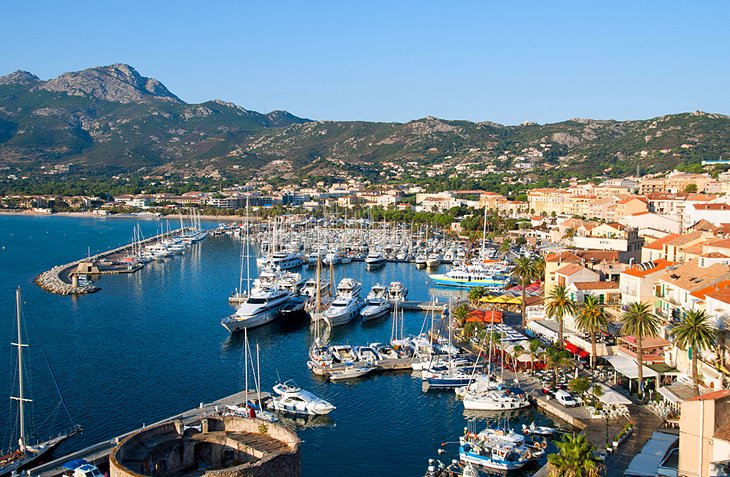
This sun-drenched waterfront town has an attractive marina and beautiful beaches along the Bay of Calvi. Soak up the marvelous scenery of the deep blue Mediterranean Sea, with jagged mountains framing the harbor.
Besides sunbathing, swimming, and spending time at outdoor cafés, a top attraction is the Citadel of Calvi . Enter the ancient walled Citadel and you'll find a cluster of medieval cobblestone streets and staircases that lead to discoveries of pleasant squares, historic churches, and fabulous views.
Within the Citadel, the 13th-century Cathédrale Saint-Jean-Baptiste exemplifies Corsican Baroque architecture. The interior features noteworthy works of art, including a 15th-century altarpiece depicting the Annunciation and a 16th-century Virgin of the Rosary statue from Spain.
Calvi is also renowned for its summertime jazz festival, which draws top musical talent. The Jazz in Calvi festival takes place annually at the end of June; performances are held at the Citadel and other venues.
Read More: Top-Rated Beach Destinations in France
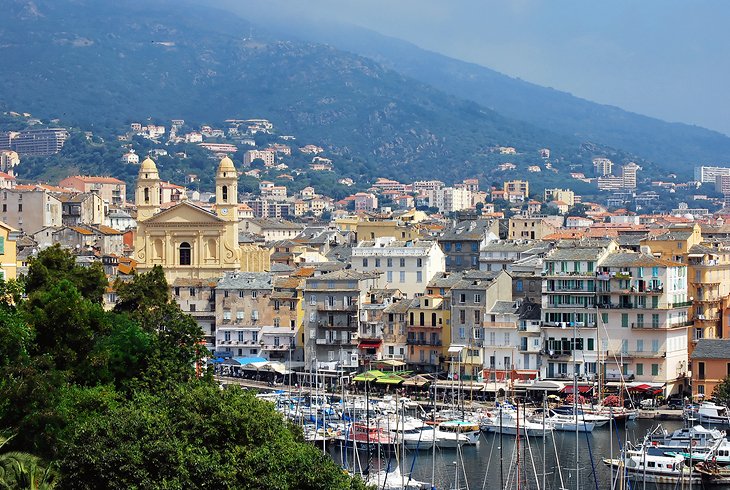
If you want to experience the real Corsica, this lively seaside city is the place to go. Bastia has a picturesque harbor and a quaint Old Town (Terra Vecchia) bursting with narrow lanes and tightly packed houses.
Within the Terra Vecchia are several noteworthy churches: the 17th-century Eglise Saint-Jean-Baptiste, the largest church in Corsica; the Baroque Chapelle de l'Immaculée Conception; and the Chapelle Saint-Roch, which overlooks the mesmerizing Mediterranean waters.
On a rocky spur to the south of the harbor is the ancient citadel, dating back to 1378.
Read More: Best Places to Visit in France
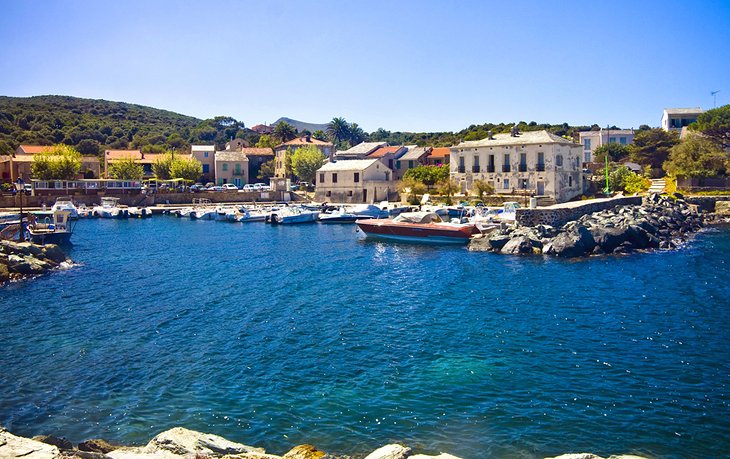
At the northernmost tip of Corsica, the Cap Corse peninsula is one of the prettiest areas of the island. The peninsula is covered by a range of foothills and fertile valleys where vines, fruit, and olives grow.
Dotting the landscape are medieval perched villages such as Pino on a wooded hilltop; Nonza clinging to a cliffside; and Rogliano, which is a collection of hamlets and old fishing ports. Rogliano encompasses Erbalunga near Bastia; Macinaggio, with a yacht marina; and Centuri , a tiny fishing village with a working harbor.
If you prefer sunbathing to sightseeing, then head to the Plage de Farinole . This picturesque beach has a fine sand shoreline and crystal-clear turquoise waters. The beach is not great for swimming because of the undercurrent, but the waves are appreciated by surfers. Another highlight of the Plage de Farinole is the restaurant on the beach.
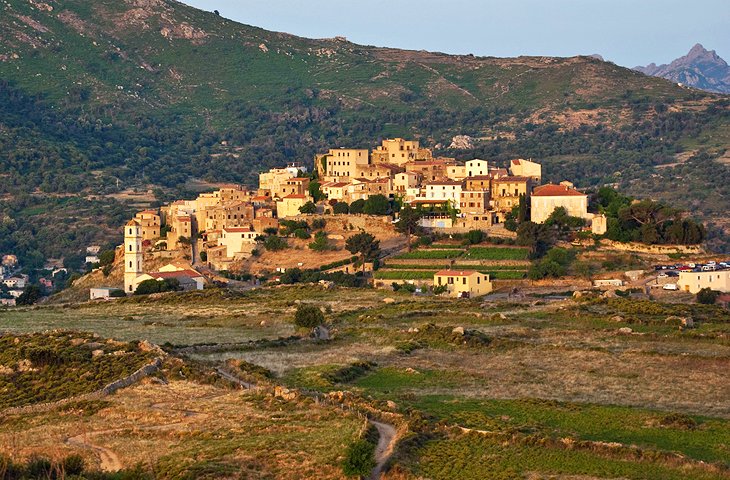
Perched like an eagle's nest on a granite hilltop at almost 500 meters, the ancient walled town of Sant'Antonino offers superb views of the surrounding countryside and the sea.
In the lush Balagne region , Sant'Antonino is one of the oldest villages in Corsica, with a Moorish heritage dating back to the 9th century. Thanks to its old-world charm, Sant'Antonino has earned a place on the list of Plus Beaux Villages de France .
Get ready to do some walking. The village is designed for pedestrians, with its medieval tangle of winding cobblestone streets, alleyways, and covered passageways.
About seven kilometers from Sant'Antonino, the Couvent Saint-Dominique des Frères de Saint-Jean à Corbara perches on a hilltop between snow-peaked mountains and the sea. It's worth the detour to see the splendid 15th-century architecture and admire astounding coastal views.
You may visit the Couvent Saint-Dominique des Frères de Saint-Jean à Corbara by taking a guided tour (in French) or by participating in a spiritual retreat . Guided tours are offered year-round every day (except Mondays) at 3pm.
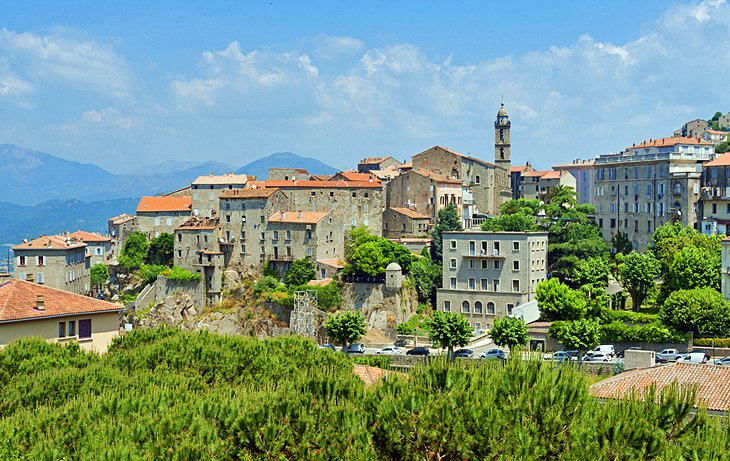
Sartène prides itself on being the "most Corsican" city. This characteristic medieval hilltop town is listed as a Ville d'Art et d'Histoire because of its exceptional heritage.
Must-see tourist attractions include the Eglise Santa-Maria-Assunta , with a simple facade typical of Corsican churches; the former Palais des Gouverneurs Génois , now the Town Hall; and L'Echauguette (tower), which affords sweeping views of the Vallée de Rizzanese.
The Musée de Préhistoire et d'Archéologie (Museum of Prehistory and Archaeology) brings to life the island's ancient history. Exhibits present statues from prehistoric megaliths; Bronze Age and Iron Age weapons, tools, and ceramics; Ancient Roman archaeological finds; and artworks and everyday objects of the Middle Ages.
Near the Palais des Gouverneurs Génois, you'll find an enchanting pedestrian area. Take a stroll to discover the secret corners: arcades, vaulted passageways, and picturesque staircases. The Place du Maghju is a hub of artisan boutiques.
Every year in the spring, the town celebrates the Carnaval de Sartène . This fun-loving carnival festival features parades, musical entertainment, and masked balls.
Sartène also hosts an annual religious procession on Good Friday called the " Catenacciu ," which reenacts the events of the Passion of Christ. One of the "Penitents" carries a heavy cross and a chain during a somber procession, beginning at the Eglise Sainte-Marie and concluding at the altar of Sainte-Marie church. This event attracts pilgrims from near and far.
About 15 kilometers away from Sartène is the Domaine Rosa de Caldane , a pampering thermal bath facility with a mid-range hotel and a brasserie restaurant that serves seasonal cuisine.
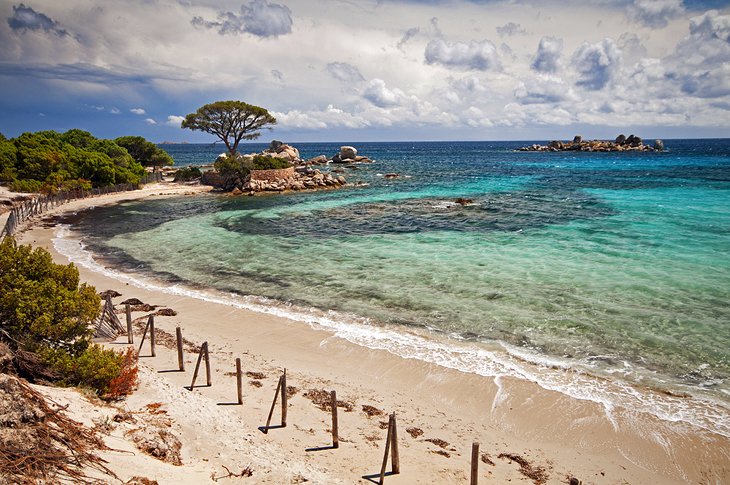
Some of Corsica's dreamiest sandy beaches are around Porto Vecchio, which has become a busy summertime resort. These beaches are prized for their expansive sandy shorelines, gentle waves, and unspoiled scenery.
The most famous beach is the Plage de Palombaggia, renowned for its wide sandy shore and calm turquoise waters. Another excellent sandy beach is the Plage de Santa Giulia . Both of these beaches are in sheltered bays, which provide a protected environment ideal for swimming.
Slightly farther away, the less-crowded Plage de Rondinara is halfway between Porto Vecchio and Bonifacio. This gorgeous sandy beach nestles along Rondinara Bay. The crystal-clear aquamarine waters at Rondinara Beach have an almost tropical quality.
The citadel of Porto Vecchio is also worth visiting. In the 16th century, the Genoese built this impregnable citadel with sturdy fortifications that remain intact. Enclosed within the citadel is a little world of atmospheric narrow alleyways, covered passageways, and quiet squares. Many restaurants and shops are found around the Place de la République.
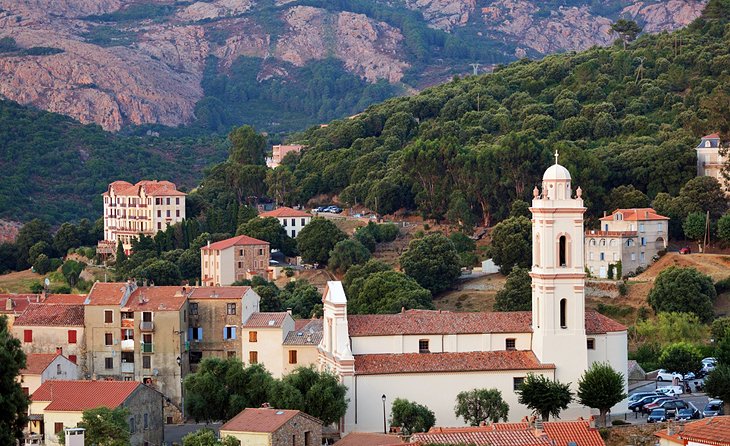
Piana dazzles you with its old-world character and stunning views of the Golfe de Porto. Thanks to its historic charm and natural beauty, Piana is listed as one of the Plus Beaux Villages de France .
Giving the village its special appearance, red-tile-roofed houses spiral around the slopes of a wooded hillside. An exquisite parish church stands at the heart of Piana. The Italian Baroque-style Eglise Sainte-Marie features lovely frescoes and arcades decorated with sculpted medallions.
A pedestrian jaunt is the way to discover this dreamy perched village. You will delight in strolling the quaint narrow streets, while stumbling upon pleasant tree-shaded squares and terraces with gorgeous sea views.
At the entrance to the village, Les Roches Rouges offers upscale accommodations and gourmet meals. In a magical setting, the hotel's guest rooms and outdoor patio look out onto the mesmerizing azure waters of the Gulf of Porto. The hotel's gastronomic restaurant serves classic French cuisine in an elegant dining room that is protected as a Monument Historique .
More awe-inspiring panoramas are found in the hamlet of Vistale , which has an ancient chapel, the Chapelle Saint-Lucie (open in July and August) adorned with Byzantine-style frescoes created by 20th-century Russian artists.
Between the village of Piana and the seaside resort of Porto is a scenic (and challenging) coastal drive on curvy roads that wind through the UNESCO-listed Calanques de Piana mountains. The Calanques de Piana is an inlet surrounded by rose-colored granite cliffs that plunge into the deep-blue Mediterranean Sea. The area's hiking trails feature amazing vistas.
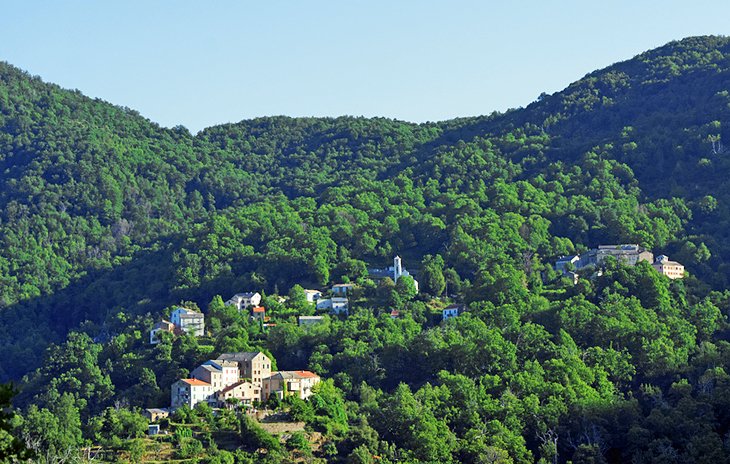
About a one-hour drive south of Bastia is the hilly region of Castagniccia, which takes its name from the chestnut trees that grow abundantly here. The traditional stone-roofed houses all have chestnut-drying rooms.
This peaceful countryside is dotted with ancient hilltop villages, small hamlets, and magnificent churches. Many of the churches, such as the ornately adorned Baroque Eglise Saints-Pierre-et-Paul in Piedicroce and the 18th-century Eglise Notre-Dame-du-Mont-Carmel in Stoppia Nova, are listed as Monuments Historiques .
In a sublime natural setting, the Couvent d'Alesani (another Monument Historique ) in Piazzali has an inspiring spiritual ambience. You may take a guided tour in July and August and on the Journées du Patrimoine in September. During that period, tours are offered on Mondays, Wednesdays, and Saturdays between 3:30pm and 7pm. The convent also hosts summertime events.
Adventurous hikers can climb Monte San Petrone (1,767-meter altitude) from the starting point of Piedicroce or from the Col de Prato; either way the six-kilometer ascent takes about five or six hours. The trail traverses rocky mountain ridges, above chestnut-tree forests, valleys, and little hamlets. From the summit, the vistas sweep across the Mediterranean Sea to the coastline of Italy.
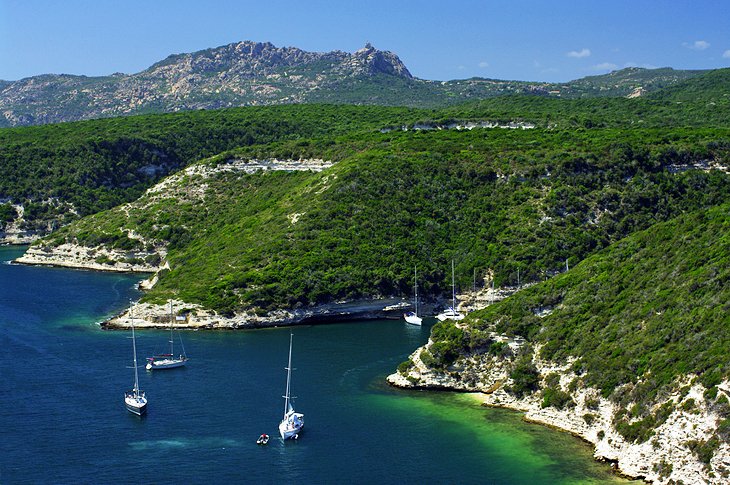
The UNESCO-listed Bouches de Bonifacio Nature Reserve is a protected marine environment that includes all of the waters in French territory, from the tip of southern Corsica extending to the French Riviera and Italian coastline.
Covering 80,000 hectares, the reserve also includes marshland, lagoons, and other coastal areas. Many rare, protected species of birds and fish thrive in this ecosystem.
A highlight of the Bouches de Bonifacio is the Lavezzi Islands marine reserve, a top snorkeling and scuba diving destination in Corsica. Beneath the translucent turquoise waters, a magical underwater world awaits deep-sea divers. Sightings include colorful and exotic fish such as the rainbow wrasse and the silver bream.
Many companies organize snorkeling and scuba diving expeditions; advanced booking is recommended. Boat tours and dinner cruises (departing from Bonifacio or Porte Vecchio) are available for those who prefer to simply relax and enjoy the scenery.
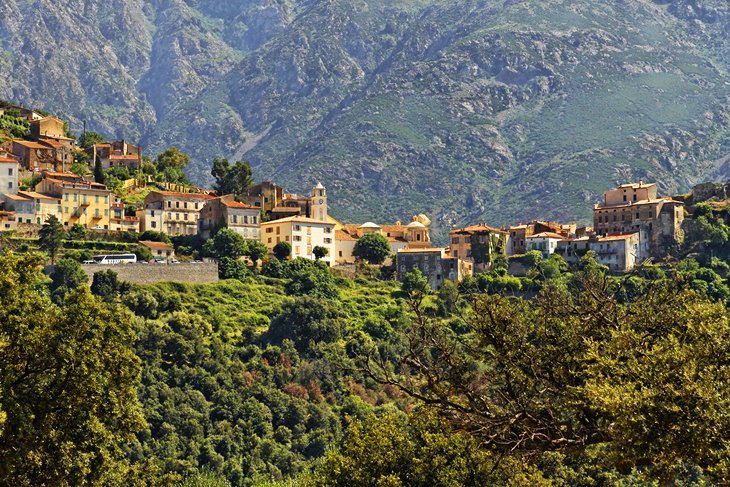
This medieval hilltop village will steal your heart with its enchanting ambience and sensational vistas. Exceptional panoramic views of the sea and the Regino Valley are found throughout the village.
If you're here for a beach holiday, you'll find everything you need in Belgodère and nearby. Below the historic part of Belgodère is a modern beach resort with many hotels, vacation rentals, and restaurants.
Be sure to explore the old walled area of Belgodère (the Cabanne and Cima du Fondu quarters). You will enjoy wandering around the winding streets, relaxing at an outdoor café terrace, and discovering historic monuments.
The Baroque Eglise Saint-Thomas displays a noteworthy 16th-century Virgin and Child painting.
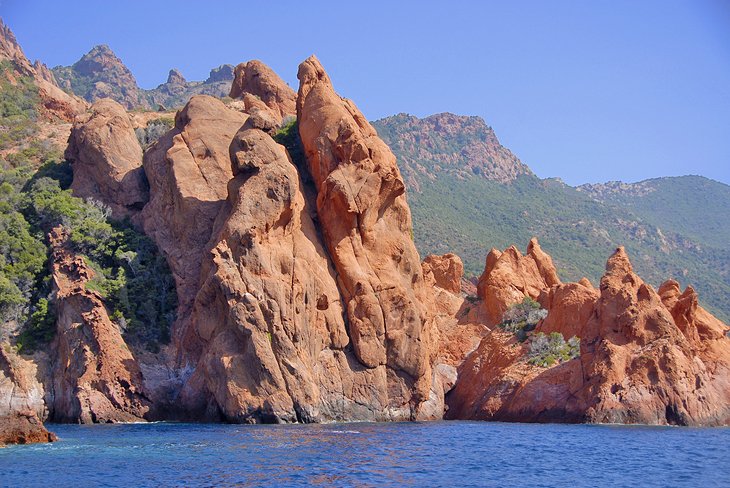
A surreal coastal landscape awaits you at the Réserve Naturelle de Scandola. Overlooking the Gulf of Porto, this UNESCO-listed nature reserve is only accessible by boat.
The Scandola Nature Reserve encompasses a remote mountainous peninsula and offshore islands formed from an ancient volcano. Crystal-clear turquoise waters lap against cliffs and hidden coves.
Scuba and snorkeling enthusiasts, rejoice! You will find here some of the best snorkeling and scuba diving in Corsica. Marine life includes dolphins, seals, moray eels, swordfish, and coral reefs.
Shuttle boats depart frequently from Calvi and less frequently from Porto and Galéria. Many companies offer organized tours, for an easier way to visit.
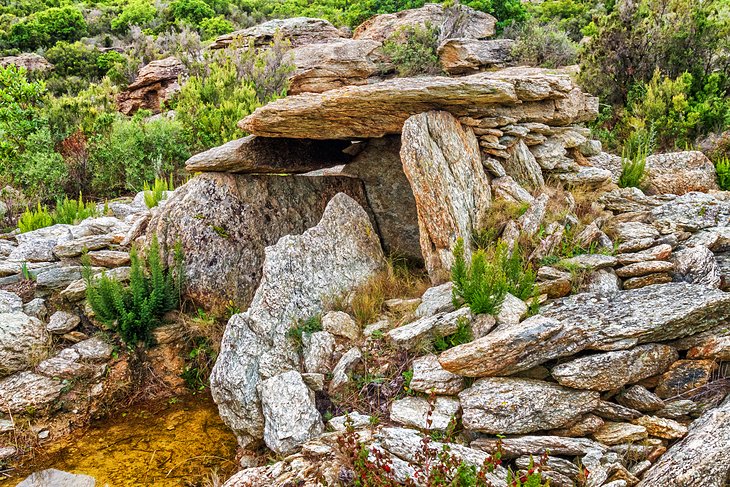
The Désert des Agriates is a vast protected wilderness of scrubland, agricultural plains, craggy coastline, and cream-colored sandy shores. If you're planning a summertime visit to the Agriates Desert, you will probably want to sunbathe at pristine sandy beaches.
Two favorite beaches are the Plage de Lotu and the Plage de Saleccia , prized for their soft white sand and transparent waters. Both beaches are ideal for sunbathing and swimming.
The Plage de l'Ostriconi , tucked away behind sand dunes, feels like a secret spot because of its secluded quality.
Besides lounging at the beach, other things to do in the Désert des Agriates include hiking, nature walks, and fishing.
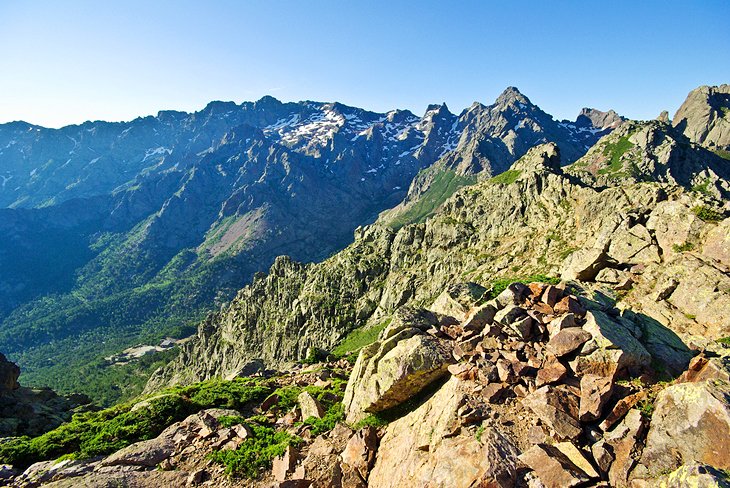
Corsica's GR20 trail traverses the island of Corsica from north to south, covering wild and remote hillsides and deep gorges. Extreme outdoor adventure enthusiasts and advanced hikers hold this trail in high esteem.
The trail is considered to be the most difficult long-distance hike in Europe . Not only is the trail extremely long, the terrain is rugged and dramatic. Those who are sufficiently conditioned to attempt the hike will ultimately be rewarded with jaw-dropping panoramas.
Read More: Top-Rated Hiking Trails in France
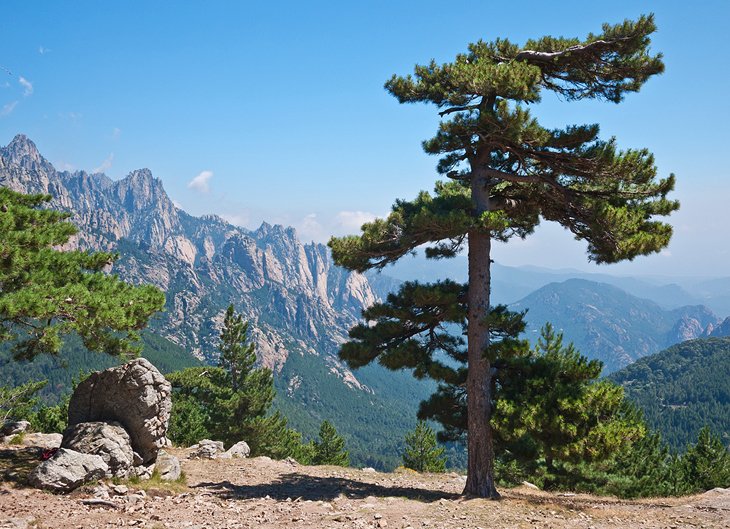
If you're touring Corsica by car, the scenic drive through the Col de Bavella is highly recommended. The road travels through majestic landscapes and along the path of an ancient Roman road, continuing up to the mountain pass at 1,243 meters. From that point, there are breathtaking views of the forests and plains, the mountains, and the sea.
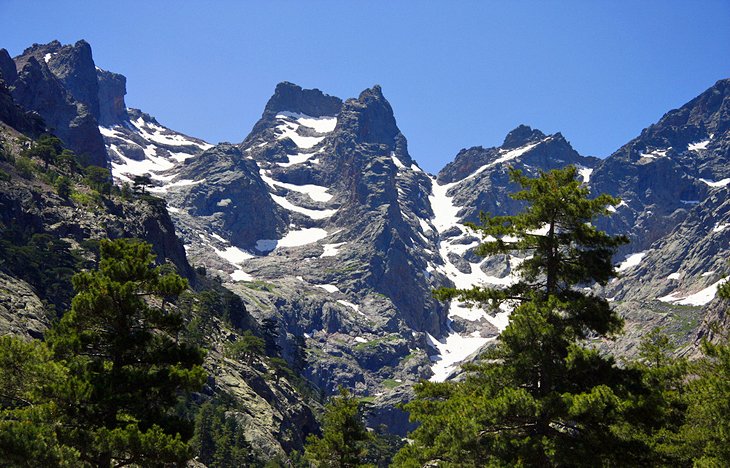
The Valdo-Niello Forest is an unspoiled environment of shady Corsican pine trees that can reach heights of 50 meters. The specific variety of tree, the Laricio Pine, is emblematic of Corsica. These dense woodlands provide a habitat for bird species such as the Corsican Nuthatch.
Also within the forest is Corsica's highest mountain, Monte Cinto , which soars to 2,706 meters and is snowcapped even in summer.
A variety of walking paths and hiking trails wind through the forest. Taking a hike here is an invigorating experience that allows you to breathe in the fresh air and admire the natural beauty.
More Related Articles on PlanetWare.com
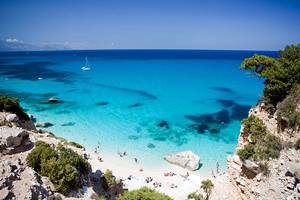
Dreamy Island Destinations in Italy: It's an easy ferry ride from Corsica to two idyllic Italian islands. Just 20 kilometers south of Corsica is the island of Sardinia (considered one of the best places to visit in Italy ). The shortest ferry route from Corsica departs from Bonifacio and takes about one hour to arrive at the port of Santa Teresa in Sardinia.
From Bastia, it's a 4.5-hour ferry ride to the island of Elba in Italy's Tuscany region , where Napoleon was exiled. Today the island is a paradise of secluded beaches, alluring seaports, and luxuriant Mediterranean scenery.
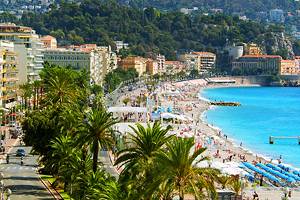
Stylish Towns in the South of France : Several destinations in the south of France could be combined with a visit to Corsica. From Bastia in Corsica, travelers can reach the fashionable city of Nice on the glamorous French Riviera in about five hours by ferry.
From the port of Ajaccio in Corsica, it's a six-hour ferry ride to the atmospheric port town of Toulon , which is near Provence's glitzy beach resort of Saint-Tropez (a one-hour drive from Toulon) and charming Aix-en-Provence (about a one-hour drive from Toulon).

More on France

Corsica travel guide

Visit Corsica, France
Some of the world's finest beaches, spectacular mountain scenery and fascinating towns and marinas - these are just some of the reasons why the sun-kissed 'Isle of Beauty', as Corsica is known, is such a popular destination...
Corsica tourism

Given its relatively small size the island combines an extraordinary amount of highlights. Apart from the coast and beaches for which the island is best known (there are 1,000 kilometres of coastline and more than 200 beaches) there are ancient hill villages and bustling port towns , and some of the most stunning coastal and mountain scenery to be found in Europe.
Corsica has very good weather for most of the year with spring and autumn being especially lovely times to visit.
You will also find numerous historic monuments , some dating from prehistoric times with numerous megalithic sites, dolmens and menhirs eg at Filitosa, still reminding us of the long history of the island. There are more monuments from the ancient Greek and Roman periods, and many fortified towers and citadels built when the Genoese controlled the island.
Corsica beaches

In many parts of Corsica you are spoiled for choice when looking for beautiful beaches. Porto-Vecchio and Bonifacio are towns close to some of the best beaches in Corsica, with others to be found at various places along the south and west coasts. There are rather less visited beaches on the eastern side of the island and around Cap Corse.
It is useful to realise that in Corsica there are 'very nice' beaches in many places around the coast, for example at Calvi or near Ajaccio, but 'exceptional beaches' are less common. Many (but not all) of these exceptional beaches are found to the south of the island: see Porto-Vecchio beaches for Palombaggia, Tamarriciu and Santa-Giulia beaches and Sperone beaches near Bonifacio for some of the most remarkable beaches.
See our guide to some of the best beaches in Corsica
Exploring Corsica: the regions
Your first challenge when planning a visit is to decide where on Corsica you are going to be based or what you are going to visit! Each region has its own characteristics and highlights, and a fortnight is only just enough to tour the whole island - and won't leave you much time for sitting on the beach! If you are to also allow time for beaches and excursions inland you might need to allow three or four weeks for the perfect visit.
Most visitors are based near the coast on the south or west side of the island where the majority of the famous ports, beaches and scenic highlights are found. But that still leaves a large area to choose from! Use the regional guides below for inspiration...
Note: see also our detailed guide with suggested itineraries for Corsica tours of one, two or three weeks .

North-east Corsica includes the popular port towns of Saint-Florent and Bastia , as well as Cap Corse and the vineyards and villages of the Nebbio region, and also the remote beaches of the Desert des Agriates (the only region in Europe officially classified as a desert).
The peninsula known as Cap Corse extends north from Bastia to reach some of the more secluded parts of the island: see the Cap Corse guide for details. Among the places of particular interest as you travel around Cap Corse are the villages of Erbalunga and Nonza , the port of Centuri , and the beaches and fishing villages such as Barcaggio and Rogliano in north Cap Corse .
On the eastern side of the island here in the north you can explore the hill villages south of Bastia in the region called the Casinca.
France This Way opinion: this is a region to tour rather than a place to spend a long time...

Visits to the north-west of the island are focussed around Calvi and L'Ile-Rousse ,both of which are lively resorts. Calvi in particular has an extensive citadel, lively harbour and is well known for its extensive sandy beach.
On the coast between Calvi and l'Ile-Rousse you can explore the marina at Sant'Ambrogio and the quiet beach resort at Algajola .
If you are staying in this region of Corsica we suggest you also take a trip inland to visit the small villages in the hills and to explore the Balagne region: a mountainous region with small villages hidden in the hills, often with very impressive views out across the coast. Sant'Antonino , north-east of Calvi, is listed as one of the 'most beautiful villages of France' and Belgodere, Pigna and Corbara are also among of our favourites.
France This Way opinion: although not the most spectacular part of Corsica, if you are looking for a week on a sandy beach and a day or two of exploring Calvi could well be right for you...
Advertisement

The most important town here in the west is the port town of Ajaccio (birthplace of Napoleon), a large port town with an extensive historic centre and close to attractions such as the Iles-Sanguinaires and the beaches at Capo di Feno, although there is not a good beach actually in the town itself. Cargese is another town on the western coast of Corsica.
This western region of Corsica is best known for its scenery: some of the most dramatic coastal landscapes are found near Porto , between Ajaccio and Calvi, with the Scandola Nature Reserve and the Calanques de Piana among the highlights. The village of Piana , south of Porto, is classified among the 'most beautiful villages of France' and the Gorges de Spelunca (a short distance east of Porto) and are also among the attractive destinations.
France This Way opinion: the scenery around Porto is probably the most beautiful coastal scenery in Corsica, perhaps in France, and should definitely be included as part of any tour of the island!

The southern part of Corsica includes Propriano on the western coast and Sartene inland from here. This part of the island is also the best place to see prehistoric monuments, including the remarkable carved figures at Filitosa and the standing stones at Palaghju.
Further south in Corsica you find Porto Vecchio to the east, with Bonifacio perched on a clifftop at the southern tip of the island. The views across Bonifacio are stunning and several of the most beautiful beaches in Corsica are found close to Bonifacio and Porto Vecchio.
North of Porto-Vecchio is the Col de Bavella , a scenic mountain pass with huge cliffs looming overhead and one of the highlights of the mountains in Corsica. There are lots of trails here that allow you to explore the stunning scenery.
France This Way opinion: if we had one week in Corsica to spend in one place we would stay near one of the idyllic beaches between Porto-Vecchio and Bonifacio , and spend days out exploring the towns, beaches and mountains of this region.
Central Corsica

The central part of Corsica is where you will find the dramatic mountain scenery - to explore the stunning landscapes in this mountainous heart of the island we suggest you start in Corte . The Natural Park of Corsica - the Parc Naturel Régional de Corse - around Corte covers more than a third of the island, essentially all the mountainous interior of the island, and is home to many scenic spectacles and hundreds of protected species of plants and animals.
Among the most scenic attractions here you should visit the scenic Gorges de la Restonica and the Gorges du Tavignano to the west of Corte.
To the east of the island here the densely forested hills are relatively unexplored and contain numerous small villages hidden away in the forests.
France This Way opinion: we adore this part of Corsica, although the mountain scenery is the big attraction rather than the towns and villages so you will need to get out exploring, preferably on foot!

The coast of eastern Corsica has less developed towns than the other regions of the island, with Aleria and the associated resort of Caterragio being the largest. In Aleria you can see some important Roman ruins.
It is here in the east that you can venture into the forested hills to discover the Castagniccia region, with dense woodlands hiding villages that seem to have been passed by during the centuries and one of the few places in Corsica where you can explore without often passing other tourists.
You will quickly discover your own favourites but we suggest the villages of La Porta, Morosaglia and Piedicroce as being quiet typical of the region.
France This Way opinion: this quiet part of Corsica is more likely to feature as part of an extended tour of the island than as a base for a visit.
Eating out in Corsica
You visit Corsica to relax so don't miss the chance to visit some of the restaurants and sample the local Corsican food, preferably one of those serving fresh fish around a bustling harbour. With the sea all around, the seafood here is always fresh and delicious. Prices are usually lower if you venture into the streets of the older parts of towns rather than eat in the harbour restaurants.
Apart from fish the local specialities on Corsica include an abundance of goats, sheep and pigs...hence you will find cured meats, sausage, bacon, and ham. Chestnuts, nectarines, clementines and figs also grow on the island and influence the local cooking.
You will also very often see brocciu mentioned: this is a local cheese made from goat and sheep whey that only lasts a few days (so it is rarely seen outside Corsica) but gets used in many recipes and traditional dishes on the island.
Arrange a visit to Corsica
Book hotels, car hire and flights.
- Book a visit
Hotels in Corsica
Booking.com: best prices
For great prices on car hire throughout France and Corsica please visit our recommended partner at RentalCars.com
Reserve excursions
Map of corsica and places nearby, visit near corsica with france this way reviews.

... or see ALL recommended places to visit in Corsica
The French version of this page is at Corsica (Francais)
More information
A Corsica photo gallery with some of the selected highlights
An index of every place in Corsica
French version: Corsica (Francais)
French Places
We can help you visit any town, village or region of France...
Popular & Useful
① Ideas & inspiration ② Maps of France ③ Explore by region ④ Route planner ⑤ Places (by dept.)
France This Way copyright 2006 - 2024
- Cookies & privacy
- Index of places
- Skip to primary navigation
- Skip to main content
- Skip to primary sidebar
- Skip to footer

Corsica Lovers
To awaken your senses in Corsica - Claire et Manu’s Blog
27 best things to do in Corsica (with our photos!)
by Claire ROBINSON , Region Lovers | 3 May 2023 | no intrusive ads, no sponsored content, just some affiliate links - if you use them, we get a small commission (read more)
Visiting Corsica is magical : paradisiacal beaches, imposing mountains, charming villages… No time to get bored! The problem is to choose the best things to do in Corsica . Here is our selection to help you plan your trip, places and activities that we have experienced and loved:
- dream beaches,
- charming villages,
- inspiring walks,
- unique places,
- and much more…
BEFORE OUR TIPS + PHOTOS HERE ARE OUR FAVORITES IN Corsica
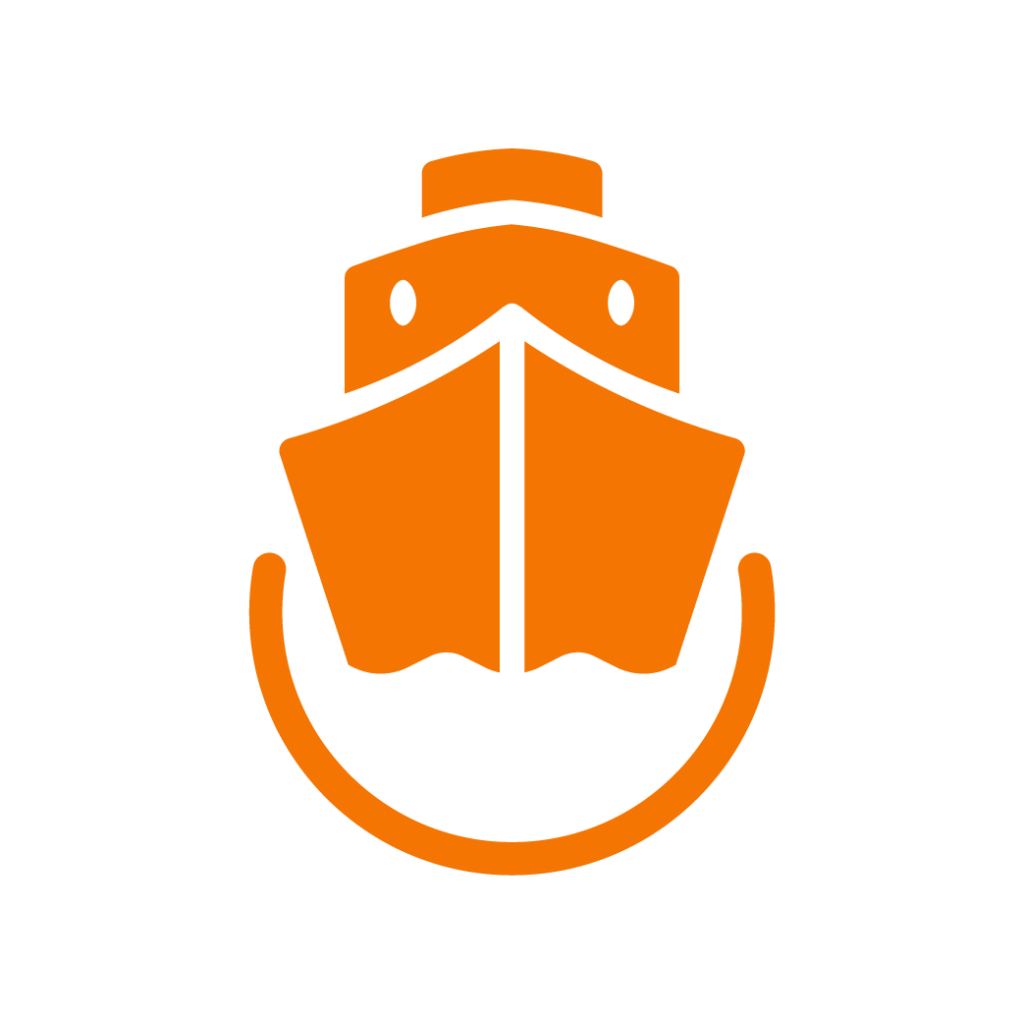
Our favorite car rental platform: DiscoverCars

Our guide to planning your road trip: eBook
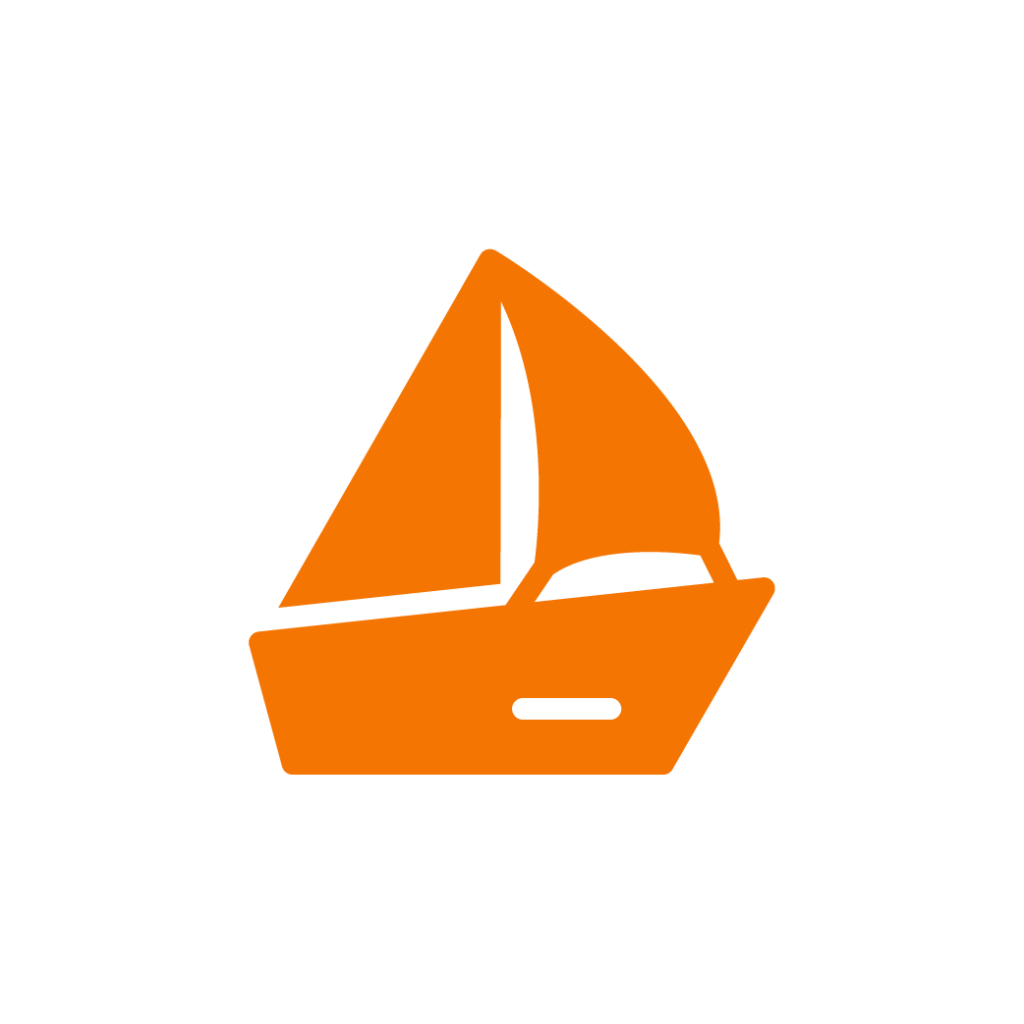
Our must-do boat trip: Exploring the cliffs of Bonifacio

Our favorite towns to stay in:
- Bonifacio near the citadel – see the best rated accommodations
- Porto-Vecchio near the beaches – see top-rated accommodations
- L’Île-Rousse in Balagne – see the best-rated accommodations
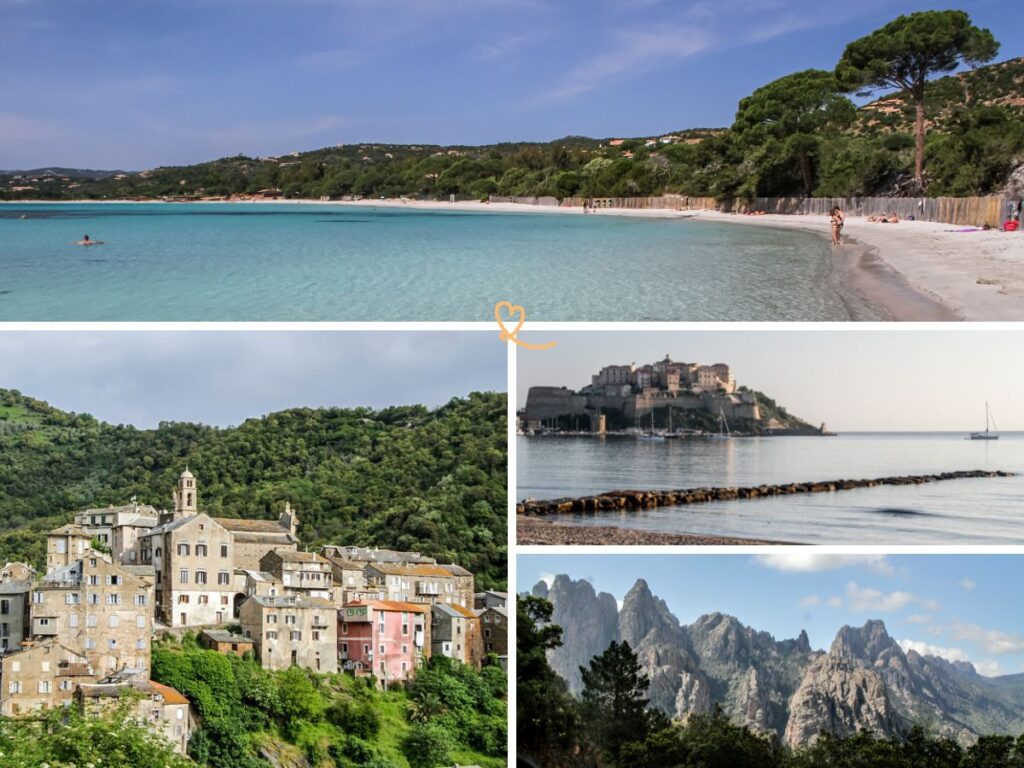
Things to do in Corsica: map of the 10 must-sees
What to do and see in corsica: our top 10.
There are so many fascinating things to do in Corsica, that making a choice is difficult. Here are our top 10 must-sees with a map to help you find your way.

And see all our tips for planning a dream trip to Corsica here .
Video – virtual tour to visit Corsica
Before listing all our favorite places, here is a short video to put you in the mood for a trip to Corsica:
1. Admire the Bonifacio citadel

Why we love
Bonifacio is one of the most fascinating places in Corsica. A must in our opinion! The place combines nature, history and architecture. The citadel is built on a peninsula surrounded by impressive white cliffs, sculpted by erosion. It is a unique place!
Best things to do in Bonifacio
There are several ways to admire Bonifacio and the surrounding reserve:
- Explore on foot from the marina
- A boat tour to admire its structure, the sea caves and the houses that seem to float on the cliffs
- Hike to the Capo di Pertusato for exceptional views of the area
- Going down the Aragon Staircase , at 45° dug in the rock, to enter the history of the city
- Find all our tips for visiting Bonifacio

Location and practical information
- In South Corsica
- Ajaccio to Bonifacio = 2h30
- Porto-Vecchio to Bonifacio = 35min
- The best option to explore the area is to stay in Bonifacio. We really enjoyed my nights at the Hotel Santateresa, including the modern rooms and the fantastic staff! See photos and availability
- or see the best rated accommodations in Bonifacio .
2. Take a boat around the calanques de Piana

The Gulf of Porto is a Unesco heritage site not to be missed! The cliffs and rock formations are incredible with its 2 sites: the calanques de Piana and the natural reserve of Scandola. Geology enthusiasts, as well as lovers of rock formations, will be delighted. The rocks are predominantly pink, but there are many colors and structures.
What to do in Piana
There are many ways to explore the area:
- A boat trip around the calanques de Piana – see our advice
- A boat trip in the Scandola reserve – see our advice
- Hiking in the calanques de Piana and up to Capo Rosso
- Go down to the beach of Ficajola
- Book your boat tour

- Middle of the west coast of Corsica
- Not very easy to access, long and slow road whether you come from the north or the south.
- Ajaccio to Porto Ota = 1h45
- Calvi to Porto Ota = 1h45
- Given the difficulty of the road, it is easier to plan a night on site
- Option 1 = the village of Piana in the calanques, on high ground, so many hotels have incredible views of the gulf. See the hotel Capo Rosso for its view and its swimming pool in front of the sea – see photos and availability
- Option 2 = Porto Ota Porto, which is located in the heart of the gulf and is convenient for boat tours
- See the best rated accommodations in the area .
3. To go around the Cap Corse by car

The Corsican Cape is very different from the rest of Corsica. Here, the wild landscapes show us mountains that flow into the sea: beaches of white sand or black pebbles, turquoise waters… The road along the west coast of Corsica is enchanting (but keep your eyes on the road at all times, beware!).
What to do in Cap Corse
You can simply do it all by car from Cap CorseThe views are magnificent and already very pleasant. To make stops, we advise you:
- Visit the charming village of Erbalunga with its small port and its ruined Genoese tower
- Hike on the Sentier des Douaniers, to discover beautiful beaches and landscapes far from the cities
- Admire the view from the Mattei Mill
- To have the vertigo in the village of Nonza with its square tower and its black sand beach
- see our complete article on the Cap Corse

- Northern tip of Corsica
- Direct access from Bastia
- From Bastia to Macinaggio (in the north) = 1 hour drive
- We recommend you to visit the Cap Corse counterclockwise direction
- Allow at least 1 day, but if you are doing a road trip, you can stop 1 night in Macinaggio to do a can of walking.
- For example, the Tominio Hotel has a breathtaking view of the northern tip – see prices, photos and availability
- See the best rated accommodations
OUR TIPS FOR RENTING A CAR IN Corsica
- Compare prices on our preferred platform: DiscoverCars – one of the best rated sites.
- Choose a car that is powerful enough (the roads are steep) but compact (some passages are narrow).
- Think of the complete insurance (some roads are tortuous and narrow).
- There is a lot of demand, book it early .
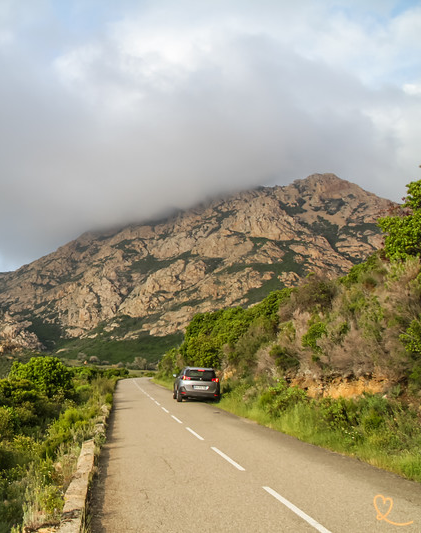
We love places that are difficult to reach by car, to be surrounded by nature. And the Agriates desert is particularly fascinating because it combines: paradisiacal beaches of white sand, hikes in the Corsican maquis and views of the mountains of Cap Corse. This small corner of paradise is really worth the detour, if you pass by Saint-Florent.
What to do in the Agriates desert
Our favorite way to explore the desert is to take the boat from Saint-Florent to Lotu beach. Admire this first beach, then take the easy 1 hour hike inland (or 1 hour 15 minutes along the coast), to reach the famous beach of Saleccia .
But there are also boat shuttles that take you directly to Saleccia, 4WD tours in the desert and longer hikes. Learn more in our article on the desert .

- North Corsica
- Departure of the boats from Saint-Florent
- Bastia to Saint-Florent = 40min
- Calvi to Saint-Florent = 1h30
- Ajaccio to Saint-Florent = 2h50
- The best is to stay in Saint-Florent next to the sea or not far from it in the vineyards of Patrimonio (for example at the Lustincorne inn which we liked – see ).
See the best rated accommodations in Saint-Florent
5. Visit several charming villages of La Balagne

Balagne is one of the most beautiful destinations to go to in Corsica (see our list ). It combines beaches and charming villages. These villages of Balagnes are distributed on the hills between the mountain and the sea. Often installed on the summits to better protect themselves, they have managed to preserve their heritage and their atmosphere. These small “fortress villages” offer beautiful views and a long history.
What to do in the Balagne
Besides Calvi, Ile Rousse and beautiful beaches, the attraction of La Balagne are the villages. Among our favorites:
- Pigna : built on top of a hill recognizable by its blue shutters. It has a lot of charm with its artists’ stores.
- Speloncato : much less known, we loved it. You really feel like you’re traveling through time when you walk through it
- Sant’Antonino : one of the highest and oldest
- See our article on the most beautiful villages of Balagne

- On the northwest coast of Corsica
- Around the cities of Calvi and Ile-Rousse
- Bastia to Calvi = 2h
- Ajaccio to Calvi = 3h
- Very good choices of accommodations in Calvi and Ile-Rousse. If you hesitate between the 2, our preference is for Ile-Rousse
- See the best rated accommodations in Calvi
- See the best rated accommodations in Ile-Rousse
HOW TO GET TO Corsica
Option 1: by ferry
Departure from France and Italy
- See all ferry options in our article
- Compare schedules, prices and availability directly
Advantage: you can take your car!

Option 2: by plane
Airports in Bastia, to visit the North, Figari to visit the South, or Ajaccio convenient for all Corsica. Compare flights!
6. Admire the citadel of Calvi

The main attraction of Calvi is its Citadel. This is the most recognizable part of the city. It was built under the Genoese government, between 1483 and the 17th century in order to have stronger defenses. There are impressive fortifications all around. The best thing to do is to admire it from the beach, on its peninsula, and then go and get lost. Read more
Best things to do in Calvi
Our favorite activities in Calvi revolve around the Citadel:
- Walk on the beach at sunset with a view of the citadel
- Visit the cobbled streets of the citadel
- Admire the views from the walls with the port, the city and the mountains
- Have fun getting lost in the stairs, tunnels and other buildings.
- See our guide to visit Calvi

- Wear walking shoes because the floors are old
- There is a wide choice of accommodation in Calvi with campsites close to the beach and nice hotels near the marina. If you want to sleep in the citadel, you will find mostly rentals.
7. Have fun on the rocks of the Lavezzi Islands

The Lavezzi archipelago is a series of small islands and granite reefs. Only 30 minutes by boat from Bonifacio, you can explore a land full of giant rocks of different colors and shapes. It is sometimes called the “Seychelles of the Mediterranean” (but on a much smaller scale, of course). For us, it’s a playground for giants! And we had a lot of fun doing it.
What to do in Lavezzi Islands
During an excursion to the Lavezzi Islands, you can enjoy:
- views of the citadel of Bonifacio and its cliffs
- huge rocks of all colors and shapes
- beautiful beaches surrounded by rocks with clear waters
- great opportunities for snorkeling
- short walks to explore the main island in length and breadth.
- see all our advices on Lavezzi islands

- 30min by boat from Bonifacio
USE OUR GUIDE TO PLAN A DREAM TRIP TO Corsica
All the information you need for your trip:
- 7 maps that make planning easier
- 130+ pre-selected locations
- Practical advice
- + 220 photos to help you choose

8. See Île-Rousse at sunset

Île-Rousse is one of our favorite cities in Corsica (see our list ). The city is not located on an island. The city takes its name from the small island of Pietra where the rocks turn red at sunset. Its original name was Isola Rossa, since Italian was the administrative language at the time. This is due to the ochre color of the islands that create a natural harbor.
What to do in Ile-Rousse
The little town is full of charm, enjoy:
- from the beach in the center of the city
- colorful houses
- of the market
- from the walk to the islands
- the view from the lighthouse
- More details in our article on Ile-Rousse

- Bastia to Ile-Rousse = 1h30
- Ajaccio to Ile-Rousse = 3h30
- Very good choices of accommodations in Ile-Rousse. Charming hotels at 2 steps from the sea.
9. Discover the famous beaches of the south: Palombaggia and the others (What to do in Porto-Vecchio)

The most famous beaches of Corsica are in the South between Bonifacio and Porto-Vecchio. There are other beautiful beaches all around Corsica, but the southern tip has a high density of exceptional beaches: white sand, rocks, umbrella pines, turquoise waters…
The most beautiful beaches of South Corsica
It’s not easy to make a selection but let’s start with these:
- The beach of Palombaggia , the most famous with orange rocks
- The beach of Tamaricciu with its postcard cove
- The bay of Rondinara with a protected beach and beautiful colored rock formations
- See our favorite beaches around Bonifacio

- Southern tip of Corsica
- Between Bonifacio and Porto-Vecchio
- You can find nice accommodation near the beaches, around Porto-Vecchio and Bonifacio
- For example the Residence U Pirellu is well located to access all these beaches and has a great pool with sea view – see prices, pictures and availability
- See the best rated accommodations in Porto-Vecchio
PLAN YOUR TRIP TO Corsica
Inspiration destinations
- Best things to do in Corsica
- Ajaccio or Bastia?
- North or South Corsica?
- Planning a road trip in Corsica
- Itineraries: 3 days – 4 or 5 days – 1 week – 10 days – 2 weeks

- The most beautiful beaches of Corsica
- The most beautiful villages of Corsica
- The most beautiful cities of Corsica
- The most beautiful destinations in Corsica
- The museums of Corsica
- Hidden gems in Corsica
- The most beautiful natural pools
- What to do in North Corsica
- Best things to do in South Corsica
- Canyoning in Corsica
Where to stay
- Where to sleep in Corsica
- The most beautiful hotels in Corsica
- Best luxury hotels in Corsica
- Best seaside hotels

- Which ferry to Corsica
- How to get to Corsica
- Renting a car in Corsica
- Driving in Corsica

10. Visit Bastia

Main city of the north of Corsica, it goes back to the Roman time when it was called Cardo. Its historic center overlooks the old port with a fortified citadel. It is very pleasant to walk through the old streets and around the marina. The atmosphere is lively.
What to do in Bastia
Lots of things to discover in the city of Bastia:
- Explore the city on foot with its narrow streets and fortifications
- Walk around the small port
- Take the tourist train
- Visit the Governor’s Palace (also a museum)
- Enter the churches: the 17th century Oratory of St. Roch and the 17th century Church of St. John the Baptist near the marina with Baroque features.
- Rest in the garden of Romieu

- North of the island
- Paved streets, wear comfortable shoes.
- Allow half a day to a day to enjoy the city and its citadel.
- See the best rated accommodations in Bastia
11. Listen to a concert of Corsican polyphony

Another typical experience to have in Corsica is to listen to Corsican Polyphonies. These are singing experiences where only the voices come together to produce music. In Corsica, the typical groups are only male voices. They sing in perfect harmony, mainly in Corsican language. They are very powerful and carry deep emotions. Even when you don’t understand the words, you feel the song. There are regular performances almost everywhere, often in churches. Just look for small signs attached along the roads.
For example, we had the chance to listen to I Campagnoli in a small church in Bonifacio. And we loved it!!!
No particular advice. Everywhere you go, look for the signs on the poles. They often indicate concerts in the local churches.
Subscribe to our Newsletter
- Get away from it all with Region Lovers’ beautiful destinations!
- Once a month
- Advertising-free
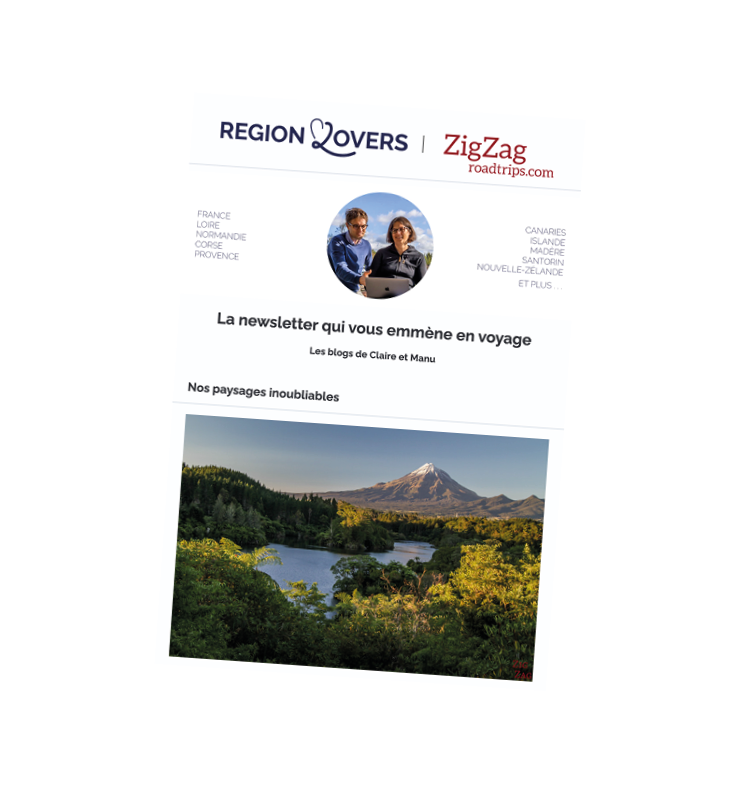
12. Live a magic moment in Cucuruzzu

This site is not often listed in the best things to do in Corsica but we had a crush. The tour takes you on a 2-hour walking loop through a mystical-looking forest… with ruins mixed with giant rocks! Kids and adults alike will love it. This archaeological site houses Bronze Age structures using local granite. Moreover, it offers a magnificent view of the needles of Bavella in the distance.

- South Corsica
- Porto-Vecchio to Cucuruzzu =
- Bonifacio to Cucuruzzu =
- The loop lasts 2 hours
13. Hiking (depending on your level: easy or GR20)

You can find walks and hikes for all levels around Corsica. For simple walks, the Customs Trails are often good options. These are coastal paths for the surveillance of the island. They are normally in good condition and do not present many difficulties. Note that the steps are sometimes marked ‘simple’ but they can be steep and hard on the knees. They take you to magical landscapes mixed with mountains, sea, scrubland, forest …
Which hike to do in Corsica
Some of our favorite hikes are:
- Capo Rosso above the calanques de Piana
- The path of the customs officers in Cap Corse
- The hikes of the Agriates desert
- The Cascade des Anglais
- The Lake of Melo in the Restonica Valley
If you are in the mood for intense hiking, there is a famous trail that allows you to cross the island over several days. It is called GR20 and you can take a small section of it when you do short hikes.

A little everywhere in Corsica. The most difficult are of course in the heart of Corsica with all the mountains.
15. Thinking you’re on the moon at St. Anthony’s beach

Not famous at all and yet fascinating! Everyone knows the cliffs of Bonifacio. But here you can go to the bottom to a beach. And around it, the limestone has been greatly eroded by the elements, creating a lunar landscape. There is even a giant hole, the Orca cave. It is an open sea cave. Great place to explore but beware of children! Learn more in our article .

- South of Bonifacio
- From Bonifacio: hiking or road + walking
- Driving time from Porto-Vecchio = 35min
- Driving time from Ajaccio = 2h30
- Hiking from Bonifacio: path that goes along the cliff with magnificent views. An easy 6km route that starts at the Chapelle Saint-Roch. Follow the signs “Sentier de Pertusato”.
- By car on the D260 road to the semaphore parking (also called Saint Antoine’s cave parking) then 1km of easy walking + 10min of steep descent.
15. Savor Corsica

Corsica is also a place to enjoy with all your senses.
Corsica offers a French cuisine with Corsican flavors. The most famous foods to taste are the local cheeses and the cold cuts (salty but very tasty). And if you prefer sweets, you MUST try the delicious Canistrelli cookies. Don’t worry, you can find them everywhere. Ohhhhhh, we ate way too much… And they are available in several flavors: Natural, Walnut, Lemon, Anise….. Sometimes a simple plate of meat and cheese with local wine makes a wonderful meal.
16. Visit Corsica: The tour of the island in road trip
The best way to explore Corsica is by road. Jump in a car and go on a road trip. There is so much to see. In the morning, you can go up into the mountains to admire the summit of the Bavella Needles and in the afternoon, relax on the heavenly beach of Palombaggia.
Every turn of your route can reveal amazing scenery!

Driving is not as difficult as some people say on the Internet. Yes, it’s winding and I can count on my hand the times we saw a straight road. And yes, the roads can be narrow in the mountains. But in general, if you don’t drive fast and don’t plan your trip properly, you won’t have any problems (see our guide to driving in Corsica ).
Some of our favorite roads to drive were:
- From Evisa to Porto with the red mountains
- The west coast of Cap Corsewhere the mountains plunge into the sea
- The gorges of Solenzara, from the emerald river to the view of the peaks of Bavella
- The narrow canyon of Inzecca, close to the rock
- and the famous Restonica valley with its high peaks (this one is a difficult journey, I admit).
See our article to plan a road trip in Corsica .
17 à 25. Other places to see in Corsica
17. visit ajaccio – what to do.

In Ajaccio, unfortunately, the Citadel is a military site. Therefore, you cannot visit it. The city itself is not the most fascinating in our opinion. The main interest for me was the boat trip to the Sanguinaires Islands. If you like art, there is the famous Fesch museum and if you like history, you can visit the former house of Napoleon and its museum. What to do:
- Walk around the city to see: the citadel, the Notre Dame de l’Assomption cathedral, the Saint Roch church, the 19th century Lantivy palace
- Visit the National Museum of the Bonaparte Residence – a small museum where the emperor spent part of his childhood
- Visit the Fine Arts Museum in the Fesch Palace – a great mix of art and architecture, including the imperial chapel
See the best rated accommodations in Ajaccio
18. To be delighted by the beach of Ostriconi
This is one of the views that blew us away the most while visiting the island. At Ostriconi, the access road is higher than the beach, which allows for a breathtaking view of the white sand, the intense colors of the water and the rocks of the Agriates desert in the background.
In Haute-Corse, the beach of Ostriconi is located at the southern limit of the Agriates desert between Ile-Rousse and Saint-Florent.
19. Visit Saint-Florent – What to do

Saint-Florent is a popular destination: a charming little port with an old fort in a natural bay with the mountains in the background. What to do:
- To go around its Genoese citadel dating from the 15th century
- Visit its small cathedral of Nebbio of the 12th century.
- Relaxing on the main beach, the Plage de la Roya
- Admire the mountains of Cap Corse
- Take a boat in the nearby Agriates desert
- Visit the vineyards of Patrimonio
- Learn more in our article on Saint-Florent
20. Fun in the rocks of Punta di Spanu

We love rock formations, you must have seen it in our selection so far. Here are some more! Punta di Spanu is a fun place with several small coves and many rocks. Some are smooth because of the water, others are cut. There’s even one that’s been cut cleanly in half. You can walk around the point and up to a tower. Located between Calvi and Ile-Rousse.
21. Visit Sartene – What to do

Sartene is probably the most Corsican of Corsican cities with its old houses with red roofs. When you explore the old center, it’s like being in an old village. Its history dates back to medieval times, and part of the city was built in the early 16th century. What to do:
- walk in the old center
- visit the church which is very photogenic
- enjoy the views of the mountains and the city
- take the time to have lunch there because the atmosphere is very pleasant
22. Discover the forest of the Ospedale

Looking for freshness and a little Canadian flair? Discover the forest of Ospedale and its lake. It’s good to get a little shade. On the heights of South Corsica you discover:
- Areas of rock and scrub
- the pine forest
- The lake with its trees in the water
23. Visit Corte – What to do

Corte is the main city in the center of Corsica, in the mountains. It is the most scenic and photogenic of all. However, once you have walked through the center and visited the museum, there is not much more to do in the city itself. If you like hiking, this is a great place to stay.
24. Admire the needles of Bavella

The road begins with the gorges of Solenzara along the river. The trees, emerald water and peaks are your companions (many go swimming to cool off in the summer). Then, as you go up, you get fantastic views of the Aiguilles de Bavella. We think that the view is even better from the road than from the famous Bavella pass.
25 à 30. Other tourist activities in Corsica
25. canyoning in corsica.

If you like more intense activities, you can join a canyoning tour. Corsica has large gorges that are impressive for this kind of activity. You can do this for example:
- In the Richiusa canyon, between Ajaccio and Corte for beginners
- In Gravona, enjoy the aquatic hike which is also suitable for beginners (closer to Ajaccio)
- For more experienced travelers, you can try the famous Purcaraccia, the Vacca or the Rudda Canyons…..
26. Snorkeling in Corsica

Corsica can be visited both on land and underwater! Take your mask and snorkel and discover the sea bed. Many beaches have rocks and seagrass beds that attract fish.
You can see rays, starfish, cuttlefish, girelles, sea breams, morays, groupers… Some of the best places are:
- The Lavezzi Islands
- the beach of Palombaggia
- The bay of Rondinara
- Punta di Spanu
27. Take the boat to the Sanguinaires islands

From Ajaccio, there is a short circuit to the Sanguinaires islands where you can take a walk before returning to the port. You can enjoy it during the day or walk around it at sunset when the rocks turn red. This tour also offers you one of the best views of the old town of Ajaccio which is not the most photogenic of the interior. See the available tours .
28. Bathing in a river – for example the Gorges of Solenzara

To break the routine of the beach, why not consider a swim in the river? The choice is vast. The most beautiful rivers to swim in are:
- The gorges of Solenzara
- the Cavu valley
- The pools of Évisa
- The Vizzanova pass
- The gorges of the Restonica
29. Via Ferrata
We haven’t done it yet, but it’s on our list. In the Asco valley you can find great Via Ferrata courses with a giant zip line!
30. Tour in 4WD
No need to rent a 4WD to discover the most beautiful places of Corsica. But if you want to go off the beaten path, this is an option. 4WD rental insurance does not cover you if you are off the paved road. The best option is to book a guided tour to discover the views, plants and culture of the island with a local – read more
Frequently asked questions: when it rains, when it’s hot, with family…
What to do in corsica when it rains.
Corsica is an open air country. So when it rains (it happens), you have to get organized. Here are our tips:
- It is very rare that it rains all day. It is often by storm at the end of the day. Watch the weather and plan your day accordingly.
- Take a boat ride – Even if the weather isn’t perfect, if it rains, go for it. Sometimes the sea is even calmer and this makes for a better ride!
- Visit a site in the forest. Yes, you will be soaked but it makes the place even more enchanting.
- Visit the museums of Bastia or Ajaccio
See our complete article on what to do in Corsica when it rains

What to do in Corsica when it is too hot?
The temperatures in Corsica can rise quite high with the Mediterranean climate. Most beaches do not have shade and this can become difficult to bear. If it is too hot:
- Go swimming in the gorges, such as the one of Solenzara
- Go up into the mountains to find a little coolness
- Take a walk in a forest like in the Ospedale
- Swimming near beautiful beaches (wearing a hat)
- Eat a good ice cream!

What not to miss in Corsica?
It’s not easy, but if we really had to narrow it down to our top 3 must-see places in Corsica, they would be:
- The creeks of Piana
- The Agriates desert
Looking for the best things to do in South Corsica?
If your vacations are only in South Corsica, our top 3 places not to miss is:
- Beach of Palombaggia
See our complete article on what to do in South Corsica
Looking for the best things to do in North Corsica?
- The Desert of the Agrarian
- Calvi and its citadel
- The Tour du Cap Corse
- Piana (if you have time to go down, but it is in the middle of the west coast)
See our complete article on what to do in Northern Corsica
What to do with a week in Corsica
If you have a week on the beautiful island of Corsica, you should choose either the North or the South. You don’t have time to do both. In the South, alternate beaches, mountains and villages. Do not miss: Bonifacio, Sartene, Palombaggia, Rondinara, Cucuruzzu… In the north, alternate beaches, villages and exceptional roads. Do not miss the desert of Agriates, Calvi, Ile-Rousse, the villages of Balagne, the tour of Cap CorseBastia…
See our 5 examples of itineraries in Corsica for a week .
Region Lovers' 10 commitments
- Visit all the places we tell you about.
- For each city, stay in at least one hotel and visit the ones we recommend.
- For each city, eat in at least one restaurant, visit the ones we select.
- Pay all our invoices in full, refuse any partnership or sponsorship.
- Periodically update our articles, with the help of our readers.
- Enrich our articles with our first-hand experiences.
- Use 99% of our own photos
- Use digital tools in a reasoned and transparent way, feeding them with information verified on site.
- Provide information on the traveler/writer pairing that gave rise to the article.
- Tell you what we do, and do what we tell you!
Claire and Manu
Find out more about the team and our history.

SEARCH OUR SITE
Our multi-destination blogs.
Regionlovers.fr
ZigZagroadtrips.com
OUR OTHER REGIONS TO DISCOVER
LoireLovers.fr
NormandieLovers.fr
ProvenceLovers.fr
CanariasLovers.com
CHANGE LANGUAGE
Mentions Légales / Conditions d’utilisation / Politique de confidentialité
- 2 Understand
- 4.1 By boat
- 4.2 By plane
- 5.3 By train
- 7.1 Long-distance walking
- 11 Stay safe
Corsica ( French : Corse , Corsican : Corsica ) is an island in the Mediterranean Sea southeast of mainland France and west of Italy . It is a region of France with a special constitutional status. Corsica is one of the least-visited of the large Mediterranean islands, but has many attractions including historical sights, incredible landscapes and - on the coast at least - a dependably warm and sunny climate for most of the year. The waters around the island offer excellent opportunities for diving and watersports, while inland the mountains draw hikers and climbers. Lastly, visitors come to appreciate Corsica's distinctive and stubbornly separatist culture.
Cities [ edit ]

- 41.9267 8.7369 1 Ajaccio ( Aiacciu ) — the chief city of the island, and main port of entry to the southern part. As Napoleon's birthplace, it's well stocked with memorials to the man
- 42.7008 9.4503 2 Bastia ( Bastìa ) — the main city and port of entry in the north. It has a charming old harbour and citadel. It's also the gateway to Cap Corse, the rugged northern peninsula, which includes small communities such as Canari and Nonza.
- 41.3887 9.1561 3 Bonifacio ( Bunifaziu ) — at the southern tip of the island, and spectacularly located on cliff tops, this is the port for ferries to and from Sardinia. It's also the access point for Cap Pertusato, the southern tip of Corsica
- 41.620833 8.973611 4 Sartène ( Sartè ) — has a nice historic site with megalith stones
- 41.675 8.904167 5 Propriano ( Pruprià ) — a port town connected by sea to Marseille, Toulon and Porto Torres
- 42.5686 8.7569 6 Calvi — on the north-west coast, this is a major tourist centre and port with ferries to mainland France. There's an old town with a citadel
- 42.136 8.595 7 Cargèse ( Carghjese ) — a village near Ajaccio with a notable physics institute
- 42.3064 9.1514 8 Corte ( Corti ) — the largest inland settlement, has an old town among dramatic mountain scenery
- 42.7833 9.35 9 Nonza – a Genovese lighthouse and citadel overlooking the sea.
- 42.6817 9.3031 10 Saint-Florent ( San Fiurenzu ) — a small town on the north-west coast between Bastia and Calvi
- 42.635 8.9375 11 L'Île-Rousse ( Isula Rossa ) — a port town with a red rock that gives the city its name, a small lighthouse in operation since 1857, and a Genoese tower at the top
- 42.114167 9.513056 12 Aléria ( Aleria ) — this village has Roman ruins, a Genoese fort and a 16th-century church, and is a good base for a beach holiday
- 41.5917 9.2803 13 Porto-Vecchio ( Portivechju ) — a pleasant resort town on the south-east coast
Understand [ edit ]
"Often conquered, never subdued": Corsica has a turbulent history. In the medieval period it was ruled by warring Italian city-states; first Pisa, then Genoa. The island was independent from 1755 before coming under French control in 1768. A separatist movement (re-)emerged in the 20th century, leading to some politically motivated violence. The region now enjoys a special constitutional status within France.
The rugged mountain terrain has deterred industry and large-scale agriculture, and Corsica has suffered comparatively little of the ugly tourist developments that blight other parts of the Mediterranean. In fact, Corsican's abundant nature has earned it the nickname île de beauté ( island of beauty ). It has tourism from France and Italy, but of all the Mediterranean islands, it's the least-visited by English-speaking tourists. Its main attractions are water-sports (beach, scuba-diving, sailing) and mountain hiking and climbing. The tourist season is fairly narrow, mid-June through August (when booking is essential), although the climate is pleasant May-October. Outside those months many facilities close down, and the mountains become wrapped in clouds and mist.
Talk [ edit ]
The official language is French . However, Corsica has its own native language, Corsican , which is quite close to Italian . It is estimated that up to 50% have conversational knowledge of Corsican, however everyone has a fluent knowledge of French. Italian is also spoken in tourist areas, but travellers should be wary of whom they address in Italian, due to it being seen as a colonial language.
Few of the islanders speak or even understand English , or other major European languages such as German or Spanish, so some knowledge of French (or Italian - to facilitate understanding of Corsican) may be essential to fully appreciate your time here, depending of course on what you want from your visit. At any rate, it will be polite if you start conversations in French; if locals see you making the effort but realise you're struggling, they will generally be willing to speak more slowly, mime or use any English they do know to help you out!
Get in [ edit ]
By boat [ edit ].
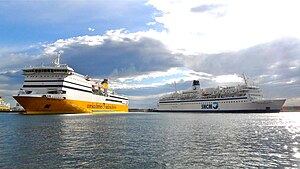
From mainland France, the quickest sailing is the NGV (High Speed Boat, Navire à Grande Vitesse), which takes about 3 hours to sail from Nice to Calvi , l'Île-Rousse, Ajaccio and Bastia . Regular car ferries, taking 6-8 hours, run from Marseille , Nice and Toulon . From Italy, ferries run from Genoa , Livorno , Savona , and Naples ; and from Santa Teresa Gallura on Sardinia . The main operator is Corsica Sardinia Ferries [dead link] , while other companies include La Méridionale and Moby Lines . All these ferry rides give a great view of the mountainous coast on approach, and all the arrival ports are located within towns.
By plane [ edit ]
There is no public transport from Corsica's airports, except for Bastia which has a bus between town and the airport every hour or two. For the others, you may have to rent a car.
Get around [ edit ]
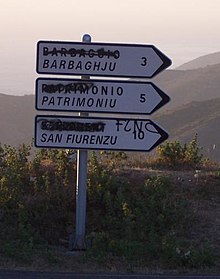
By car [ edit ]
Car is the simplest way to get around this rugged island, as public transport is limited and the hills are formidable. Many people arrive by ferry and take their own car onto the island. Rental cars are available from airports and ferry ports, but do book ahead. Supermarkets do not generally have petrol stations, so make sure you have a decent reserve before embarking on a longer trip. The roads are often twisty and don't allow high speeds, but the road surface is mostly in good repair even in the mountains - except where, all of a sudden, it isn't. Signposting is good, but you may benefit from Satnav (GPS) in the towns, as traditional little blue French street signs are hard to read from a moving vehicle. Place names are given in French and Corsican: Corsican activists have diligently painted out the French, but you should have no difficulty recognising the Corsican names.
By bus [ edit ]
Buses run along the south-west coast from Ajaccio to Bonifacio and Porto Vecchio, taking 3 hours. In July and August these run three times a day, 7 days a week; the rest of the year it's twice a day, Monday to Saturday. Along the east coast they run from Porto Vecchio to Bastia, taking 3 hours. They run twice a day, 7 days a week mid-June to mid-September, and Monday to Saturday the rest of the year. A same-day connection between Bastia and Ajaccio is possible with a two-hour layover at Porto Vecchio. The operator is Rapides Bleues but a more intelligible timetable is posted on the unofficial website Corsica Bus . The cities have buses to their neighbouring mountain villages, but there's no cross-island bus between Ajaccio and Corte and onward to Bastia - take the train.
By train [ edit ]

France is the land of the sleek TGV, but in Corsica those initials stand for "Train à Grandes Vibrations" - or "U Trinighellu" (the shivering one) as it's locally known. However it's your best public transport option between Ajaccio, Corte and Bastia, as those inter-city buses have been axed.
Trains are run by CF-Corse , a subsidiary of SNCF; investment in 2010 improved the rolling stock and rail infrastructure but it's still a rumbling, rattling ride. The network is non-electrified single track built in metre gauge, twisting and straining across the steep mountain terrain. The network forms a Y-shape: the line runs from Ajaccio north through Corte to the junction at Ponte Leccia, whence the northern branch continues to Bastia while the western branch runs through L'Île-Rousse to Calvi.
CF-Corse provides current timetables in PDF format in French and Corsican. However, these are not posted on Voyages SNCF, so they're not visible to other websites that draw from these, such as Deutsche Bahn. The best English language source is the unofficial website Corsica Bus , which covers all transport modalities. The train between Ajaccio and Bastia takes almost four hours and costs €21.60; there are 6 per day Monday to Friday, 5 Saturdays, 2 Sundays, all direct. Between Bastia and Calvi takes about 3 hours and costs €16.40; there are two trains every day of the week, some with a change at Ponte Leccia. Between Ajaccio and Calvi takes 4.5 hours and costs €25.10, with two trains every day, both with a change at Ponte Leccia.
These are all regional trains - the same as TER in France - so there's no advance booking, just buy your ticket at the station and hop on. The fares cited are full tariff. Some concessions and passes are available, e.g. the "Pass Libertà" which is €50 for unlimited travel on 7 consecutive days, so you'd have to cover the entire network and return to your start point to benefit. SNCF passes and reductions are not valid in Corsica.
Bikes are generally banned on trains as of 2022, with the exception that according to CF-Corse's FAQ , passengers may carry folded bikes in a bag for €15.
See [ edit ]
As the island was so often fought over, the main towns were heavily fortified. So they typically contain a walled citadel and old harbour, often pedestrianised, and dotted with restaurants and bars. The finest citadel is Bonifacio; arguably the most charming old harbour is Bastia. Ajaccio as the chief city has less old-world charm but has the best museums and galleries.
The Gulf of Porto is a World Heritage Site. From Porto Plage you can take a boat trip to view the Calanche de Piana, Capo Rosso, Girolata, and Nature Reserve de Scandola. Prices are €60-70 as of 2022, and tours depart around 11am. You can take a shorter tour for less money.
Do [ edit ]
Water sports are available in all the main ports, e.g. windsurfing and kitesurfing . Scuba diving is mainly conducted in the south of the island, Porto-Vecchio being a good centre. Expect to pay around €45–€60 for a one-tank dive.
Long-distance walking [ edit ]

Corsica has many walking trails. All require the use of topographical maps , despite usually excellent trail marks. IGN maps are the most detailed, and are similar to Ordnance Survey maps in Britain and Ireland. IGN maps may be found in many of the bigger cities, and at the airports, including Bastia airport. Additionally, you can purchase these maps (more expensively) from the internet ahead of time, and in some specialist map shops around the world.
- GR 20 — perhaps the best known and most difficult of all the Grande Randonnée trails. This trail takes approximately 17 days if using the traditional waypoints, though it may take more or less time depending on your experience and needs. The trail is particularly crowded in August; many people suggest the best time is in late spring or early autumn. The greatest danger on the GR 20 arises from the intense summer storms, with lightning claiming the most fatalities.
- Mare e Mare Nord ( Sea to Sea North ) — Cargèse to Moriani-Plage. Suggested time: 11 days. This trail intersects with one of the Mare e Monti Trails. The trail is only lightly travelled from Corte to Moriani, as this is the less interesting half, with uniform scenery, and gîtes that may not be open unless you call first.
- Mare e Mare Sud ( Sea to Sea South ) — Porto-Vecchio to Propriano . Suggested time: 5 days. This is considered an easier trail than the others on the island.
- Mare e Monti ( Sea and Mountains ) — Calenzana to Cargèse. Suggested time: 10 days. This trail includes the beautiful fishing village of Girolata, which has no road and is only accessible by boat from Calvi or on foot.
Buy [ edit ]
Corsica is well-known for its artisanry, included olive wood-handled knives and jewellery made using a lively red local coral. Local food products such as charcuterie, preserves and biscuits are other commonly-bought souvenir items.
Eat [ edit ]

Corsican food has French and Italian influences but also has many unique dishes of its own.
Many villages have small shops where locally produced food is sold. That said, it may be difficult to find a restaurant that prepares true Corsican dishes, and you may find yourself eating at tourist-oriented pizzerias, which nonetheless serve excellent food.
Drink [ edit ]

Wine [ edit ]
Corsica has a commercial wine industry, and heritage dating back to the Phoenicians. The techniques employed in Corsica have more in common with Italian than French winemaking traditions. The island has an impressive nine appellations d'origine contrôlée (AOCs), and most wines use nielluccio, sciacarello and vermentino grapes.
Beer [ edit ]
Corsicans brew a wide selection of local beers . which have a very distinct taste that you won't find anywhere else in France. It's highly recommended to try "Colomba", "Pietra" or "Bière Torre" when visiting.
Cola [ edit ]
Stay safe [ edit ].
Notwithstanding the notorious mafia , Corsica is usually a very safe place, especially for tourists. Going out at night in the towns and villages will not be a problem. Be polite and respectful, and there is nothing to worry about.
Respect [ edit ]
Compared to much of France (especially Paris ), the Corsicans are generally hospitable, sociable, patient, and welcoming.
The Corsicans are a separate ethnic group. They are neither French nor Italians. Keep that in mind when conversing with local people, and be wary of saying that you are in France when visiting the island.
Because of its turbulent, often violent history, Corsica is often portrayed as dangerous and unsafe. Never perpetuate this portrayal; Corsicans will be incredibly offended.
Dress smartly and conservatively; doing so will garner you respect from the locals.
Be careful with your words, emotions, and actions — Corsicans are rather sensitive to negative feedback.
Although the Corsican language is somewhat similar to Italian, never say that it is a dialect of Italian or variations thereof; it can be construed as offensive.
Stinginess is frowned upon in Corsica. The island is highly dependent on tourism and Corsicans expect you to make the most out of your visit. Not doing so will result in you being made fun of (the most common terms are les mangeurs de tomates or pumataghji ) or ridiculed.
Steer clear of discussing Corsican nationalism , Corsican independence , the FLNC, and politics in general . These subjects are certainly much debated and are complex, sensitive, and divisive. In March 2022, riots across the island broke out when a Corsican nationalist leader was beaten to death in prison. The Corsicans are divided into several opposing camps – some who desire full independence from France, some who desire more autonomy, and some who are happy with the area's current status in France.
Go next [ edit ]
By sea, your choices are as listed in "Get in":
- the French mainland: Nice , Toulon and Marseille ;
- the Italian mainland: Livorno and Genoa ;
- Sardinia : Santa Teresa Gallura
The route to Sardinia opens up an intriguing mid-Med hopscotch : you could traverse Sardinia to its southern port of Cagliari , from there sail to Palermo in Sicily , and from there onward to Malta or Tunisia , all without returning to the European mainland.
- Has custom banner
- Has mapframe
- Maps with non-default size
- Has map markers
- Articles with dead external links
- Eat listing with no coordinates
- Drink listing with no coordinates
- Has Geo parameter
- All destination articles
- Usable regions
- Usable articles
- Region articles
- Bottom-level regions
- Pages with maps
Navigation menu
- Skip to main content
- Skip to secondary menu
- Skip to footer
ZigZagonEarth
Plan unforgettable road trips!
Corsica Travel Guide (France)
Corsica, France is one of the most beautiful islands in Europe with breathtaking scenery from Mountain to Sea. Below is my Corsica Travel guide to help you plan your ideal itinerary including the best places in Corsica (especially beaches), a road trip guide and plenty of photos and video to make you dream of your next trip!
MAKE THE MOST OF YOUR TIME IN CORSICA!
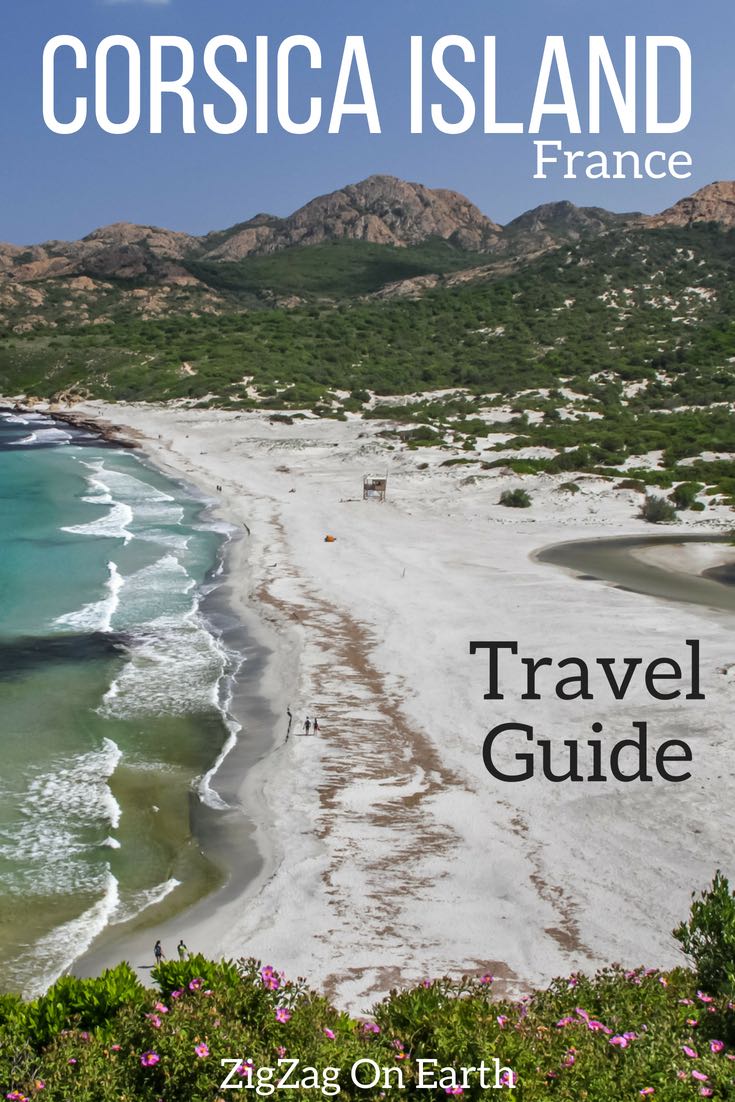
This article contains affiliate links ( Disclosure page ). If you purchase using my link, I get a commission at no extra cost to you.
Corsica Travel Guide written by Claire , the ultimate Travel Planning Geek
"With the Zigzag Travel Guides, Planning is half the fun of Traveling"

All the articles are now redirecting to my regional website dedicated to my home region: Normandie. You will find even more content to help you plan your amazing trip!
CorsicaLovers.fr
Best things to do in Corsica
Discover general articles about the best destinations and best things to do in Corsica. Get inspired to visit this magnificent French island with many landscapes from mountains to sea displaying unbelievable colors! The whole island is magnificent with breathtaking scenery everywhere you look. You won't get bored! Here are the best places in Corsica:
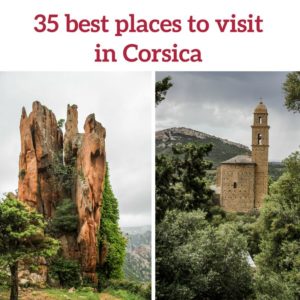
Best Places to visit in Corsica - Tourism
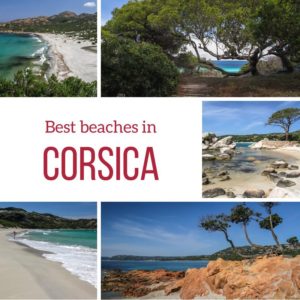
Best beaches in Corsica
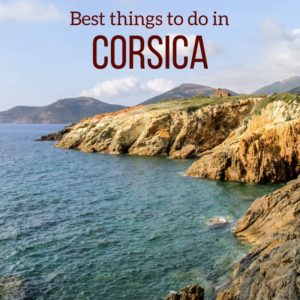
35 pictures of Corsica - Landscapes and Culture
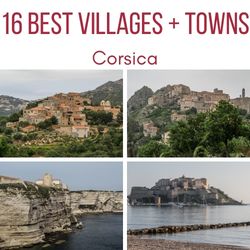
16 best villages and towns in Corsica
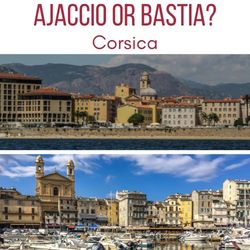
Ajaccio or Bastia?
eBooks Travel Guides
Plan your dream road trip around Corsica!
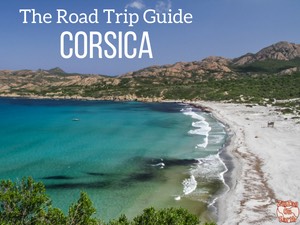
- 7 easy-to-plan maps
- 130+ pre-selected locations
- Planning tips
- 220+ large photos
- GPS coordinates direct to carparks
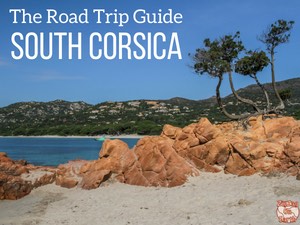
- 5 easy-to-plan maps
- 85+ pre-selected locations
- Planning tips
- 150+ large photos
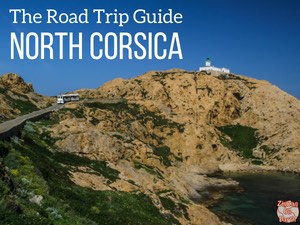
Corsica Travel Guide - How to Plan your Trip
Below are my articles to help you define your ideal itinerary, get ready to drive in Corsica, plan your accommodations, pack and have a fantastic trip!
Here is a map to help you understand where Corsica island is located in the Mediterranean Sea, South West of France. You can also get a better understand of where the main towns and roads are (Detailed maps designed to help planning are available in the eBooks .)
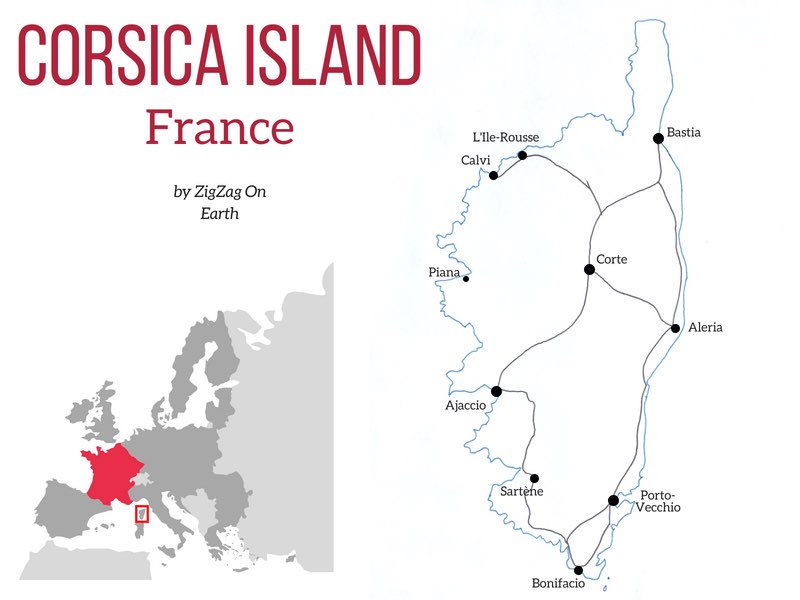
How to plan your Corsica Road Trip
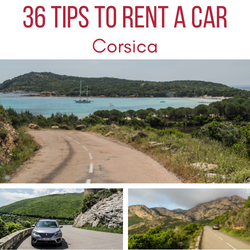
How to rent a car in Corsica
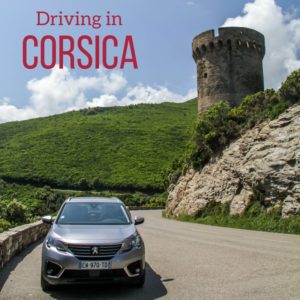
Driving in Corsica
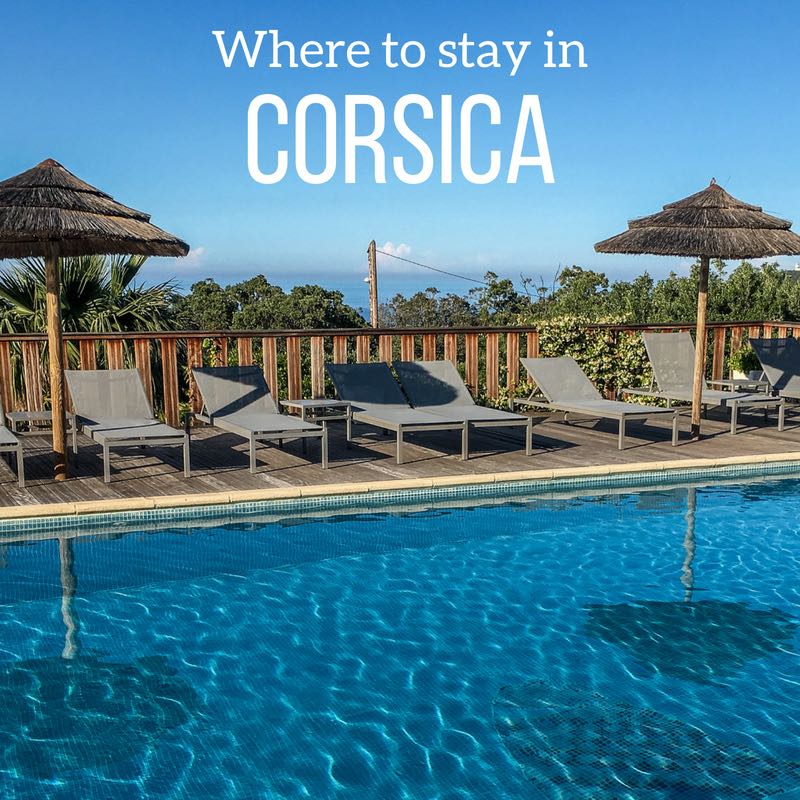
Where to stay in Corsica
Need to rent a car in Corsica? My tips:
- Compare prices on my favorite platform: Discovercars.com - one of the best rated comparison sites!
- Choose the car and company you prefer (not too big but with enough power for mountain roads)
- Consider their full coverage option - I always take it for peace of mind!
- Book early to have a large choice of vehicles!
See my 36 tips about renting a car in Corsica
Best places in North Corsica
Below is your North Corsica Travel guide with some of the best places to see in the region - stunning wild beaches, a desert, a Citadel, the villages of La Balagne... and the Unesco Reserve around the red calanques of Piana and the Scandola peninsula. Unmissable when visiting Corsica!
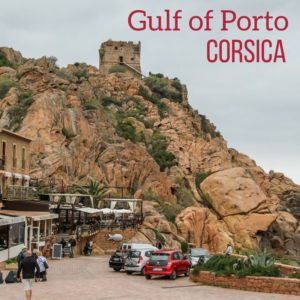
Things to do in the Gulf of Porto Corsica
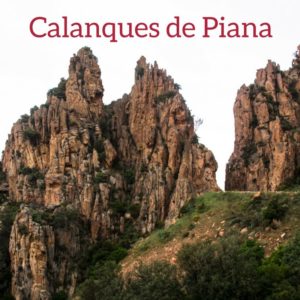
How to visit the Calanques de PIana Corsica
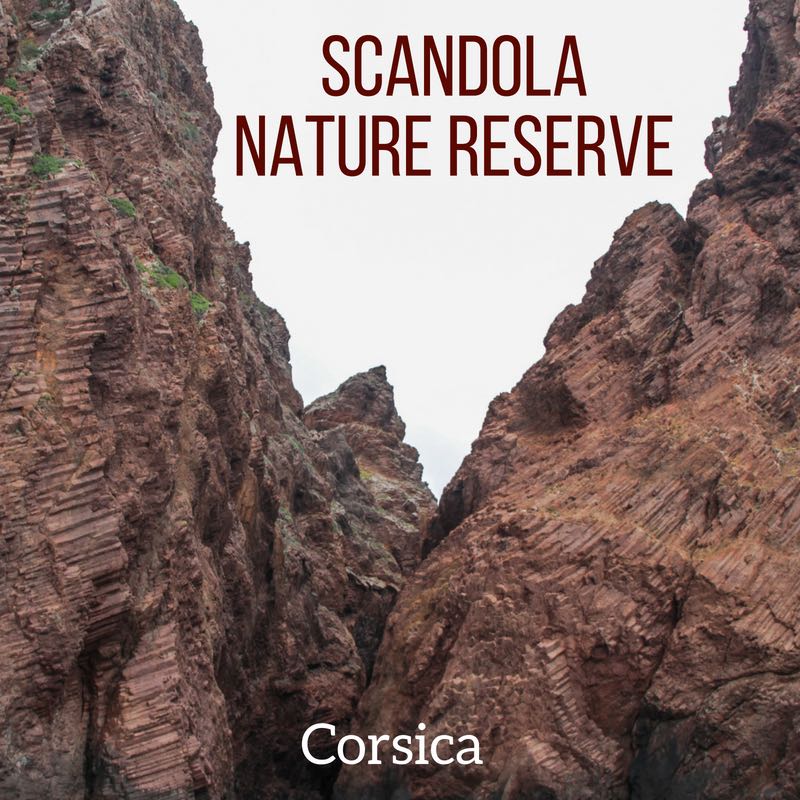
Scandola Nature Reserve Corsica
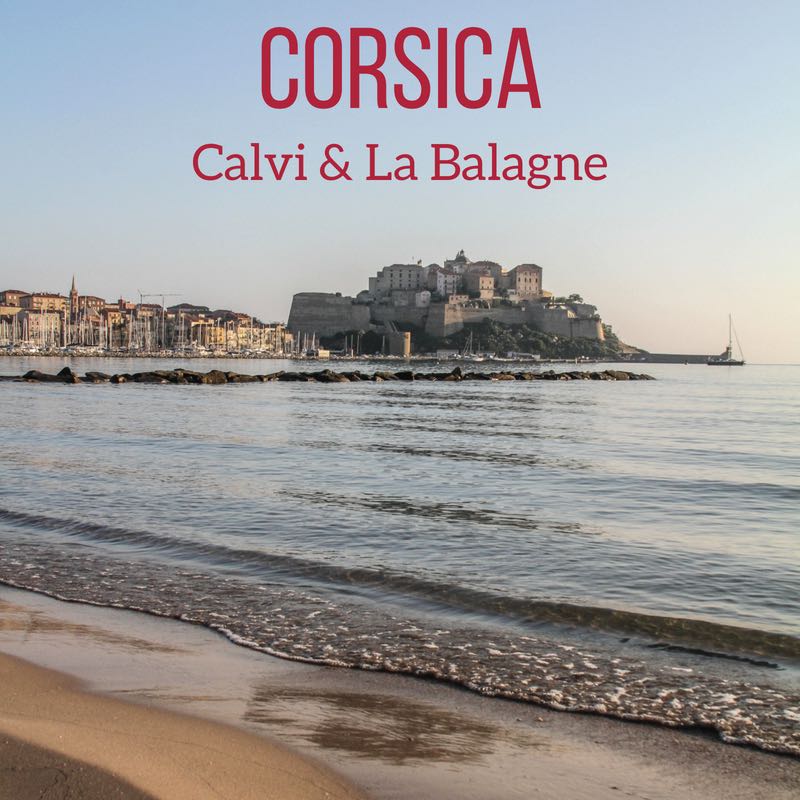
Things to do in Calvi Corsica & La Balagne region
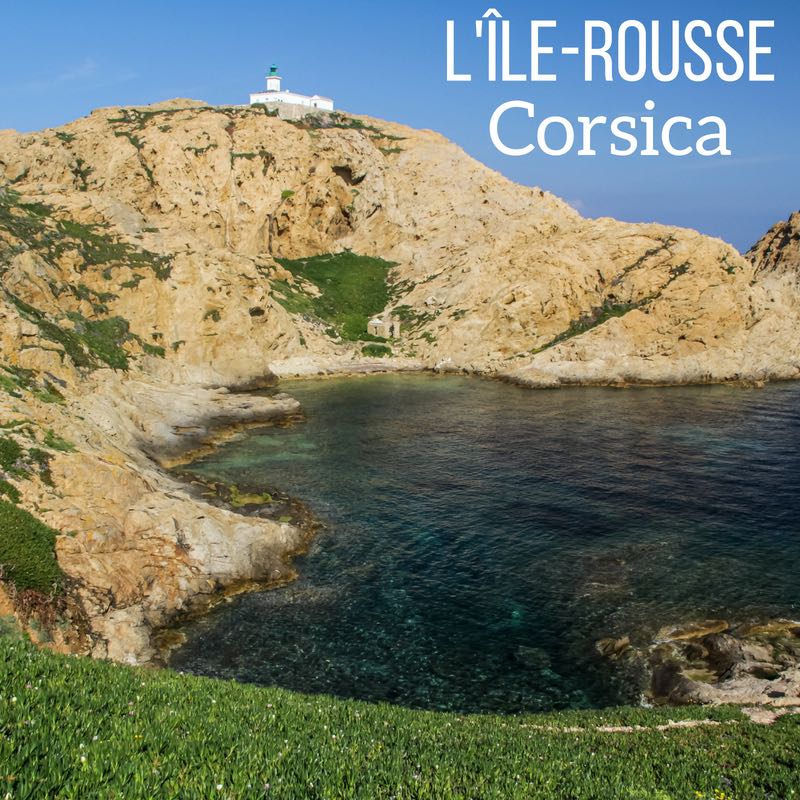
Things to do in Ile Rousse Corsica
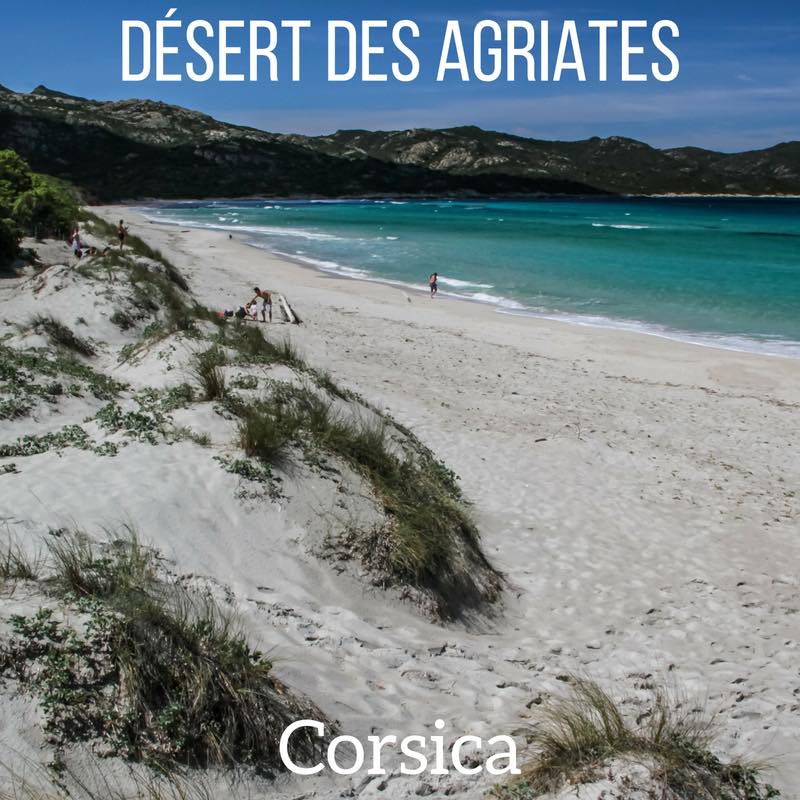
Saleccia Beach + Agriates Desert Corsica
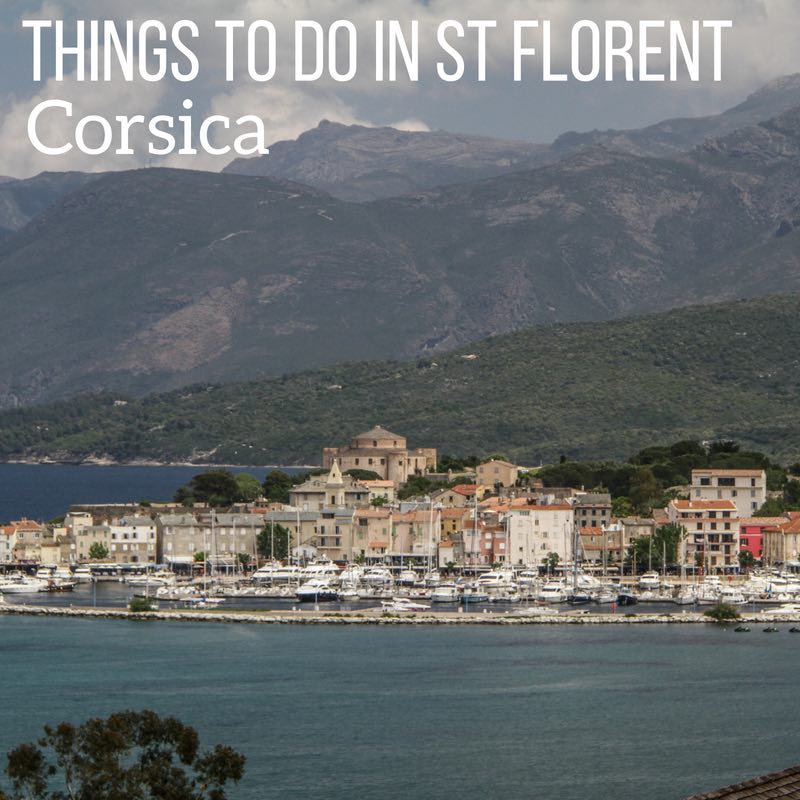
Things to do in Saint-Florent Corsica
Magnificent Cap Corse Tour
At the North end of Corsica is the magnificent Cap Corse. It is a unique destination with charming villages, beaches with gold or black sand and mountains plunging into the sea. It offers some of the most breathtaking views on the island.
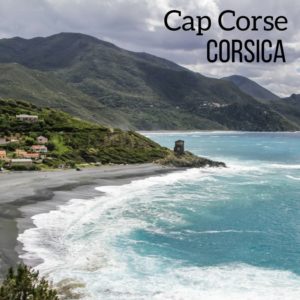
Drive around Cap Corse Corsica
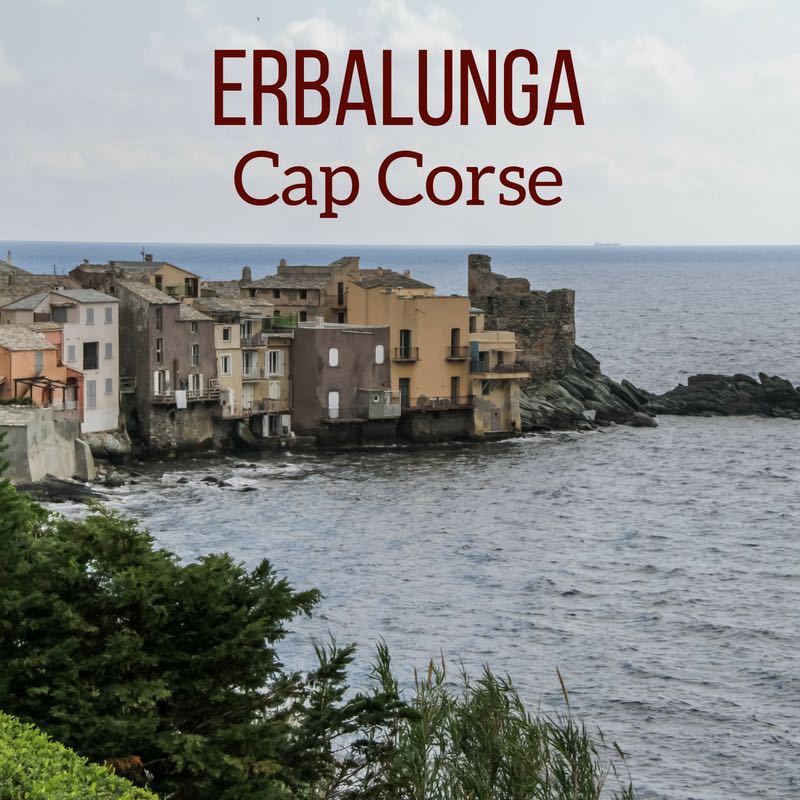
Village of Erbalunga Corsica
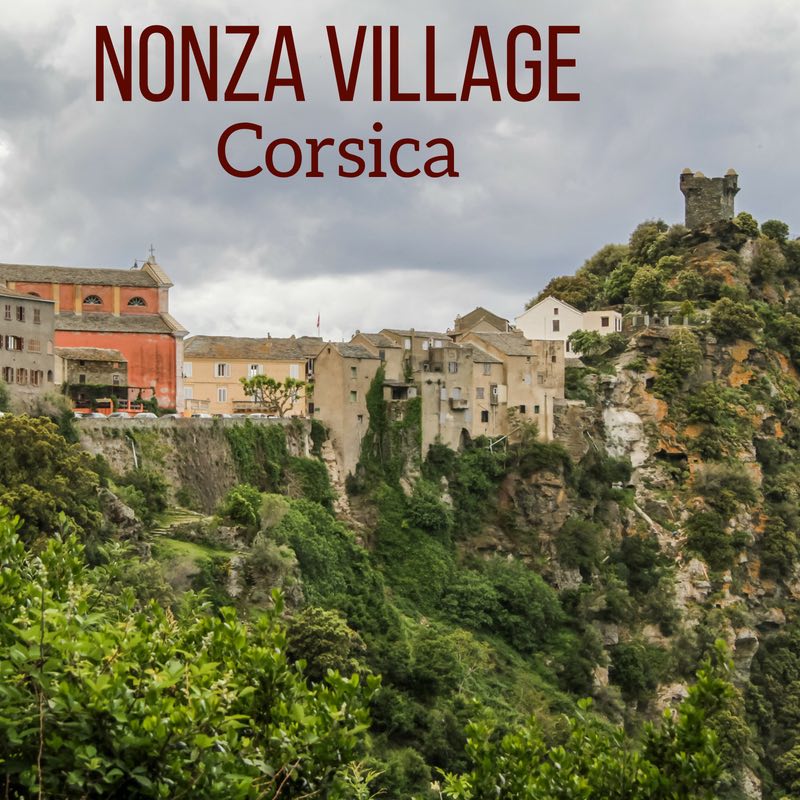
Village of Nonza Corsica
Best places in South Corsica
And now we head to South Corsica famous for its paradise-like beaches such as Rondinara or Palombaggia. But you can also discover great mountain roads, gorges and villages for a more varied holiday in Corsica. Don't miss the famous town of Bonifacio built at the edge of white cliffs. Quite impressing!
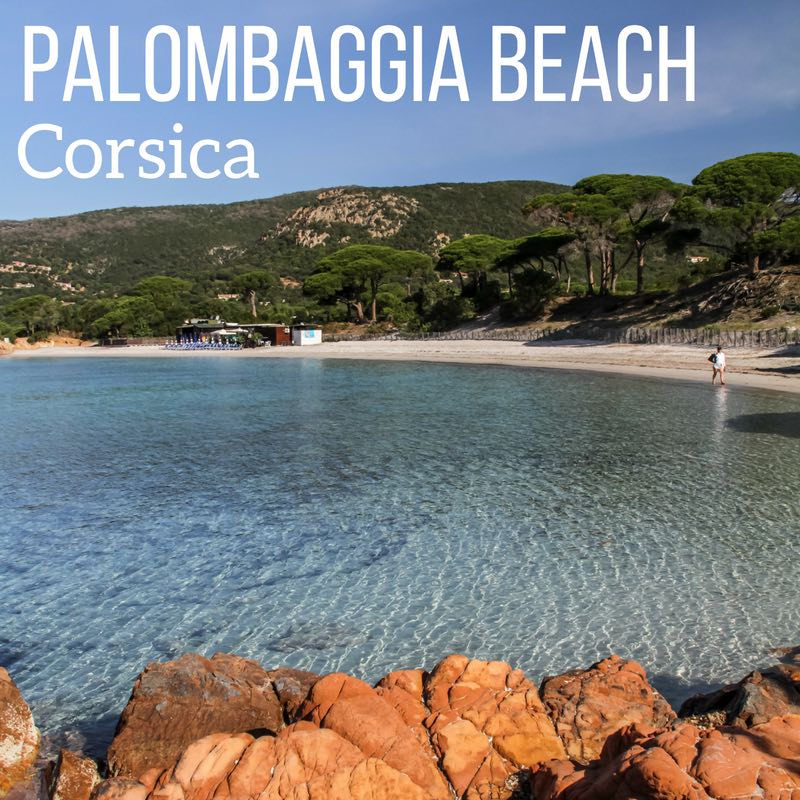
Palombaggia Beach Corsica
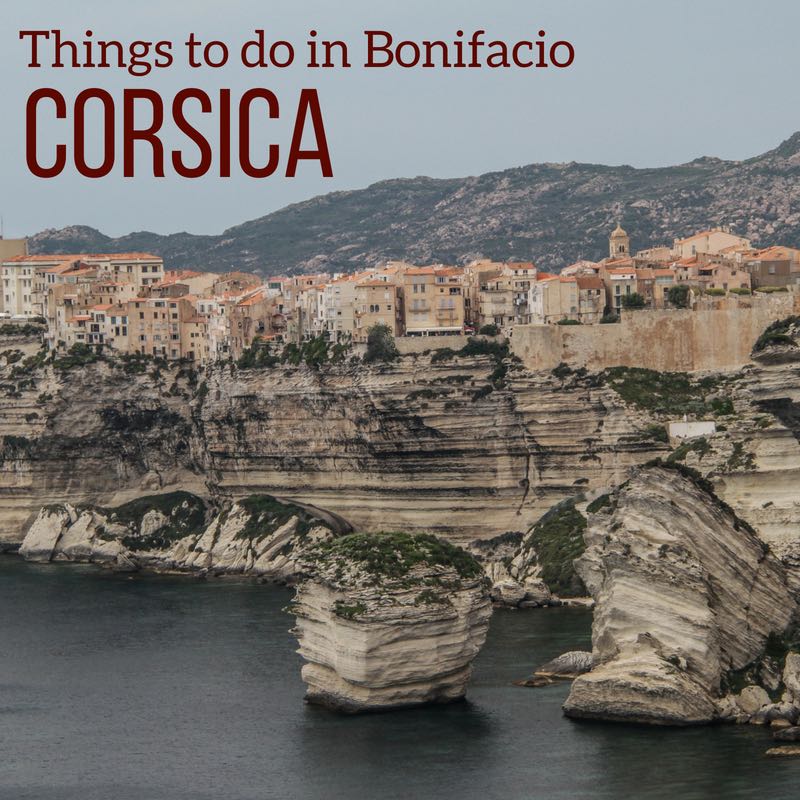
Things to do in Bonifacio Corsica
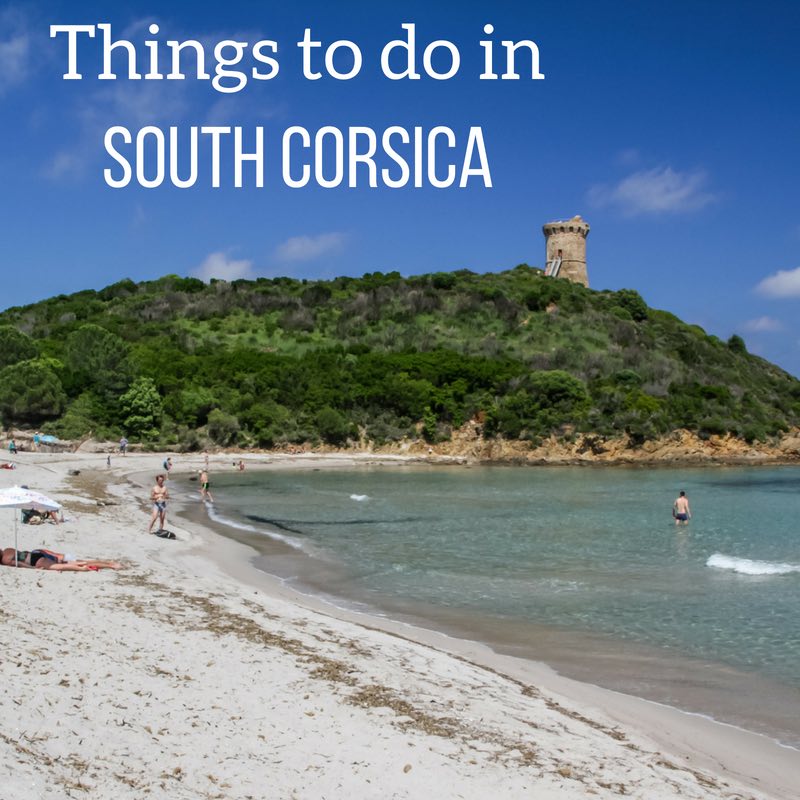
Things to do in Porto-Vecchio & South Corsica
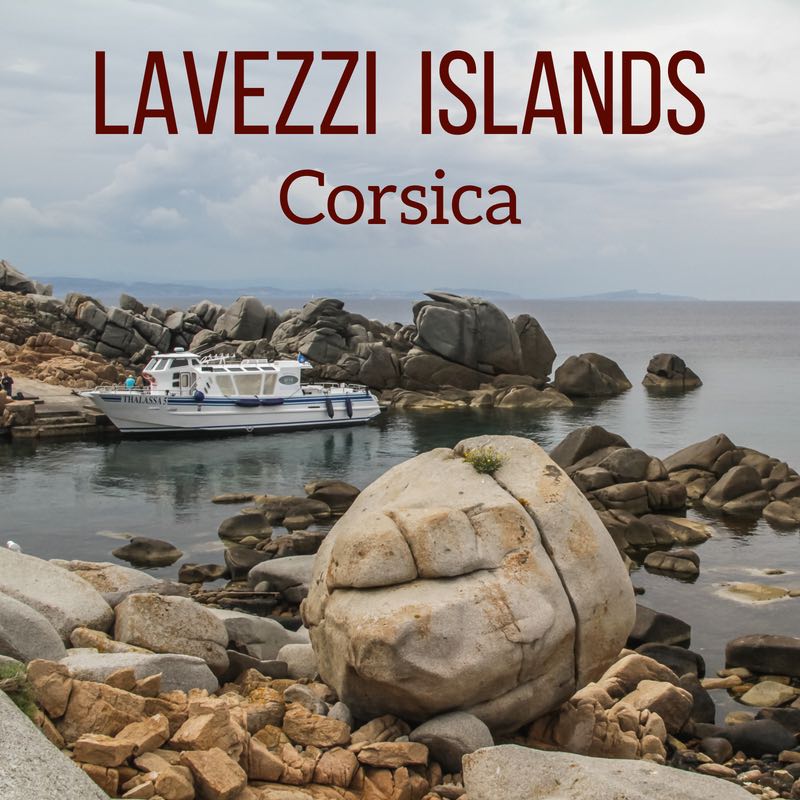
Lavezzi Islands Corsica
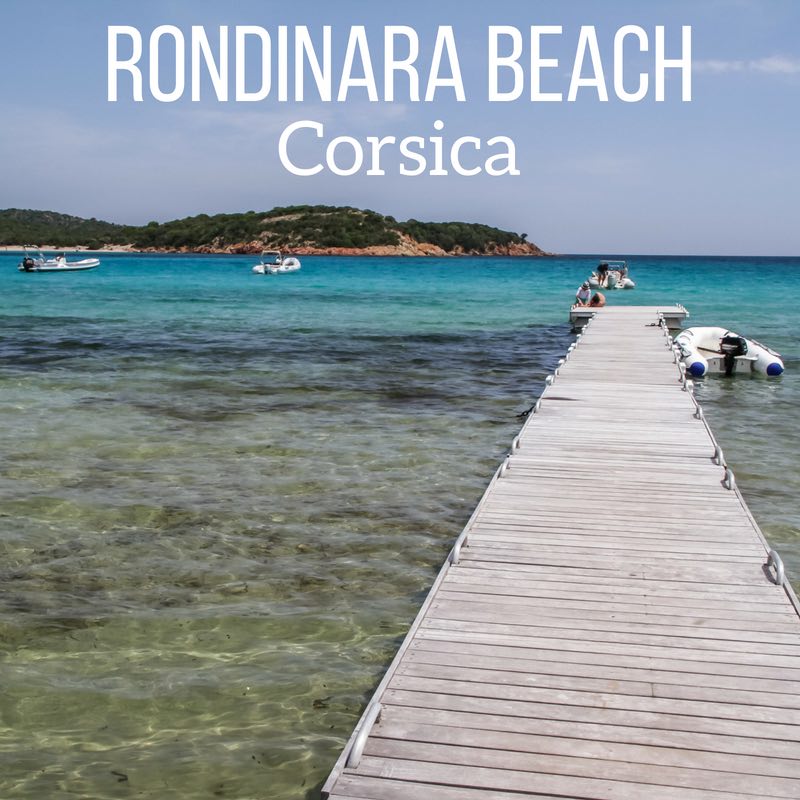
Bay of Rondinara Beach Corsica
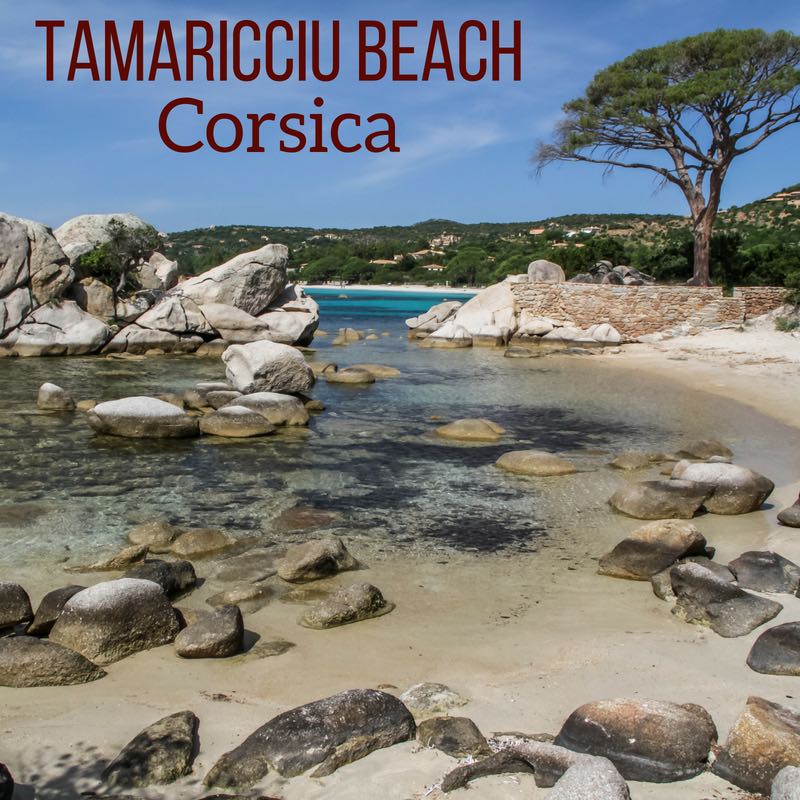
Tamaricciu Beach Corsica
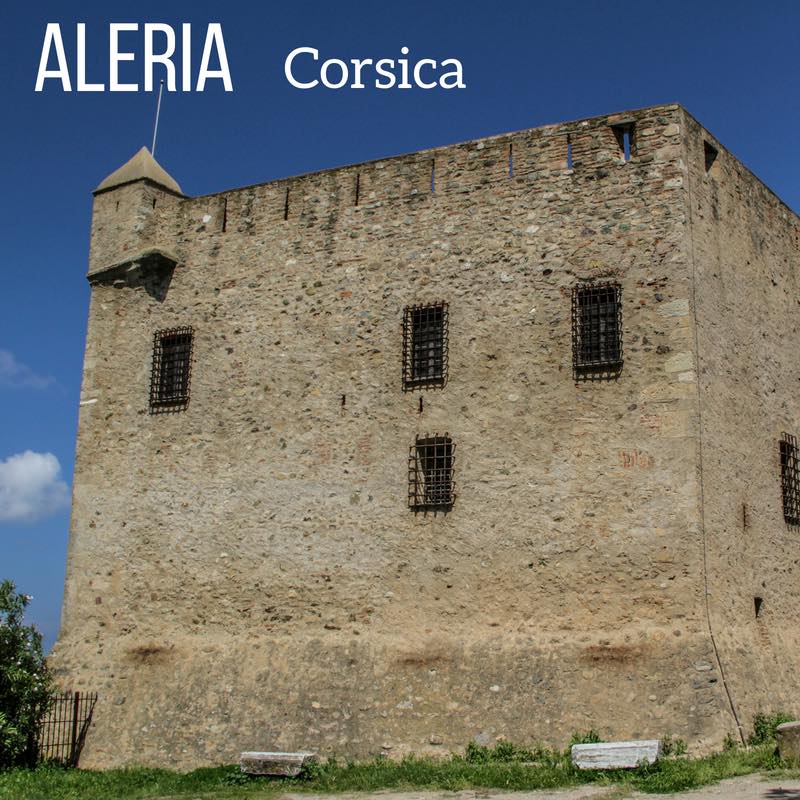
Aleria Corsica (Roman Ruins)

Corsican Mountains
The center of Corsica is mountainous all the way to 2,706 m (8,878 ft). It is a world of magnificent gorges and a hiker paradise. Its main town Corte has a long history and and one of the most breathtaking view in Corsica.
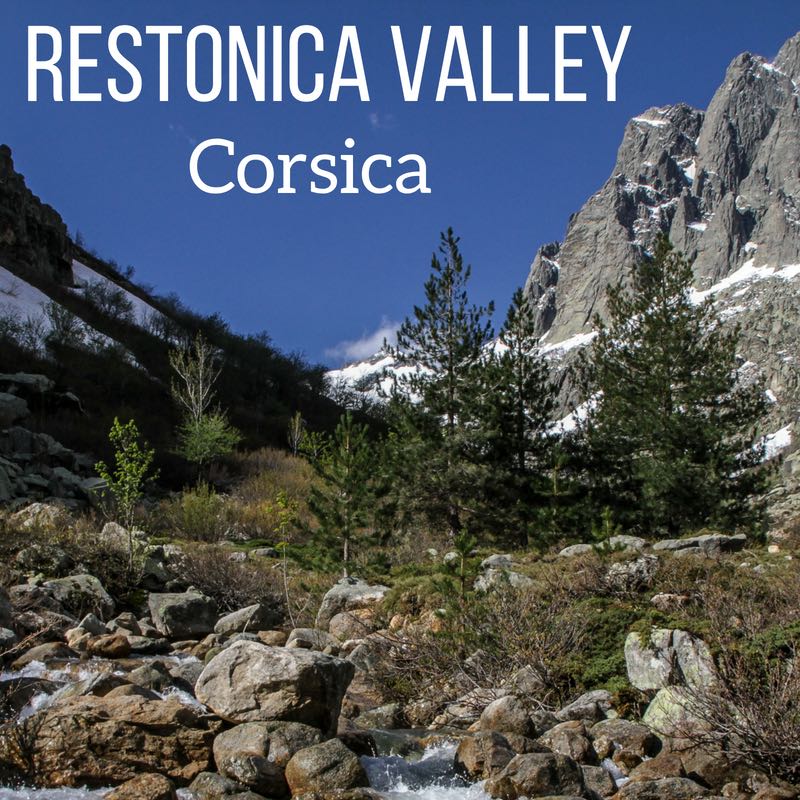
Restonica Valley Corsica
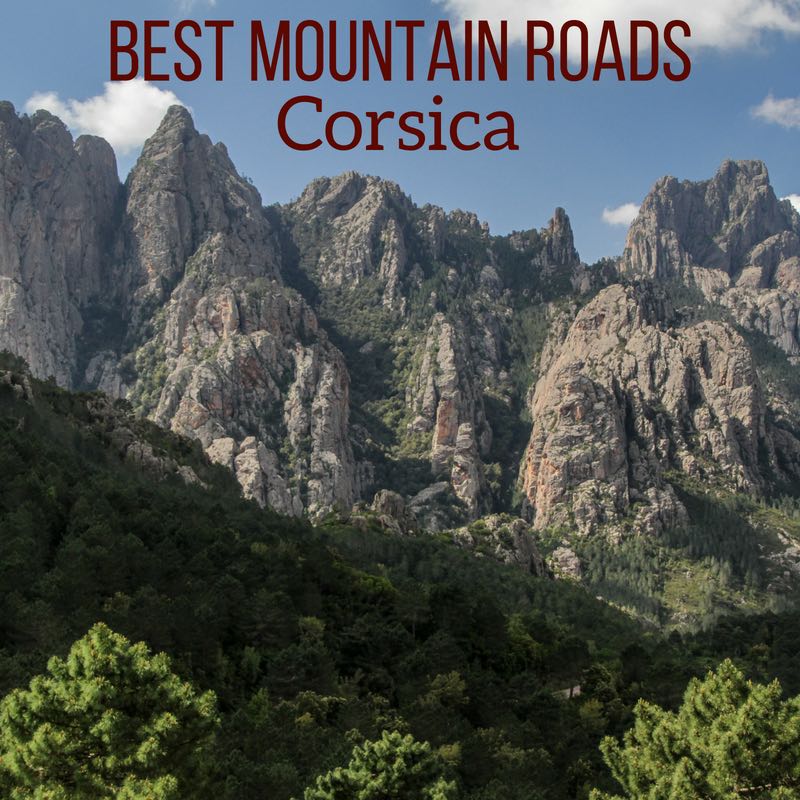
Corsica Mountains + best drives in Corsica
And keep track of your own trip!
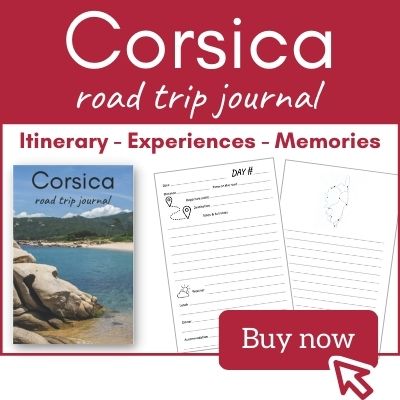
GENERAL TRAVEL TIPS
And below are some of my tips to help you have a wonderful trip!
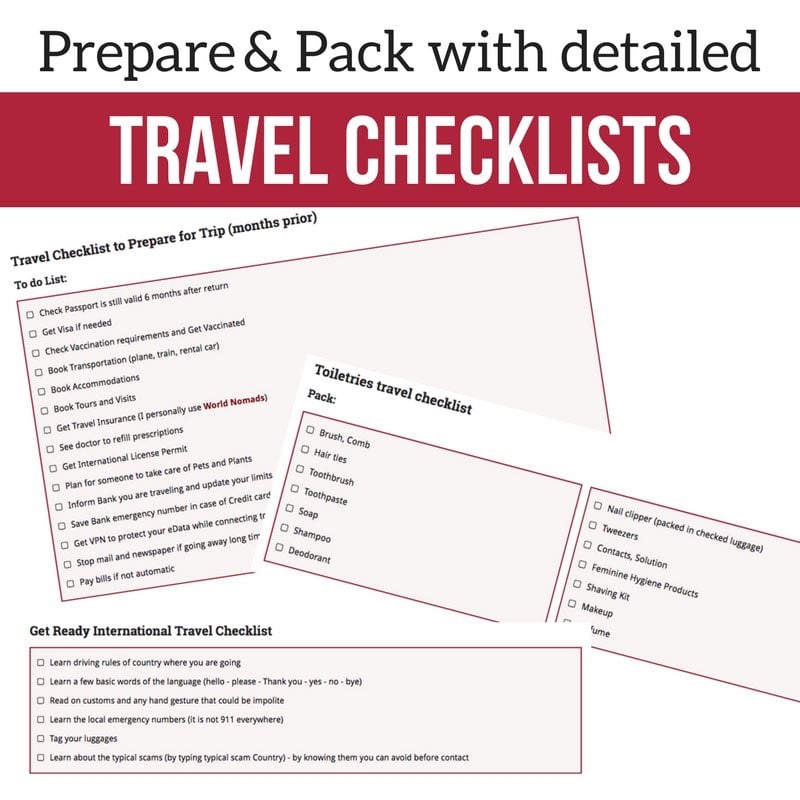
Travel Checklists and Must have travel items
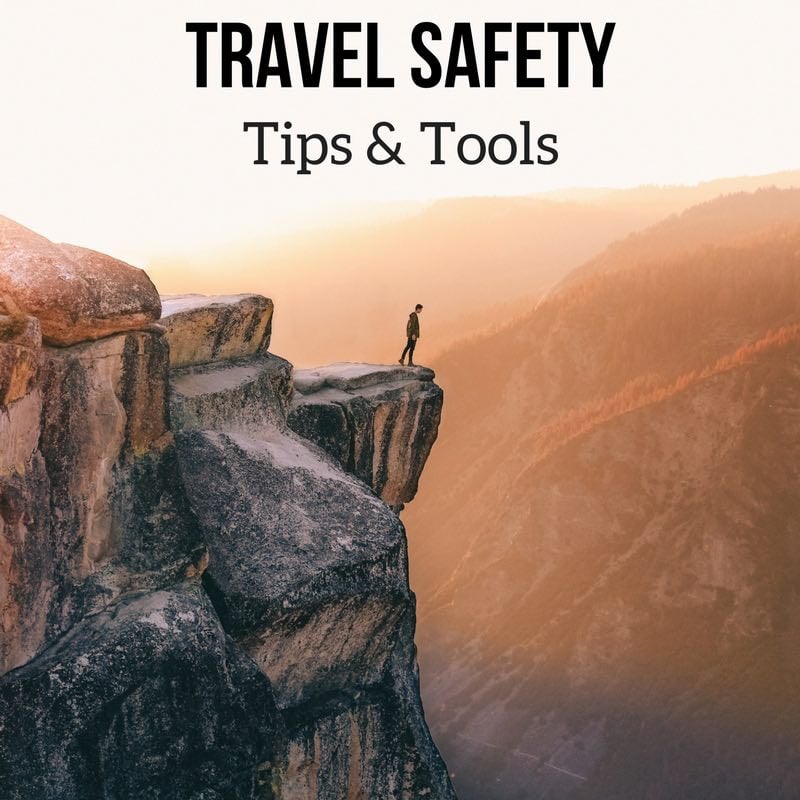
Travel Safety Tips
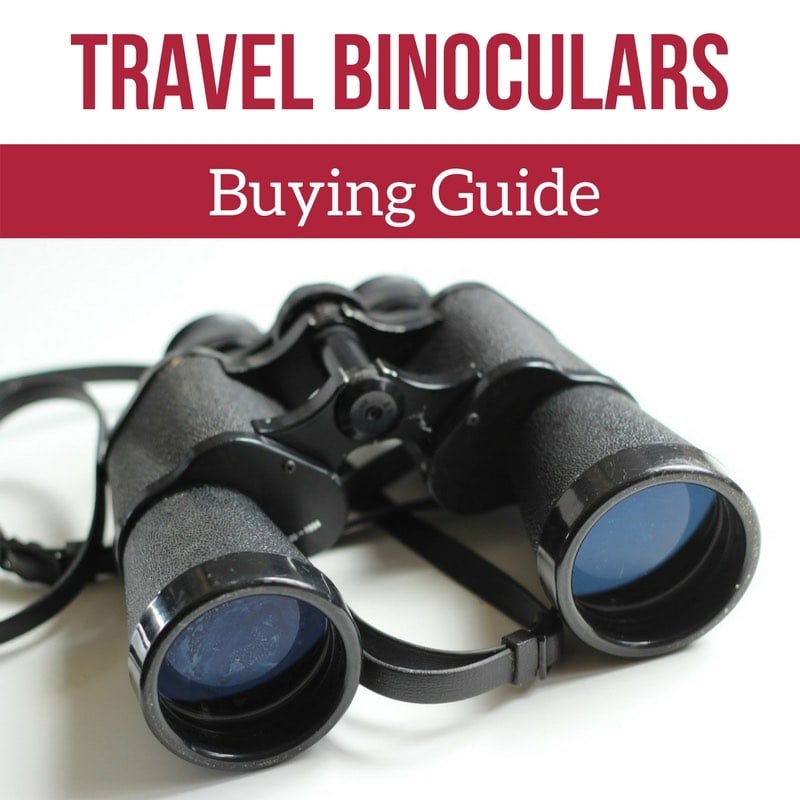
Best Travel Binoculars
Practical websites to Book your trip
BOOK YOUR ACCOMMODATION
- I personally use Booking.com for their large choice of both hotels and apartments, their real reviews and reductions for repeat customers - Book your accommodations via Booking.com
- I know that some of my Readers from the US and Canada favor Hotels.com for their repeat customer deals - Book with Hotels.com
- And for those you like to compare prices, you can have a look and book through Hotelscombined.com
PLAN YOUR ACTIVITIES
- DAY TRIPS - The other travel option I like to just seat and relax while admiring the scenery it to Book day trips and organized tours. I also like to have my tickets beforehand to save time. I personally use GetYourGuide.com and Viator.com
GET EQUIPMENT YOU NEED
- CLOTHES, SAFETY ITEMS, PACKING PRACTICAL ITEMS, LUGGAGE, ELECTRONICS... Get it on Amazon (US, UK and Canada only)
GET TRAVEL INSURANCE
- I wish you a very smooth trip, but my policy is: better be prepared. I personally use World Nomads. Get a quote online here .
PROTECT YOUR ELECTRONIC DATA
- Don't use unsecured wifi without a VPN service to avoid risking electronic theft - NordVPN is one of the best rated VPN services
Par Claire Robinson Region Lovers SARL 76600 Le Havre FRANCE VAT FR21845103191
Follow ZigZag on Facebook
Follow ZigZag on Pinterest
Website in French: ZigZagvoyages.fr
Website in German: ZigZagreisen.de
Website in Spanish: ZigZagviajes.com
And discover the French regions:
Normandielovers.fr LoireLovers.fr CorsicaLovers.fr Provencelovers.fr
Privacy / Terms of Use / Disclosure Policies / Refund policy
Become an affiliate for the ZigZag road trip guides
As an Amazon Associate I earn from qualifying purchases. ZigZagOnEarth.com is a participant in the Amazon Services LLC Associates Program, an affiliate advertising program designed to provide a means for sites to earn advertising fees by advertising and linking to Amazon.com, Amazon.uk and Amazon.ca

Touropia Travel Experts
Discover the World
18 Best Places to Visit in Corsica, France
Set within the shimmering azure waters of the Mediterranean Sea, Corsica is a beautiful island that offers plenty for the visitor.
Once ruled by the Greeks and Romans, the island is blessed with a rich history and culture. It is also famous for being the birthplace of Napoleon Bonaparte, as well as the former home of Christopher Columbus. So, numerous sites on the island reflect this legacy, including megalithic structures and medieval buildings that date back thousands of years.
However, Corsica is arguably best known for its fantastic white sandy beaches, which attract sunseekers from all over Europe. It also features a spectacular landscape that includes jagged mountains and lush forests. As well as plenty of pretty meadows, flowing rivers and a stunning coastline that is best explored on foot.
With so many places to visit in Corsica, it can be difficult to know what sites and destinations to prioritize viewing. For this reason, we’ve compiled this list of the island’s main highlights to provide you with the guidance you may need.
18. Speloncato
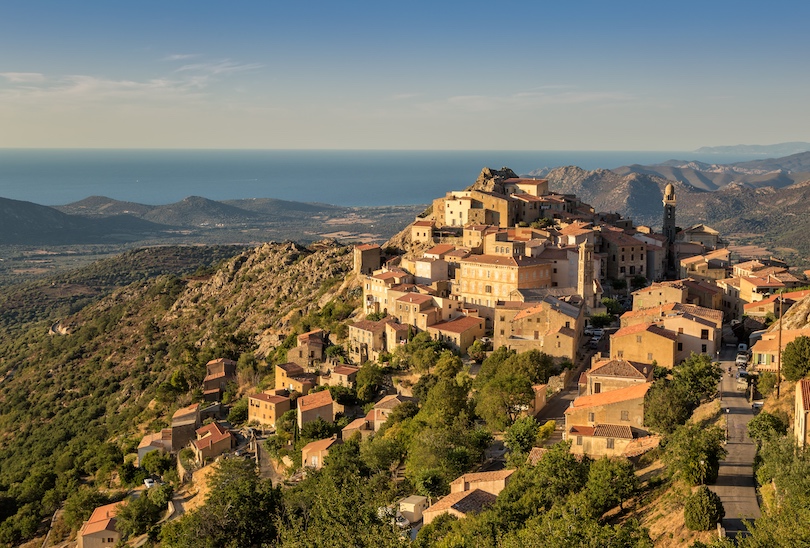
There are several villages in Corsica you can visit. But not many can match Speloncato for its sheer ambience, charm and aesthetic.
Situated within the Balagne region (more on that later), its most striking feature is that it is perched on a rocky outcrop some 570 meters above sea level. From afar, the contrast between its traditional houses and buildings and the granite rock they are set upon is very striking. But looking out from it, you also get to take in stunning views of the coastline and Reginu Valley.
The beautiful town features a labyrinth of tunnels, alleys and homes which are fun to explore. It is also far less touristy than other places, so you will be able to immerse yourself in an authentic slice of Corsica without the crowds.
17. Cap Corse
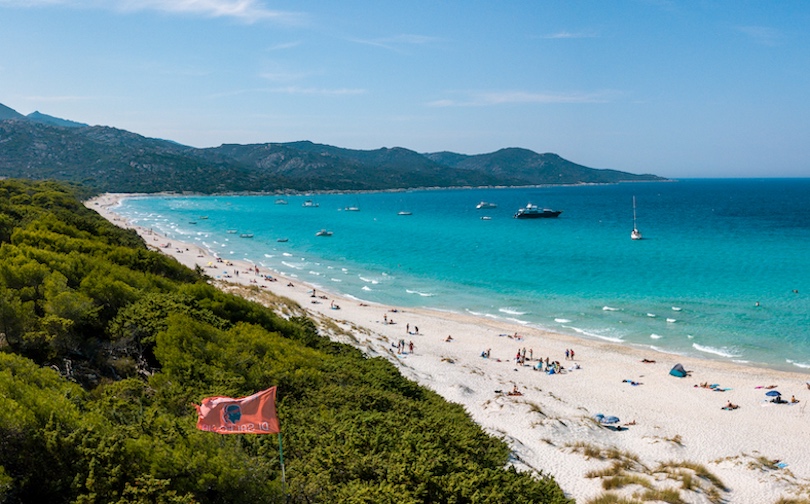
Cap Corse is a rugged and beautiful peninsula located in the northernmost part of Corsica. It is known for its stunning coastal views, picturesque villages, and unspoiled natural landscapes.
One of the main attractions of Cap Corse is its scenic coastal road. It winds its way along the cliffs and offers breathtaking views of the sea and surrounding landscape. The road is dotted with small villages and fishing ports, where visitors can stop and explore the local culture and cuisine.
If you only have time to stop at one of these villages, make sure it is Nonza. Situated on a hill overlooking the sea. It is known for its striking black sand beach and the ruins of a medieval tower that once protected the area from pirates.
16. Calanques de Piana
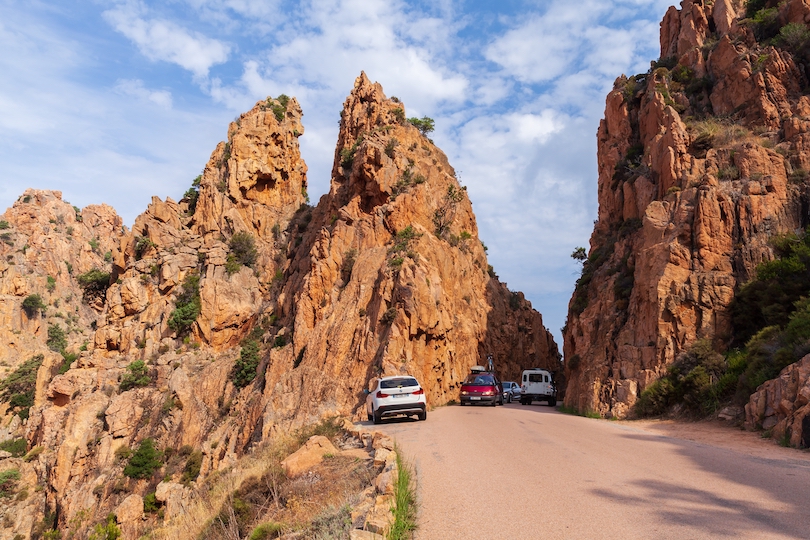
Calanques de Piana is one of our favorite natural sites in Corsica. Situated on the west coast, near the town of Porto, it is characterized by towering red granite cliffs and crystal-clear blue waters that captivate with their beauty.
One of the most stunning natural landscapes on the island, the UNESCO World Heritage site stretches for about five km along the coast. It consists of a series of narrow inlets or coves, which visitors can explore by taking a boat tour from Porto. Alternatively, they can drive along the scenic coastal road that winds its way through the cliffs.
What makes the area so appealing to us is that the cliffs are carved into unique shapes and formations. They include the famous ‘dog’s head’ and ‘heart’ geological formations, which add to the area’s overall mystique.
15. Filitosa
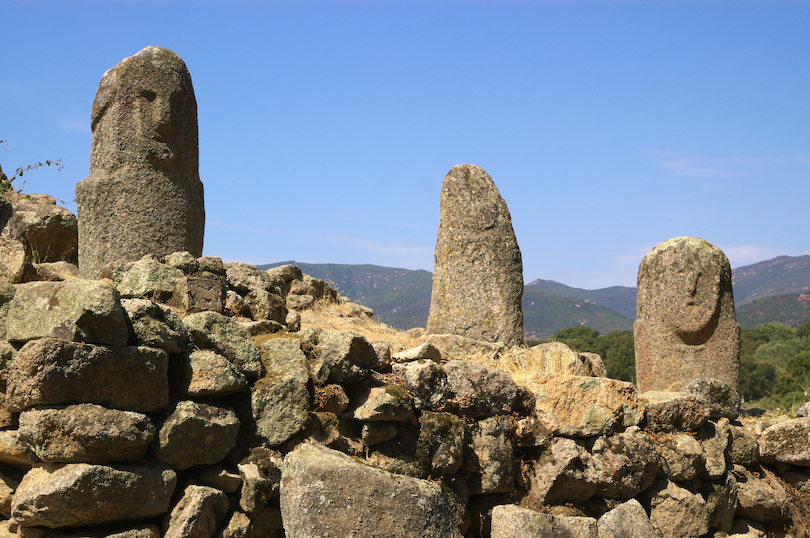
The Filitosa is one of Corsica’s most important archaeological sites. Situated near the town of Propriano, which resides on the southern coast, it contains several megalithic structures like standing stones and menhirs, as well as several ancient ruins.
The site dates back to the Bronze Age and is thought to have been inhabited by the Torréens, an ancient civilization that lived on Corsica between 2500 and 1000 BC. Believed to have been tombs or religious sites, the structures feature unique carvings and engravings that offer fascinating insights into their culture and beliefs.
One of the main attractions here is the row of standing stones known as the ‘menhirs of Filitosa’. They are impressive 3-meter tall stones that are carved with intricate patterns and symbols, including images of human faces and animals.
14. Propriano
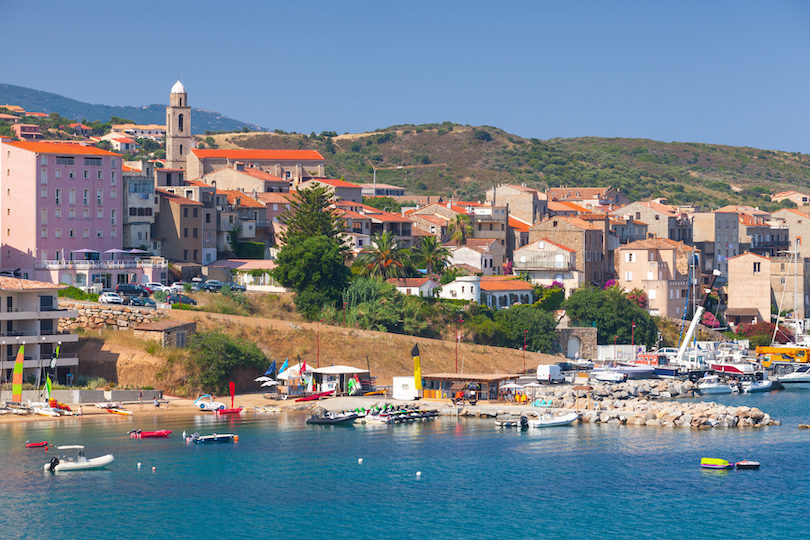
Situated between Ajaccio and Bonifacio, Propriano is a famous seaside resort known for its spectacular beaches, gorgeous natural landscapes and azure waters.
Dating back to the Roman era, the town has a rich history as it was also an important trading port during the Middle Ages. Today, it is a lively and bustling town that offers excellent restaurants and a good mix of shops to explore.
If you are feeling energetic, you can choose to venture onto several marked trails that flank the shoreline and take you to wild coves where you can swim. You can also explore the historic architecture of its old town.
13. Hike the GR20
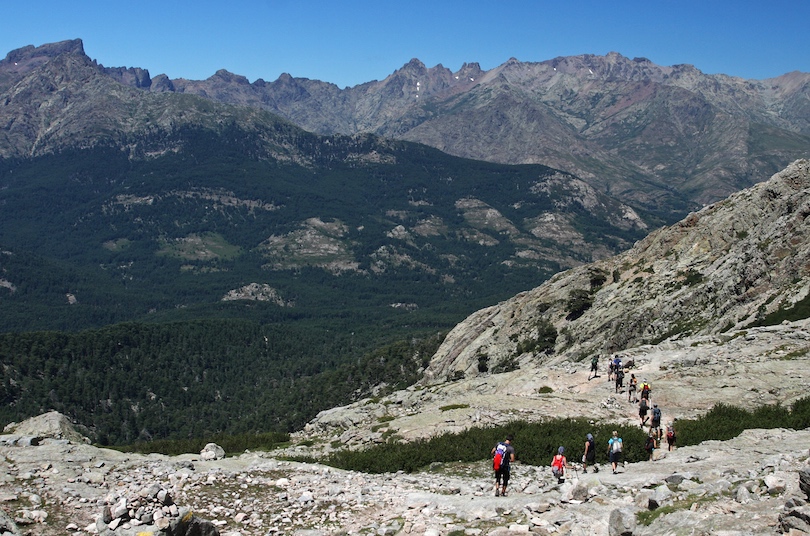
If you are a serious hiker, the GR20 is a must. One of the most popular and challenging hiking trails in Europe, it covers a distance of over 200 km. Starting in the northern town of Calenzana and ending in Conca in the south.
Along the way, it crosses the island’s mountainous spine, offering stunning views of rugged peaks, deep valleys, and beautiful forests. The trail takes between 15 and 16 days to complete, and there are several campsites and refuges on the trail.
Overall it is well-marked and maintained, although it is notoriously challenging, with steep ascents and descents, rocky terrain and unpredictable weather. Therefore, it is only suitable for experienced hikers, as it requires you to be in good physical condition.
12. Spelunca Gorge
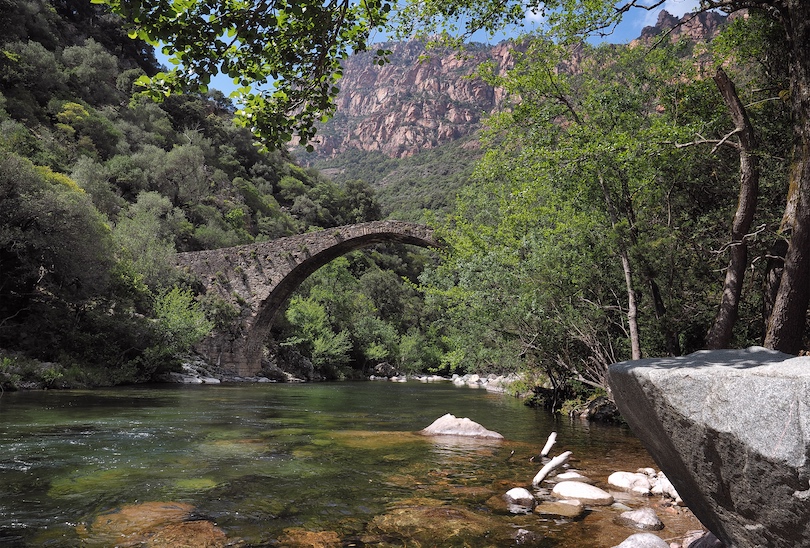
The Spelunca Gorge is a spectacular natural wonder located in the heart of Regional Natural Park. Also known as the Gorges de la Spelunca, it connects the villages of Ota and Evisa, and it is one of the most popular hiking destinations on the island.
Carved by the crystalline waters of the Fango River, the gorge features towering rock formations , narrow paths, and breathtaking views of the surrounding landscape. Its hiking trail extends for 12 km and takes most people around four to five hours to complete, so it is a good alternative to the GR20.
Along the way, you will get to see several ancient stone bridges, including the famous Zaglia, which is classified as a historical monument. You can also swim at various points along the trail and spot wildflowers and a diverse range of wildlife.
11. Saint-Florent
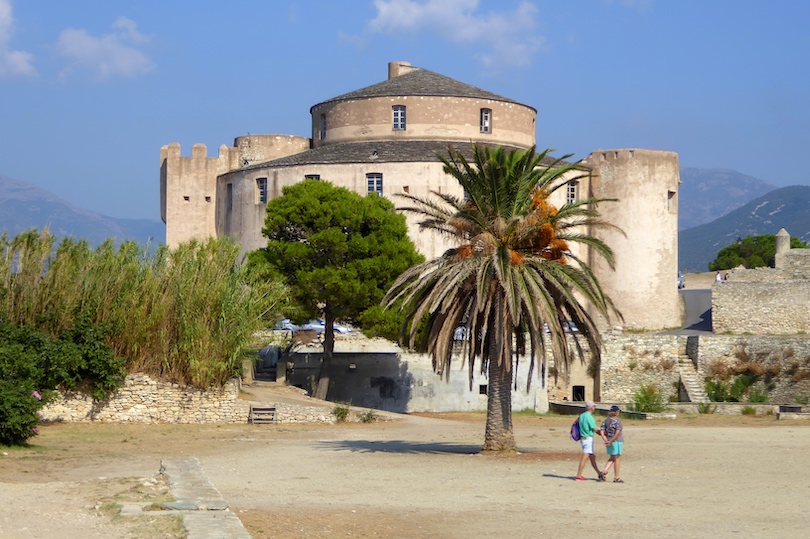
Often compared to Saint-Tropez, Saint-Florent is Corsica’s second-largest marina after Ajaccio.
Sandwiched between the mountainous wilds of Cap Corse and the spectacular, untouched Désert des Agriates, the charming town is known for being the gateway to some outstanding beaches. They include Plage de la Roya, Plage du Loto and Plage de Saleccia. All of which are easy to get to on foot or by boat and provide excellent places to sunbathe, swim and relax.
When we don’t fancy a day at the beach, one of our favorite things to do here is to walk along the port. There, we can make our way to the citadel via the village’s charming, narrow alleys. It has some lovely shops and cafes on the ascent, and the views of the shimmering waters of the Gulf of Saint-Florent are always breathtaking.
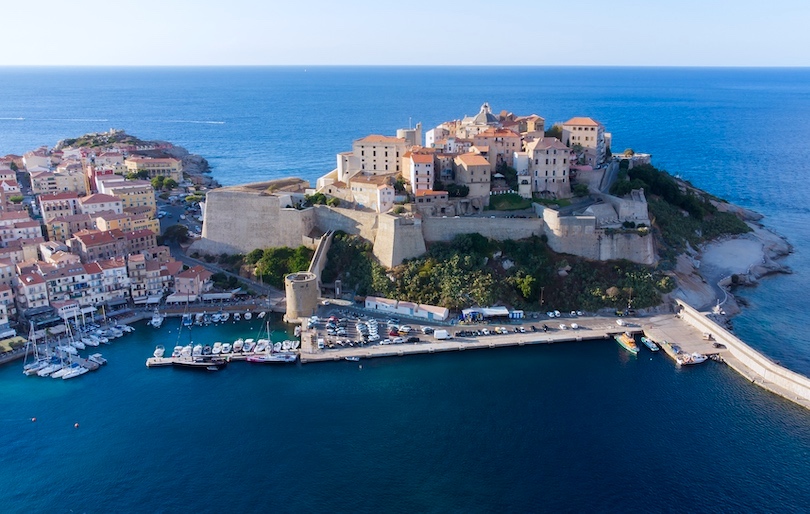
The term ‘must-visit’ is often overused in travel writing, but when it comes to Calvi, it is quite apt.
Nestled on Corsica’s northwest coast, the town boasts a crescent-shaped bay and stunning beaches. It also features a dramatic medieval citadel which overlooks the marina from its western end.
You’ll want to spend the best part of a day there at least, as there is a lot to see. It includes the historic church of Saint-Jean-Baptiste, Saint Anthony’s Oratory, the former palace of the Genoese governors and a historic house that Christopher Columbus once lived in.
Another good sight to visit is the chapel of Notre Dame de la Serra, which is perched atop a hill and showcases splendid panoramic views. It is also worth dining in one of the fabulous restaurants that flank the harbor around Quai Landry Esplanade.
9. Agriates Desert
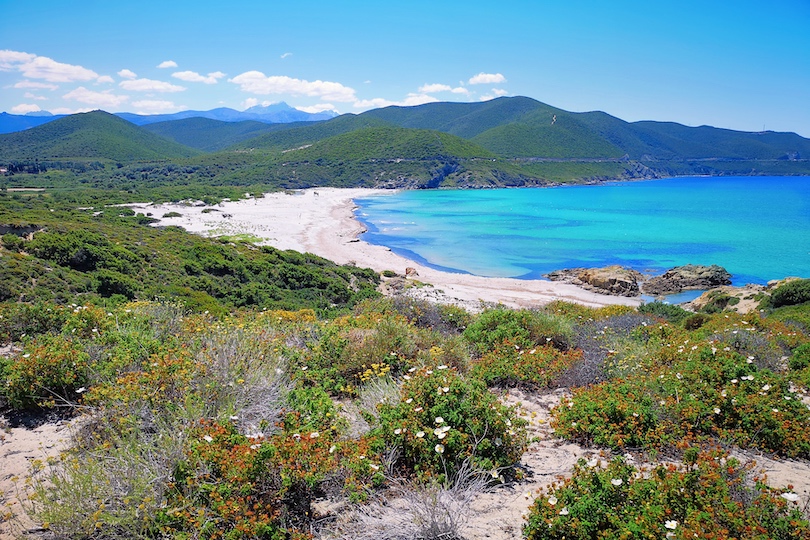
If you fancy a day of doing nothing more than swimming, sunbathing and relaxing on the beach, then pencil in a trip to the Agriates Desert.
Renowned for housing two fantastic beaches, the Plage de Saleccia and the Plage du Loto, they offer white sand, turquoise waters, and stunning views of the surrounding landscape. Visitors can easily get to them by boat from Saint-Florent and enjoy a day of swimming, sunbathing and water sports. Of the two, Saleccia is our favorite because it is flanked by a pine forest which creates a serene and tranquil setting.
As well as the beaches, the Agriates Desert is also steeped in history and culture. They are best discovered in traditional villages like Santo Pietro di Tenda and Olmeta di Tuda, which showcase the local way of life.
8. L’Ile-Rousse
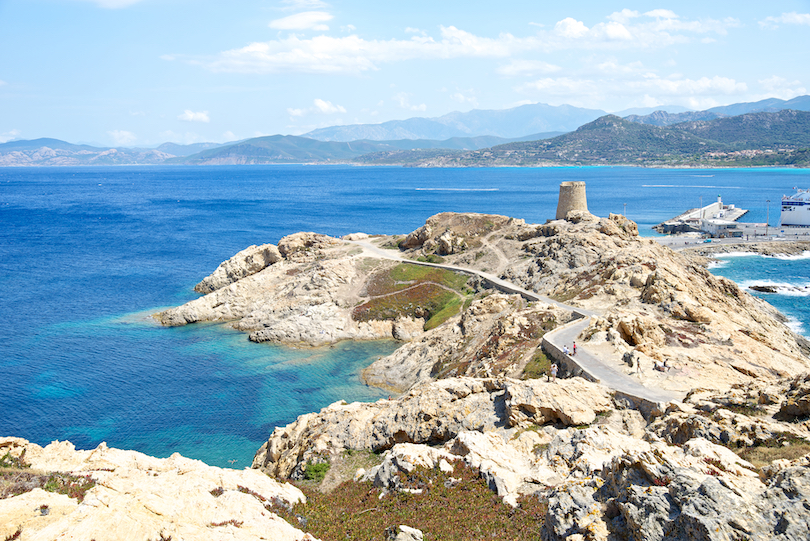
Despite being a small seaside resort, L’Ile Rousse is many people’s first port of call when they arrive in Corsica, as there are regular ferries from Toulon, Nice and Marseille.
But rather than head straight to Calvi and Saint-Florent, which is either side of it, you should really take the time to explore it.
Founded in the 18th century by the Corsican revolutionary leader Pasquale Paoli (who aimed to create an independent Corsican state), the town has a lovely town center. It features narrow streets, traditional Corsican buildings, and a lively square which is a lovely place to people-watch.
What is nice about L’Ile Rousse is that it has several open-air markets where visitors can buy fresh produce, handmade crafts, and other local products. They are terrific places to experience the local culture and taste traditional Corsican delicacies.
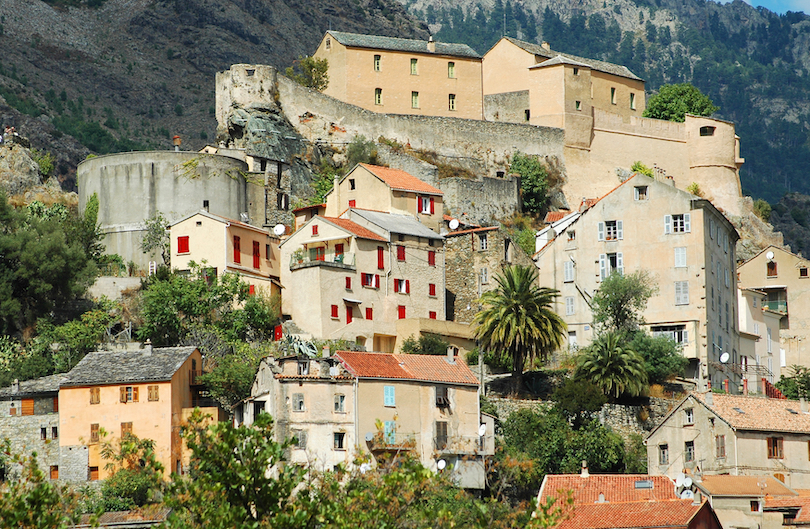
Nestled in the heart of Corsica, the lively city of Corte is a fabulous place to visit. Home to the island’s only university, the town has a vibrance and sense of youthful energy that is not present elsewhere.
On any visit to Corte, you should head to its old town. It is divided into an upper and a lower town, which are both interesting places to explore. One of the most impressive sites to take in is the Regional Museum of Anthropology which is located in the citadel. There you will be able to see a fantastic collection of ancient artifacts and objects that date back hundreds of years.
Another notable sight to visit is The Belvedere. Situated just below the citadel, this wonderful viewing platform presents sensational views across the city to the surrounding mountains.
6. Beaches around Porto-Vecchio
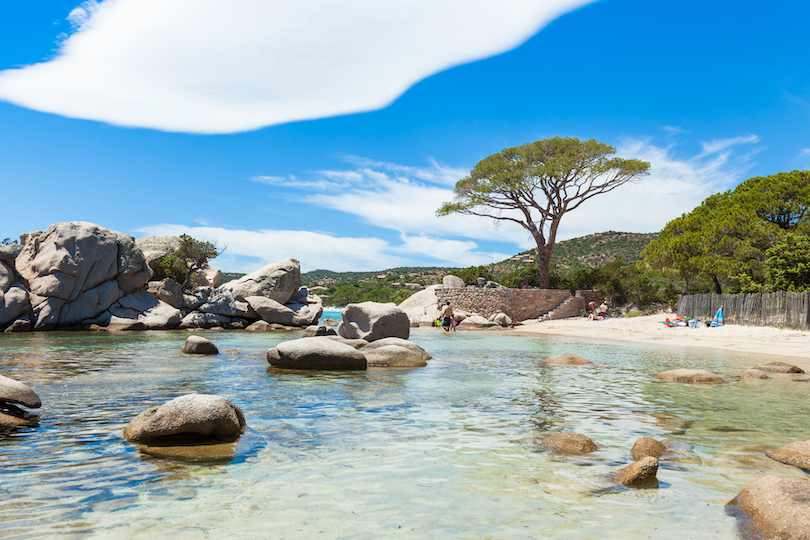
Ok, so the tiny town of Porto-Vecchio is pleasant enough, although, truth be told, it is not the most interesting of places to visit in Corsia. But due to its gorgeous location in Southern Corsica, it does have one big drawcard. Or rather several, in the form of its fabulous beaches.
For most people, the main reason to come to Porto-Vecchio is that there are no less than five fantastic beaches within a short distance of it. They are Rondinara Beach, Santa Giulia Beach, Palombaggia Beach, Tamaricciu Beach and Pinarellu Beach.
All of them feature gorgeous white sand and crystal-clear water that is perfect for swimming and sunbathing. If you have overdosed on sightseeing, they are very good places to go for an afternoon of rest and recuperation.
5. Sant’Antonino
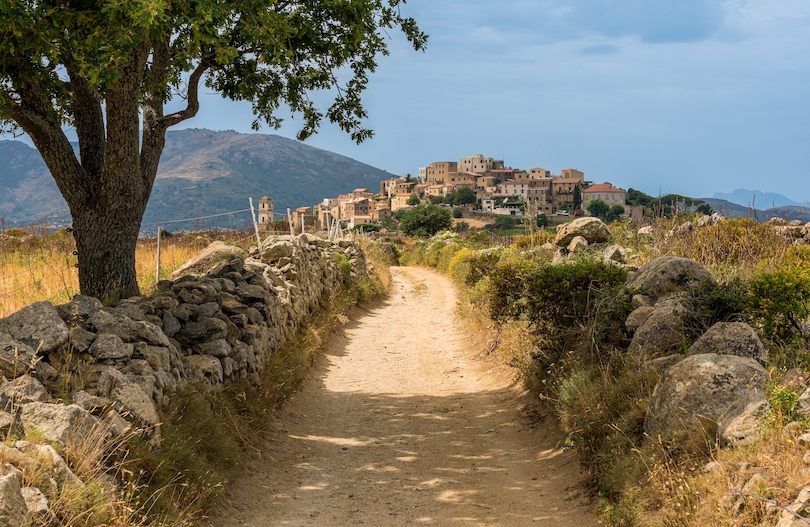
The region of Balagne comprises some of the most spectacular scenery in the whole of Corsica. Located in the northwest part of the island, it incorporates the cities of Calvi and L’Ile-Rousse, as well as plenty of idyllic beaches. Additionally, the area includes lush hinterland, jagged mountains and dense forest, which makes for spectacular terrain to explore by car.
Connected by a scenic drive, the panoramic road takes you through several quaint villages, including Calenzana, Pigna and Lumio. All of them are fabulous places to visit, with gorgeous architecture, friendly locals and delicious food. However, if you can only get to one, we recommend you make it Sant’Antonino.
Nestled on a hillside, the comely town showcases incredible views of Balagne and has some fabulous examples of medieval Corsican architecture. Whilst there, be sure to dine at the I Scalini restaurant – the aubergine tart is sensational!
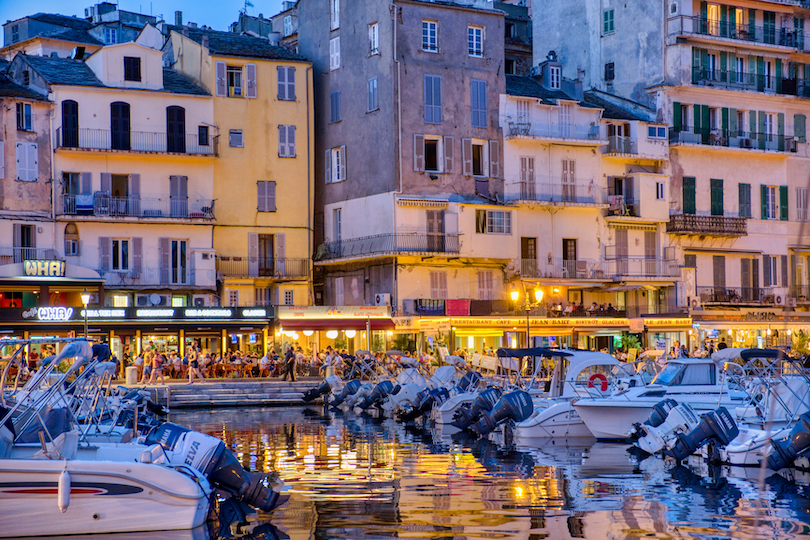
Based near the northern tip of the island, Bastia makes an excellent starting point for any visit to Corsica. Serviced by an international airport and a port, you can easily get there by plane or ferry from other parts of France or Italy.
You will want to spend a good few days here as there are lots to see. One of the most notable sites to visit includes Napoleon Street, which is a delightful pedestrian street that has an eclectic mix of shops and restaurants. Similarly, the Romieu gardens and stairs are worth checking out for the wonderful floral display and stunning coastal views.
The church of St. John the Baptist, in the Terra Vecchia district, is a historic building with two impressive bell towers you should visit. While St. Mary’s Cathedral, which dates back to 1619, presents several masterpieces from Italian artists.
3. Scandola Nature Reserve
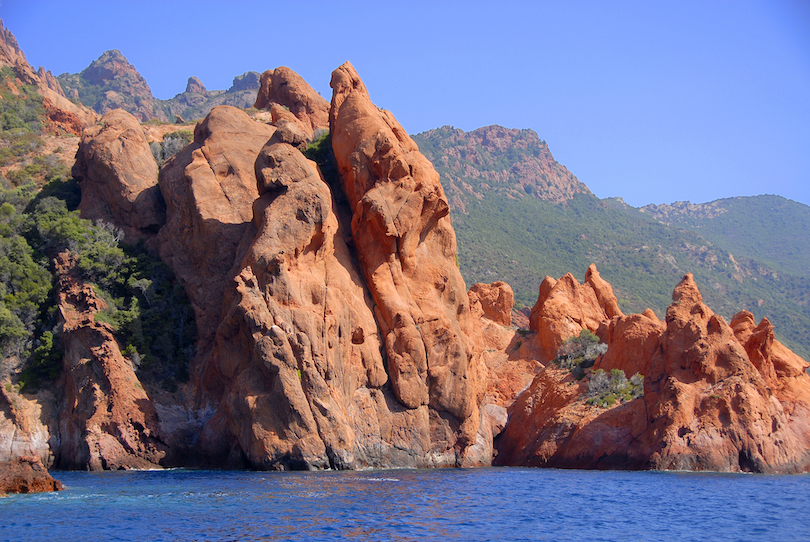
Considering Corsica has a huge list of stunning natural wonders, the fact that the Scandola Nature Reserve manages to stand out is a testament to its incredible beauty.
A World Heritage Site, it is best known for housing gigantic rock formations that defy belief. Set on an isolated peninsula, you need to take a boat tour from Ajaccio or Calvi to see it. Although it is worth the effort because you also might see pods of dolphins and colonies of seals as you enter the coastal park where they are located.
Once there, your boat will drop anchor, thus allowing you to swim around an inlet with the formations as a backdrop.
If you can, we recommend visiting it an hour before sunset, as you will get to see the rocks tinted a vivid shade of red by the descending sun.
2. Bonifacio
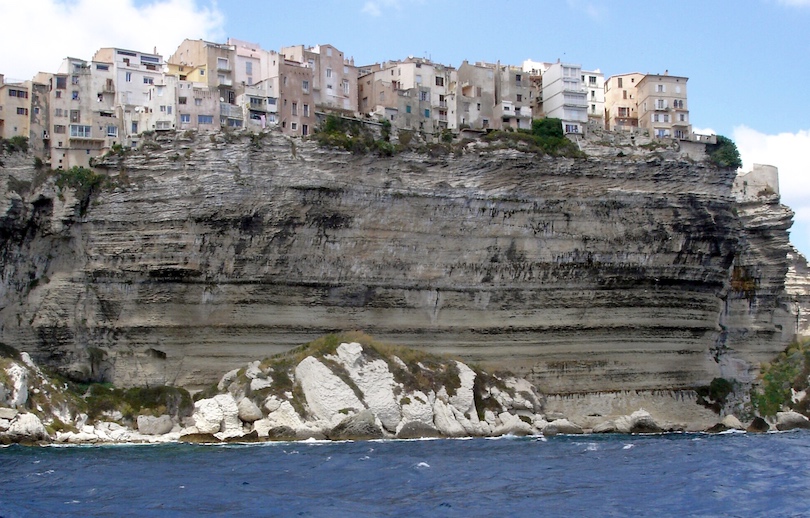
Tucked away on the southernmost part of the island, Bonifacio should be on every visitor’s list.
Featuring those iconic Bonifacio houses that are perched atop a dazzling white cliff that overlooks the water, it is a place where you’ll take plenty of photographs. One of the best places to do this is at the Col Saint Roch, which offers fantastic views of them.
Other landmarks to visit include the stately Pertusato lighthouse and the pristine Saint-Antoine beach, which has a lovely stretch of sand to walk on. The Fortress of the Standard is also an impressive structure to check out. While the chance to scale King of Aragon’s staircase should also appeal.
Once you’ve got your bearings around the city, you can also choose to take a boat to the nearby Lavezzi Islands. They are a spectacular collection of reefs and small granite islands, which will captivate you with their beauty.
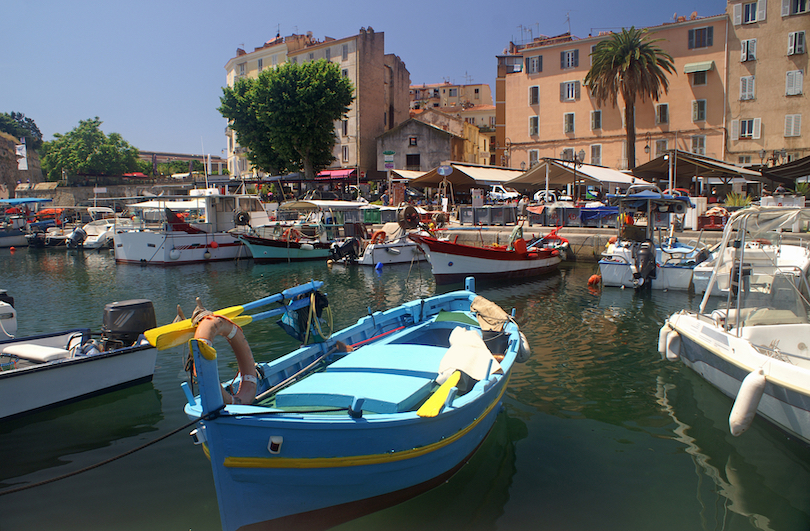
Located on the west coast, Ajaccio is the capital city of Corsica. A beautiful city, it offers visitors the perfect mix of history, culture, and stunning natural landscapes.
We love coming to Ajaccio because of its historic city center, which is filled with charming streets, beautiful architecture, and fascinating museums. As the birthplace of Napoleon Bonaparte, it also has many fascinating sites dedicated to the famous general. They include his childhood home, which is now a museum that offers an insight into his life.
Another reason to come to Ajaccio is that it has beautiful beaches that surround the city, such as the Plage du Trottel and the Plage de Capo di Feno.
Additionally, it is also a foodies paradise, accommodating several excellent restaurants and cafes, where you can enjoy delicious Corsican cuisines like wild boar stew and brocciu cheese.
Map of Places to Visit in Corsica, France
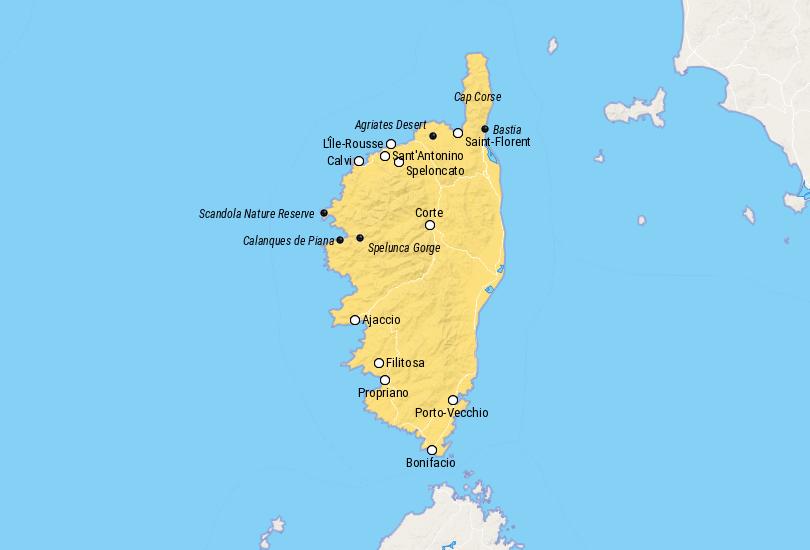
Share this post:
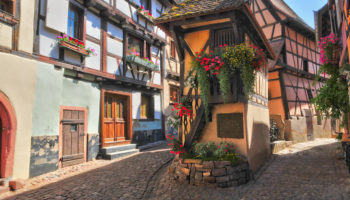
12 Most Charming Small Towns in France
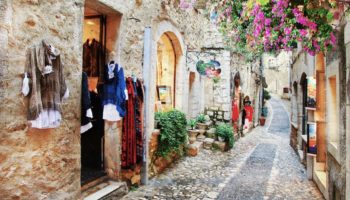
10 Most Amazing Destinations in the South of France
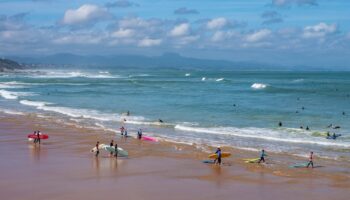
A Summer’s Day in Biarritz: 20 Fun Things to Do
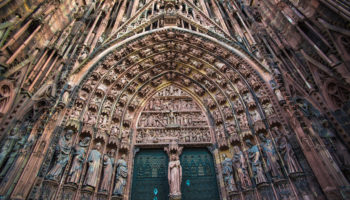
12 Most Beautiful Churches in France
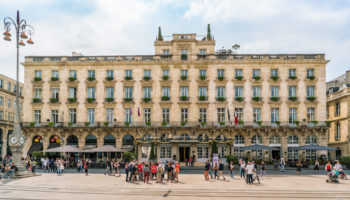
Where to Stay in Bordeaux: 8 Amazing Hotels
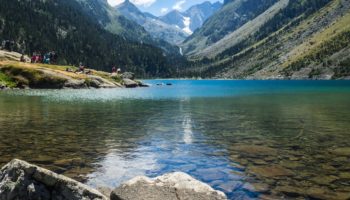
10 Most Beautiful Lakes in France
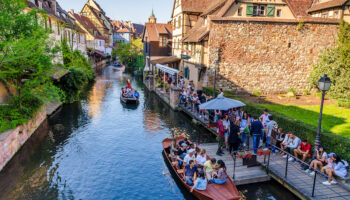
17 Best Things to do in Colmar, France
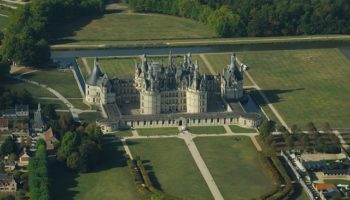
5 Most Beautiful Chateaus in France
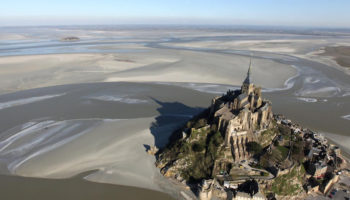
14 Beautiful Photos of Mont Saint-Michel
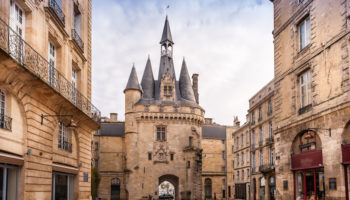
10 Top Things to Do in Bordeaux
Reader interactions, leave a reply cancel reply.
Your email address will not be published. Required fields are marked *
This site uses Akismet to reduce spam. Learn how your comment data is processed .
The 10 most beautiful beaches in Corsica

Mar 9, 2023 • 11 min read
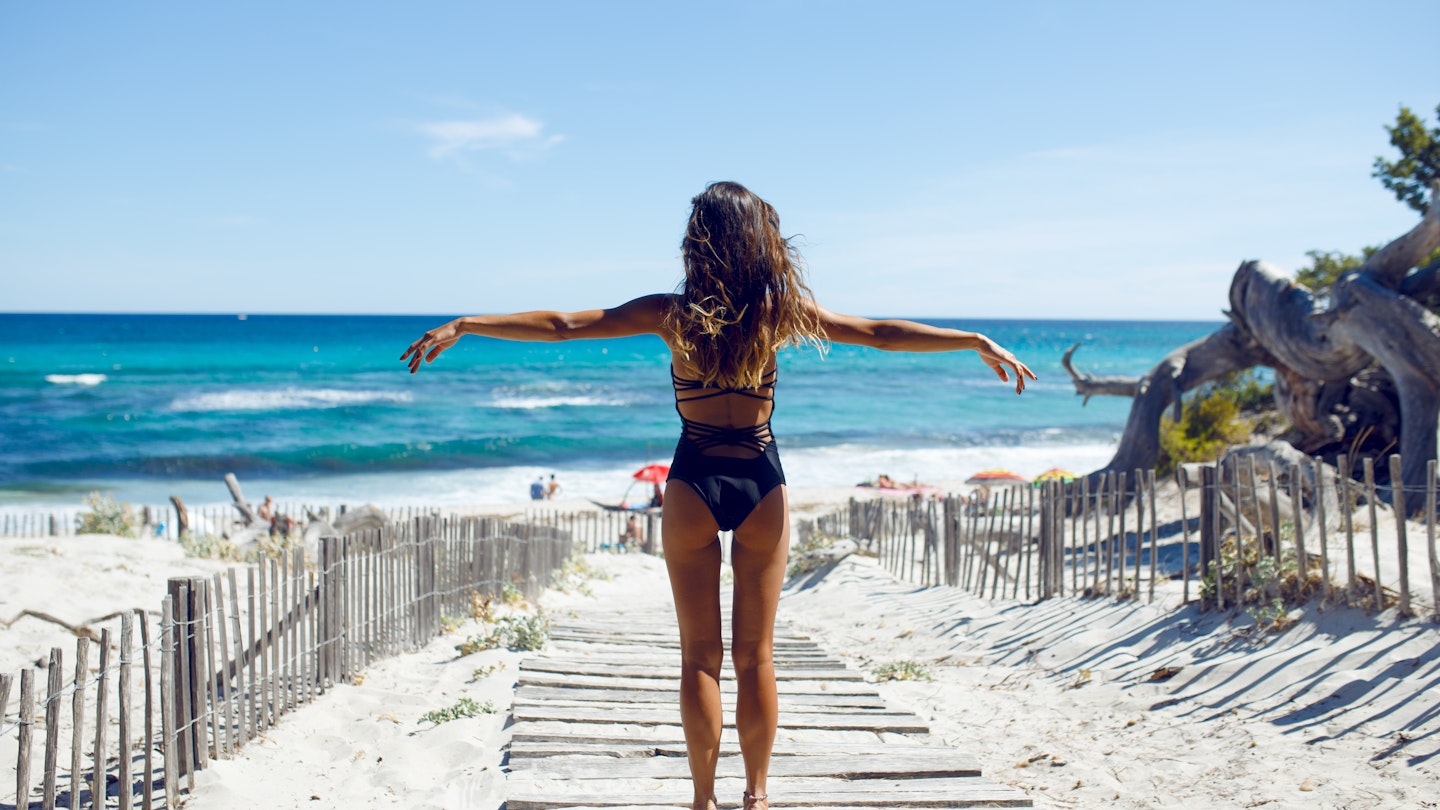
Corsica has many stunning beaches and we've got the perfect round up to help you choose © Dragosh Co / Getty Images
The French call Corsica L’Île de Beauté (the Isle of Beauty) for good reason: with 20 mountains topping 2000m the Mediterranean island combines dramatic mountain scenery with beautiful beaches, hidden coves, age-old stone villages, and vegetation that ranges from Alpine to dry Mediterranean.
The mountains dominate the island’s western and central regions and form the central bone of the long finger that juts north. As a result, some beaches in the west are inaccessible by road or require a 4WD with high clearance (your average urban SUV is no good here!) or a decent pair of hiking boots to reach.
Those along the much flatter east coast are easily accessible and more suitable if you're traveling with kids or anyone with mobility issues.
We’ve grouped our recommendations according to the island’s two regions: Haute-Corse (Upper Corsica which encompasses the north and the economic capital Bastia ) and Corse-du-Sud (South Corsica which includes the administrative capital Ajaccio ).
There is a stark contrast in beach facilities between the two regions – most in Haute-Corse are wild with no amenities at all. Come prepared: a parasol is mandatory as there is no natural shade and if there is, chances are someone will have found it before you! Bring water and check the weather before you set off – if the Mistral wind is blowing it will whip up the waves, particularly along the western coast, which could make swimming dangerous. Beaches in Corse-du-Sud, however, offer amenities and a host of nautical activities.
Regardless of which beach you choose, a visit during the height of summer means you’re unlikely to have it to yourself! And remember to bring cash – many of the car parks and restaurants don’t accept cards. With those practical tips in mind, here's our pick of the best beaches in Corsica.

Haute-Corse
1. ostriconi.
This 800m-long, white sandy beach lies between the Ostriconi river and the sea. It faces west, which means on days with strong swells it will be too dangerous to swim. But this is still the place to be for sensational sunsets that turn the rocks at the northern end of the beach red. On calm days, the vibe is very different – warm, still water that stays shallow for a long way out makes the sea here a wonderful natural paddling pool for kids.
Swimming is supervised in summer, but bring what you need as there are no amenities at all. Nudist bathers are tolerated at the northern end where there are a few rocks. The beach is a 5-minute walk from the free car park along a sandy path and over a wooden bridge – not ideal for pushchairs.
Planning tip: the Sentier des Douaniers (Customs officials' path) starts here heading east towards Saint Florent. It’s a two-day hike that will take you via Ghignu and Saleccia beaches.
Tucked away in the Agriates Desert region, this wild beach is far less crowded than the more popular Saleccia beach further along the coast, but they both share crystal-clear, turquoise waters and white sands. The only ways to reach it are either by boat or driving an off-road vehicle for 13km down an extremely bumpy track, making it a pretty well-kept secret. Bring plenty of water and a picnic, and admire the 400m stretch of sand from the top of the dune at its eastern end.
Planning tip: you can stay overnight in one of the restored paillers (where shepherds kept straw) which can sleep 4-6 people. There is no running water, electricity or mattresses but there are communal toilets. In winter you can just rock up and sleep here for free but it's on a first-come, first-served basis. In summer you need to reserve your spot in advance .
Set just south of the Calanques de Piana Unesco World Heritage Site, Arone is a lovely family friendly beach with easy access from the car park and a very gently sloping sea-bed, so the water is warm and shallow quite far out. The maquis-covered foothills of Monte Ravu slip gently into the sea on the southern end of the beach and the low-lying rocks at both ends are perfect for wannabe explorers of small marine life.
Swimming is supervised in summer. Three paillotes (beach huts) offer sun loungers, parasols, showers and casual eating. If you want a smarter alternative, then head to Le Casabianca seafood restaurant perched on low rocks at the western (right) end of the beach. It’s also a great place to watch the red and pink columns of the Calanques de Piana glow in the sunset.
Planning tip: Get here early if you’re visiting in the summer or you may find the free car park is full.

4. Calvi (aka La Pinède)
Calvi beach has an urban vibe, particularly during the week-long Calvi on the Rocks music festival held in early July when young Corsicans and tourists sway and pose in fashionable swim-wear on the beach and in the shallow sea water, often with a cool glass of something in hand, to the sounds of electro-dance music from 3pm until 4am daily.
The rest of the summer is a little calmer. Paillotes occupy the central section of what is one of the longest beaches in Corsica, boasting some of the softest sand. Add in the gentle slope to the water and you get the ideal beach for young children who can paddle and lick ice cream at the same time. For older ones willing to vanquish their fear of heights, there’s the Altore adventure climb through the pine trees about midway along the beach.
Sun loungers and parasols are available to rent and there are public showers, toilets, and a playground. Swimming is supervised in summer. Pick one of the many restaurants and sip a cocktail whilst you watch the sun sink behind Calvi citadel to the left of the beach, then turn your gaze inland and admire Corsica’s highest peak (2706m), Monte Cinto, one of the five peaks over 2000m that dominate Calvi Bay.
If you fancy a change of scenery, take the little train northwards to Ile Rousse to test some of the other beaches along the way or go diving at the foot of the citadel to see the wreck of a US Air Force bomber shot down in 1944.
5. Barcaggio
At the northern tip of Corsica on the Cap Corse, you may find you’re sharing beach space with a herd of cows. They look gentle but don’t try and get up close to take a picture – it annoys them. They will let you be if you leave them alone.
The beach is accessible on foot from the paying (€2) parking lot which is about 1km (0.6 miles) away. Or you can reach it by walking along the Sentier des Douaniers that runs along the coast (unsuitable for pushchairs and children under 8) from Macinaggio (2.5 hours) or the beach at Tamarone (almost 2 hours). There are one or two paillotes on the beach and restaurants in the nearby eponymous village.
Planning tip: Keep in mind that all the beaches on the Cap Corse tend to get invaded by seagrass meadows ( Posidonia oceanica ) after storms – these are the lungs of the Mediterranean Sea so they might not look or smell very nice, but are vital to the ecosystem. If you dig into them you’ll find all sorts of tiny sea creatures that fish and cows like to feed on.
Corse-du-Sud
6. rondinara.
A perfect, naturally formed scallop filled with shallow, glass-clear, turquoise water edged by white sand: no wonder this beach is regularly voted amongst the most beautiful in Europe! But its fame is becoming its undoing: from June to September the sand is very crowded and the many boats that anchor here churn up the sea bed and turn the water cloudy. If you can’t come out of season try coming very early in the morning or late in the afternoon when some of the old magic returns.
The only permanent building in sight is a restaurant set back from the beach amongst the trees. In the summer a paillote is set up next to the paying parking lot (€5/day, cash only). There’s a small nautical center from which you can rent parasols and sun loungers. Wild cows also like this beach, even at the height of summer, but don’t get too close to them. They are wild animals and don't appreciate close contact.
Planning tip: if the beach is too busy for your liking, head towards the left (southern) end of the beach where you’ll find a path. A 5-minute walk through the maquis will bring you to a crescent-shaped beach where the sand is a bit rougher and the sea isn't quite as calm but there are fewer people.

7. Palombaggia
Fine white sand, pink and grey granite rocks, umbrella pines (but too far back from the beach to provide much shade) and all this just 12km (7.4 miles) south of Porto Vecchio. The 1.5km (1 mile) long but very narrow beach is easy to access by car (parking is free) but also in the summer by shuttle bus from Porto Vecchio. The easy access means the beach is extremely popular in the summer but that’s also because swimming is supervised. The sea is generally calm and the slope into the water is gentle, making it ideal for people with accessibility issues and children. The tongue of flat pink rocks at the northeastern (left) end makes an ideal natural armchair in which to sit with your feet in the water and watch the snorkellers.
Unusually for a Corsican beach, there are public toilets. You can rent parasols and sun loungers from the beach restaurants and paillotes . There’s a diving club, a sailing club and a nautical club.
8. Santa Giulia
The south-facing beach, an easy 8km (5-mile) drive south from Porto Vecchio, is along a narrow strip of land with the sea to the east and a shallow lagoon to the west. It’s well protected from winds and the water is shallow quite far out – arrive early as young families will quickly crowd it at the height of summer.
There’ll be fewer people amongst the big, round, grey pebbles that emerge from the sea towards the left of the beach. These are lovely to snorkel through but the sea bed here is a bit pebbly so you might want to wear some water shoes. From here you can also smile at the antics of novice paddle-boarders and kayakers, and watch sailors hone their skills aboard small dinghies or catamarans.
Parasols and sun loungers can be rented from one of the restaurants and paillotes, also open in the evenings. Swimming is supervised in the summer. Cash only at the car park.
Planning tip: If you visit in the winter you may see a flock of pink flamingos in the lagoon.

9. Piantarella, Petit Spérone, Grand Spérone
If you’re into kite-surfing or wind-surfing, the northern end of Piantarella is the place to be. The beach is narrow and tends to get overcrowded, so walk south past the Roman ruins and along a 250m (820ft) path through vegetation. It will bring you to the Petit Spérone beach which, together with neighboring Grand Spérone beach, boasts some of the whitest sands in Corsica.
If there are still too many people here, head south and climb the steps cut into the rocks to reach the top of the corniche. Then turn west along a shady path through the golf course and 500m (1640ft) further along you’ll reach Grand Spérone beach which is far less crowded even in the middle of summer. There are no amenities at either of the Spérone beaches.
Planning tip: You’ll be facing due south with views of the Lavezzi islands – when the weather is clear you’ll be able to spot Sardinia .
10. Capo Di Feno
Another beach for big surf lovers! There are actually two beaches here separated by a field – Grand Capo is big enough to never seem crowded, and Petit Capo (aka Sevani) to the south is smaller and attracts fewer people. You’ll get shaken and stirred on the paved road to Grand Capo which forks near the coast. Both the dirt track on the left and the paved road to the right lead to the beach but there’s more (free) parking at the end of the dirt track. To reach Petit Capo just walk to the southern (left) end of Grand Capo and cross the field or splash through the rocks.
Swimming from either beach is dangerous when the surf is up. A lifeguard is on duty in July and August so keep an eye on the flag and don’t go into the water if the yellow or red one is hoisted. Parasols and sun loungers are available from paillotes.
At day’s end head over to the Grand Capo restaurant, Casa Nostra where you can sit with your feet in the sand, a cocktail in hand and feast your eyes on the changing colors of the sky as the sun sets and the last of the surfers ride the waves. On some summer evenings, there’s live music here too. Bring cash as the restaurant doesn’t accept cards.
Planning tip: If you walk to Petit Capo you’ll have to go past the nudist section at the far left of Grand Capo. If you'd prefer not to, you'll need to drive back up the D111B until you reach a turnoff pointing to Plage de Sevani. Drive through the housing development to reach the car park by the beach.
Explore related stories
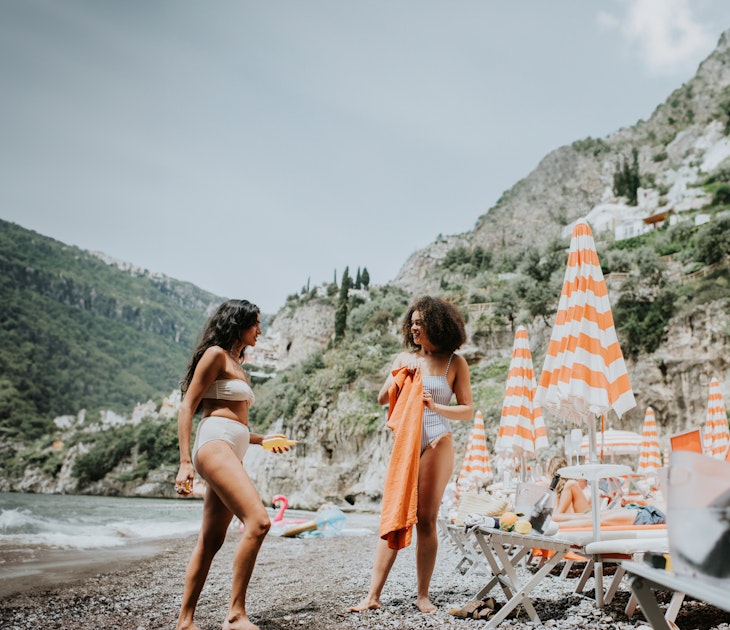
Mar 20, 2024 • 9 min read
Bella Italia has some of the most beautiful stretches of sand on the planet. Work your way around the coastline with 17 of our favorite beaches in Italy.
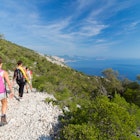
Mar 20, 2024 • 6 min read

Feb 26, 2024 • 8 min read

Jan 19, 2024 • 11 min read

May 13, 2023 • 8 min read

Dec 21, 2022 • 7 min read

Sep 2, 2022 • 10 min read
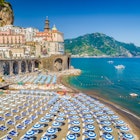
Jul 20, 2022 • 5 min read

Dec 28, 2021 • 1 min read
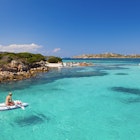
Jan 3, 2020 • 6 min read
Towns and resorts

Discover some of the most popular resorts and towns in Corsica

Explore Corsica by following its beautiful coast road
Hotels in Corsica
Booking.com: best prices
Porto-Vecchio

Porto Vecchio has an attractive marina and old town and easy access to stunning beaches

Bastia is a long established port town in Corsica with an attractive harbour and a fascinating old town

A small and pleasant resort clustered around a 16th century castle. This is a popular area with cyclists
Visit Corsica
The island of Corsica is almost the perfect holiday destination, basking in the Mediterranean sunshine off the south of France and to the west of Italy. Hundreds of perfect beaches , magnificent scenery (both on the coast and inland in the mountains), attractive harbour towns resorts and numerous small villages hidden in the surrounding landscape, and of course the perfect Mediterranean climate, all come together to create an ideal travel destination.

It is certainly the resorts, beaches and 1,000 kilometres of coastline that are the main attraction for the majority if holidays on Corsica, with swimming, snorkelling, wind-surfing, scuba diving, sightseeing and sunbathing being the most popular activities...... but try to spend some time exploring the other highlights, there is a great deal to discover and enjoy throughout the island!
Corsica: an introduction
Corsica enjoys a typical Mediterranean climate, with summers being hot and dry, and remaining mild even in winter, at least at coastal level. The mountains are of course a little cooler all year round. See weather and climate for details of the best time to visit.
The Natural Regional Park of Corse has been set-up to protect part of the rare and unusual habitats found on the island. The park includes some of the highest mountain peaks on the island, and a great deal of natural beauty. The Scandola Nature Reserve (the western part of the Natural park) is also stunning, accessible by boat trip from towns on the west coast.

The towns in Corsica are very attractive, as are hiking and other outdoor activities based both in the mountains and along the coast. Walks are available for all levels of ability, from a pleasant stroll to some of the most difficult mountain walks in Europe.
Two of the less common ways to visit Corsica are
(1) if you have several weeks to explore at your leisure by car you could follow the Corsica Coast road that circumnavigates the island, and
(2) see our guide to hiking in Corsica if you prefer to explore the hard way - on foot - by following one of the long distance paths across the mountains
With this guide we introduce many of the highlights of this beautiful island, and hope to help make your visit as varied and enjoyable as possible. We have also gathered together a few of our favourite photographs: see photos of Corsica .
Visit the regions of Corsica
Corsica is too large to do justice to in just one trip to the island. The roads are not always fast, and you will be tempted to stay longer than expected in each place you visit.

To help you decide which part of the island to visit see regions of Corsica or to discover the main highlights of each of these regions, with guides to many of the most interesting places to visit and natural sights see:
- Northern Corsica - the west and north-west regions of Corsica
- Bastia and Cap Corse - the northern peninsula
- Bonifacio - southern Corsica
- Corte - the mountainous centre of Corsica
- Eastern Corsica - the eastern coast and villages
The most visited regions and towns are to the west of the island including the Balagne region (with Calvi, L'Ile-Rousse, and a great deal of beautiful coastal scenery) and to the south around Bonifacio. Our favourite areas were the north-west around the Calanques and the beaches around Porto-Vecchio in southern Corsica.
Visit the towns of Corsica
The most popular towns and resorts on the island are...
- Ajaccio - western Corsica
- Aleria - eastern coast
- Bastia - north-east Corsica (and access to Cap Corse )
- Calvi - Balagne region
- Cargese - Balagne region
- Corte - central Corsica
- L'Ile-Rousse - Balagne region
- Porto - western coast
- Porto-Vecchio - southern Corsica
- Propriano - southern Corsica
- Saint-Florent - north-east Corsica
- Sartene - southern Corsica
You can see lots more of the smaller towns and villages at Corsican villages .
See the French version of the Corsica Travel Guide .
Latest Articles

Centuri, Corse: a pretty port and village in the Cap Corse

Northern Cap Corse, Corsica: a charming mix of beaches, scenery and quiet villages

Montemaggiore, Corsica: a pretty village in the Balagne region

Calenzana, Corsica; a small town rich in history

Corbara, Pigna and Aregno, three pretty villages in the Balagne region of northern Corsica
Corsica Travel Guide - copyright 2008 - 2024
- privacy policy and contact details

Hi, I'm Charlotte
Browse the blog.
- FREE RESOURCES
- TRAVEL TIPS
CHARLIES WANDERINGS
THE BLOG FOR THE ADVENTUROUS TRAVELER WHO LOVES A TOUCH OF LUXURY NOW AND THEN

BLOG , CORSICA , Destinations , Europe , France , travel inspiration · August 27, 2023
- The 14 Most Beautiful Places In Corsica
Are you looking for the most beautiful places to visit in Corsica during your holiday? In this blog post I will cover every single place that I visited myself during my time on this wonderful island!
Corsica is a wonderful island in the heart of the Mediterranean Sea where you can discover beautiful beaches, old towns and charming villages one day. And the next day you’ll explore one of the many hiking trails Corsica has to offer and you’ll find yourself surrounded by plunging waterfalls and rigid mountains.
I visited Corsica during low season, at the start of April. My recommendation would be to not do that. The weather was still on the colder side and at one point I even encountered a snow covered road. Instead opt for booking your holiday to Corsica between the start of May until the end of October.
In this guide I will list my top places to visit in Corsica that I also visited myself. I will share my personal tips, special recommendations, where to eat and the best places to stay for each place.
This way you can create your own personal itinerary perfectly according to the places that speak to you the most !

What to see in Corsica
If you’ve never set foot on the sun-kissed shores of Corsica, you’re in for a real treat. Just imagine the azure waters of the Mediterranean meeting rugged mountain ranges that seem to whisper tales of ancient times.
Corsica, often dubbed the “Island of Beauty”, is a melting pot of pristine beaches like Palombaggia, dense forests perfect for hiking, and age-old towns such as Bonifacio perched precariously on white limestone cliffs.
So, whether you’re a nature lover, history buff, or simply someone looking for their next adventure – Corsica won’t disappoint. And hey, don’t forget to pack your camera; you’re gonna need it! 😉
The best time to visit Corsica
Certainly! Here’s a breakdown of the advantages and disadvantages of visiting Corsica during each season, incorporating the personal experience you provided:
Spring (March – May)
Advantages:
- Blooming landscapes and mild temperatures.
- Fewer tourists, leading to a more peaceful experience.
- Ideal for outdoor activities like hiking and cycling.
Disadvantages:
- Some hotels and restaurants might still be closed, especially in April.
- Unexpected weather changes, such as snow in higher elevations.
Summer (June – August)
- Warm, clear waters perfect for swimming and water sports.
- All tourist facilities, hotels, and restaurants are open.
- Vibrant nightlife and festivals.
- Peak tourist season, which can mean crowded beaches and attractions.
- Hot temperatures might be uncomfortable for some activities.
Autumn (Septe m ber – November)
- Cooler temperatures ideal for hiking and exploring.
- Fall colors make the landscapes even more picturesque.
- Fewer crowds than summer, but still lively.
- Shorter days with less sunlight.
- Possibility of unpredictable weather and rain.
Winter (December – February)
- Some areas offer winter sports, especially in the mountains.
- A unique experience with fewer tourists.
- Celebrate local winter festivities and traditions.
- Chilly weather, especially in the mountains and higher elevations.
- Many tourist facilities and some hotels and restaurants might be closed.
- Coastal areas can be quite dormant, with fewer activities.
List of the best places to see in Corsica
1. bonifacio, a beautiful old town in southern corsica.
Bonifacio is the most Southern town in entire Corsica and if there’s one old town you absolutely can’t miss it’s this one! It’s one of the best places to visit in southern Corsica !
Bonifacio is the perfect starting point for your trip if you land in the airport of Figari. From there it’s only 30 minutes driving to this wonderful village.
The roads inside the city itself are pretty narrow but there are plenty of parking lots. Two of them are located near the marine, the other two are closer to the old city.
The Old City of Bonifacio is located in a 9th century citadel and consists of a maze of small cobblestoned streets.
💡 TIP – Hike to the Phare de Pertusatu to get the best views over Bonifacio. It’s an easy hike in Corsica which will take you alongside the cliffs.
🥘 WHERE TO EAT – Have lunch at Café Des Vestiges and try their Aubergines à la Bonifacienne, a lovely and typical vegetarian dish.
🏨 WHERE TO STAY IN BONIFACIO – Hotel Spa Genovese for an unforgettable stay, a clifftop location and panoramic views.
🎒 BEST TOUR – BONIFACIO NATIONAL PARK BOAT DAY TRIP

2. Col de Bavella
If you love hiking in a spectacular area or you just want to drive across a stunning landscape then you will love this part of Corsica! The Aiguilles de Bavella are only 1,5 hour driving from Bonifacio and consist of rocky spikes of red granite hat dominate the hill of the same name in Corse-du-Sud. The site is characterized by jagged peaks, large rock walls and pine trees twisted by the wind.
Following the route of the Col de Bavella between Sartene and across Corsica towards the east (north-west of Porto-Vecchio), you pass through the Alta rocca mountains . The Col de Bavella itself reaches an altitude of 1218 metres with the peaks of the ‘needles’ reaching more than 1800 metres.
The road up to the Col de Bavella offers some spectacular coastal views and it’s definitely a good idea to stop the car now and then to take them all in!
If you want to adventure a little more I can highly recommend going on one of the following hikes:
- Cascades de Purcaraccia Hiking Trail – a 4.8km out & back trail that will lead you to some beautiful waterfall cascades.
- Tour des Aiguilles de Bavella – A more demanding 11km loop trail that will take you through the stunning Aiguilles de Bavella.
🥘 WHERE TO EAT – Have lunch at Auberge du Col de Bavella and indulge in one of the typical Corsican dishes such as Civet de sanglier (Wild boar casserole) or Veau aux olives (Veal with olives).
🏨 WHERE TO STAY – Stay at Grand Hôtel De Cala Rossa & Spa Nucca to fully relax after an adventurous day. The beach town of Porto Vecchio is also the starting point for the tour that I linked for you below.
🎒BEST TOUR – 4×4 TOUR TO COL DE BAVELLA FROM PORTO VECCHIO

Corte is a historic town in the heart of Corsica as it was the capital of Corsica from 1755 until 1769 during the “government of the Corsican nation” of Pascal Paoli. And during World War I, German prisoners were held in the citadel on top of the hill.
These days Corte is a university town which houses a ton of students. The old city is perched on top of a hill but is also easy accessible. Don’t even bother trying to park your car on the side of the road, instead simply park it at the underground parking lot and you’ll arrive in the heart of the Old City.
There’s a ton of things to do in Corte but I’ve listed the best ones for you:
- Visit the Citadel, Corte’s citadel is the only one located in the heart of the island.
- Ghionga grocery store: discover one of Europe’s oldest grocery stores dating back to 1769.
- Hike through the Restonica Gorge, one of Corsica’s most famous trails.
- Hike through Tavignano Valley, located at the foothill of Corte’s citadel.
- Discover the forest of Vizzavona, a 40 minute drive from Corte.
🥘 WHERE TO EAT – Restaurant La rivière des Vins for delicious meats cooked in a wood fire oven, accompanied by homemade french fries.
🏨 WHERE TO STAY – Stay at Dominique Colonna for a luxurious stay on the river’s edge.

4. Scandola Nature Reserve
Scandola Nature Reserve is a stunning marine and terrestrial nature reserve in the East of Corsica that’s under strict regulated acces .
You can’t reach Scandola Nature Reserve on foot or by car, the only way to visit is by boat . Luckily there are a ton of tour operators that offer excursions from the marine of Porto. You can choose between different lengths but the best one to choose is where you’ll visit Scandola Nature Reserve, Girolata and the Calanques de Piana.
These boat excursions last between 3 to 5 hours and besides exploring every nook and cranny of Scandola Nature Reserve you’ll also make a quick stop at the beautiful town of Girolata.
The 1,900-hectare reserve offers incredible landscapes which were formed by erosion. Its volcanic red rocks form an amazing contrast to the turquoise water surrounding it. You’ll sure be in for a treat if you go on one of the excursions!

5. Girolata
Girolata is a former fishing village that only has about a 20 inhabitants and which can not be reached by car.
There are two ways to reach this hidden gem in East Corsica: on foot or by boat . If you want to go by boat you can book one of the many excursions that leave from Porto and where you’ll also visit the Scandola Nature Reserve.
If you want to visit Girolata on foot I recommend to start hiking in the morning. This way you can have lunch at one of the cute restaurants and afterwards make your way back to the car. The hike to Girolata is called the Sentier du Facteur and it’s one of the most beautiful hikes in Corsica !
The Sentier du Facteur is called this way because the local mailman used to hike this trail every single day to deliver the mail to the people living in the small town of Girolata .
🥘 WHERE TO EAT – After reaching Girolata on foot you should have lunch at Restaurant Le Bon Espoir and try some of the best Corsican food you’ll have during your holiday!
🏨 WHERE TO STAY – Stay at Le Bella Vista for a 2 bedroom apartment that offers incredible panoramic views.

6. Calanques de Piana, the most beautiful place in Corsica
Visiting the Calanques de Piana is one of the best things to do in Corsica. There are a ton of beautiful hikes here to explore the area but even even is hiking is not really your cup of tea you’ll find plenty of things to do here!
One of the best things to do is simply drive through the stunning natural site. The Calanques de Piana is a UNESCO World Heritage Site featuring stunningly shaped red rock cliffs plunging into translucent water. From the water it resembles Scandola Nature Reserve but the biggest difference here is that you can also explore on foot or by car.
If you want to visit the Calanques de Piana by car, you have to take the D81 road, connecting Porto to Piana . It’s the only road in the Calanques and its an absolute stunner! There are several small patches next to the road as well if you want to stop for a photo. Another option is to leave your car in Piana and explore on foot from there.
🥘 WHERE TO EAT – You’ll probably stay here for a couple of days so I would recommend having dinner at Le Moulin and take their home made burger which comes with an incredible Corsican cheese sauce. Another day you should go eat at Le Maquis and order the Escaloppe Milanese! Both finger licking delicious!
🏨 WHERE TO STAY – Stay at Hôtel Bella Vista . There aren’t any luxury hotels in the area but this one comes with incredible panoramic views, a modern bathroom and clean rooms.

7. Spelunca Gorge
The Spelunca Gorge is one of the most beautiful places in entire Corsica and there are several hiking options here! You can choose to hike from Ota to the beautiful town of Evisa or you can choose to walk towards the Zaglia bridge , a beautiful stone bridge listed as a Historic Monument.
During my visit the trail towards Evisa was unfortunately closed due to a lot of rockfall but know that Evisa is considered to be one of the most beautiful towns in Corsica ! So if you can get the chance to complete the entire trail definitely don’t hesitate!

8. Montemaggiore, the most beautiful town in Corsica
Montemaggiore is a beautiful village in the Balagne region of north-west Corsica. Although it is only a small village, it has preserved a great deal of its historical charm and has impressive views across the region so a visit is recommended as part of your tour of the Balagne!
The view of Montemaggiore as you approach the village is one of the highlights – it appears very small compared to the dramatic scenery around the village, which includes the Monte Grosso mountain , and is perched on a ledge overlooking the valleys to the west.
Inside the village you discover narrow streets of stone houses as well as the main square in the village. As you explore the narrow streets you will see various doorways surrounded by their original stone sculptures.
🥘 WHERE TO EAT – L’Altezza Restaurant is your best bet in the area and offers delicious food!
🏨 WHERE TO STAY – Stay at Cas’Anna Lidia – Hôtel De Charme , a boutique hotel with an outdoor heated pool and a hot tub overlooking the surrounding mountains.

9. Sant’Antonino
Sant’Antonino is one of the most beautiful places in Corsica and situated in the centre of the Balagne region of north-eastern Corsica. Because of its dramatic situation clinging around the top of a hill the village is sometimes referred to as the ‘ Eagles Nest ‘.
Sant’Antonino is officially classified as one of the ‘most beautiful villages in France’ . It has a history dating back to the 9th century – the location was originally chosen because of its natural defences – making it one of the oldest villages in Corsica.
Much of the village is a warren of narrow lanes, steep pathways passing through vaulted passages, and ancient traditional houses, making Sant’Antonino a pleasure to explore.
🥘 WHERE TO EAT – Go to I Scalini for a Moroccan feel roof terrace with panoramic views over the city.

10. Speloncato, the best place in Corsica to watch the sunset
If there’s one town in Corsica that has to be on your must visit list it’s Speloncato. This is one of the most beautiful towns in the entire region and after about 10km driving through winding mountain roads you’ll be rewarded with a stunning view over this picturesque town.
Speloncato is the perfect town to visit in the early evening, wander through the small alleys and sit down on one of the terraces on the main square. Afterwards you should definitely catch the sunset over the town which will be covered in a golden glow.
🥘 WHERE TO EAT – U Sechju for a delicious lunch in a historical setting.
🏨 WHERE TO STAY – Hotel A Piattatella , which is set in gardens, overlooking the Reginu Valley.

11. Erbalunga, a stunning coastal village in Corsica
Erbalunga was once the most important harbor on the Cap Corse , a fact supported by the magnificent houses that still stud the peninsula to this day.
There’s a small network of squares and streets which really give off that old city harbor vibe. There is a good range of facilities including shops, a cash dispenser machine, post office, bars and restaurants and a dive school at Sisco Marina, slightly further north.
If you’re looking for an old town experience, then Erbalunga is one of the best places to go in Corsica.
🥘 WHERE TO EAT – Dine at Le Pirate for the most perfect setting and a Michelin star experience.
🏨 WHERE TO STAY – Stay at the most stunning Misincu , a 5 star hotel that forms the perfect base for exploring the area of Cap Corse.

12. Nonza, the most colorful town in Corsica
Nonza has to be one of my favorite places in Corsica and it’s also listed as one of the most beautiful villages in France . It’s colorful buildings make it stand out from all of the other picturesque towns and form a wonderful contrast to its black beach all the way down below.
Nonza is a rather small town and is best explored on foot once you’ve parked your car down.
🥘 WHERE TO EAT – Have lunch at La Sassa for incredible views and the best food! This is also a wonderful restaurant to have a sunset dinner cause it overlooks the entire bay of Cap Corse. Just make sure to call ahead to make a reservation.

13. Aiguilles de Bavella
In the heart of South Corsica you’ll find one of the most beautiful places this island has to offer. The Aiguilles de Bavella is a mountain range consisting of rocky spikes of red granite. The name means needles of Bavella. At 1218 m, the hill connects the Alta Rocca to the east coast of Corsica.
The island’s most iconic mountain drive meanders through the astonishingly beautiful scenery of Alta Rocca, a southern mid-mountain territory located within the Regional Natural Park of Corsica.
This massif is smaller yet much more popular than the “aiguilles de Popolasca”. The site is characterized by jagged peaks, large rock walls and pine trees twisted by the wind.
The 75km route can be done in only 2 hours but it’s safe to say that you’ll want to make a couple of stops along the way to take in the views and visit some of the following places: Zonza, Lac de L’Ospedale, Col de Bavella and Piscia di Gallu.
🏨 WHERE TO STAY – Stay at Grand Hôtel De Cala Rossa & Spa Nucca to fully relax after an adventurous day.

14. Cascades de Purcaraccia
The Cascades de Purcaraccia hiking trail is one of the most beautiful hiking trails in Corsica but it’s not the easiest. The trail isn’t marked at all and it’s very easy to miss a turn off at the end.
The biggest advice I can give you is to follow the trail on the AllTrails app, combined with Maps.me . Make sure to download the map of Corsica before you set off on your adventure!
The trail pretty much starts on the side of the road, in the hairpin bend that follows the Col de Larone. There’s a very small turn off where you can park your car but make sure to arrive early cause it only has space for like 3 cars. Otherwise you’ll have to park your car at the Parking Bocca di Larone which is only 2 minutes walking from the start of the hiking trail.
The first part of the Cascades de Purcaraccia hiking trail goes through a small forest and offers incredible views over the Aiguilles de Bavella .
Afterwards the trail leads more inwards into a gorge where you’ll have to do a lot of scrambling over rocks and also cross the river at some point so keep an eye on that offline map or you’ll end up at a dead end.
But the final destination is definitely worth the struggle and in the summer months you can even swim here!

FAQ on where to visit in Corsica
Which part of corsica is the most beautiful.
When it comes to pinpointing the most beautiful part of Corsica, it’s like asking me to choose my favorite dessert – almost impossible! But if I had to pick, the rugged charm of the Calanques de Piana would surely top the list.
What is the most beautiful port in Corsica?
Corsica boasts many picturesque ports, but the port of Bonifacio stands out with its dramatic limestone cliffs and ancient stone buildings overlooking the deep blue sea. Its rich history and captivating views make it an unmissable gem for any visitor to the island.
Which part of Corsica has the best beaches?
Corsica is renowned for its pristine shores, but the southern region, especially around Porto-Vecchio, claims the crown for the most idyllic beaches. With its soft white sands, crystal-clear waters, and secluded coves like Palombaggia and Santa Giulia, the south offers a sublime coastal experience that beach aficionados dream of.
The Best Places To Visit In Corsica Map
📚 More Corsica Articles
- Tips For Renting A Car And Driving In Corsica
- The Very Best Corsica Itinerary – A 7 Day Road Trip
- The 8 Very Best Things To Do In Calanques De Piana In Corsica
- The 11 Best Luxury Boutique Hotels In Corsica
- The 6 Best Hikes In Corsica, Incredible Hiking Trails You Can’t Miss
- The 21 Most Beautiful Towns And Villages To Visit In Corsica

Charlotte Lint is the founder of Charlies Wanderings. Charlotte has traveled all over the world and is based in Belgium where she also owns her very own dental practice. She is an expert on writing efficient travel guides and finding unique places to stay. Every month she helps over 134.000 people discover the most beautiful places in the world through her detailed travel guides.
You’ll Also Love

Leave a Reply
You must be logged in to post a comment.
- Free Resources
- Privacy Policy
Charlies wanderings is a travel blog filled with unique adventures and wonderful storytelling through colorful photos and insightful travel guides.
COPYRIGHT © 2017 - 2022 CHARLIES WANDERINGS
All rights reserved. Photography and written content may not be reproduced without my permission.
Copyright © 2024 CHARLIES WANDERINGS Theme by 17th Avenue
Copyright © 2024 · Charlotte on Genesis Framework · WordPress · Log in
National Geographic content straight to your inbox—sign up for our popular newsletters here

In Corsica, on a quest for beautiful harmony
Here’s how to surround yourself with the sounds of this timeless Mediterranean island.
A beautiful singing voice is alchemic—you pull a lungful of air through the human machine and it leaves, like magic, as music on the exhale. I’m a singer, so probably biased, but I don’t believe we’ve managed to design an instrument that rivals the reed we’ve got built in.
I was first introduced to the vocal group A Filetta by a listener at one of my own concerts, a poorly attended show in Germany . To distract the crowd from its own size, my bandmate Aby and I crammed everyone into a stairwell, then sang Leonard Cohen’s “Hallelujah” in harmony, a cappella.
Afterward I received an email from a man named Christian: In a very, very quiet moment, please watch this . A link led to a video in which a man wearing a gold chain and a black dress shirt, open at the collar, held a tuning fork to his right ear before dropping it into his breast pocket. Gray-haired and trim, he moved with a relaxed, animal athleticism.
When his mouth opened, his eyes shut, as if wired on a shared circuit. The sound he emitted matched his physical aspect—it was a boxer’s voice, abraded by time or suffering or both. The melody was both mournful and urgent, like a funeral song for someone not quite dead. It featured the tense, fast vocal trills of tragic Portuguese fado or a muezzin’s call to prayer.
After the first phrase, half a dozen other male voices joined in; the camera panned across their faces, dark lashes edging their closed eyes. Some sang in close harmony, some sang long vowels, like a bed of strings.
I couldn’t understand the words, couldn’t even identify the language. But I knew I’d never seen such undisguised passion in the faces of singers making such a religious sound. This was not a church pew prayer. This was a bathroom floor prayer. I played it again and again.
Googling, I learned A Filetta is from Corsica, a Mediterranean island territory of France . The group’s charismatic leader is Jean-Claude Acquaviva.
I’d never seen such undisguised passion in the faces of singers making such a religious sound. This was not a church pew prayer. This was a bathroom floor prayer.
I checked the band website , hoping to find U.S. tour dates. Nothing. I checked again the next summer—no luck. Five years later, I was still checking, and then found that, to celebrate the band’s 40th anniversary, a concert would be performed in the Corsican capital of Ajaccio. I bought a plane ticket.

Maps can’t tell the truth about Corsica. From above, it looks like any other island: a patch of green against the blue. But Corsica is first and foremost a mountain—sheer cliffs rise from the surface of the Mediterranean as if it’s just cut its way out of the sea. The truth of the place is visible only in profile.
I arrive in Ajaccio a few days before the show with plans to meet a Corsican filmmaker named Nico de Susini—the friend of a cousin of a friend who graciously agreed to orient me to the island.
Nico is tall and lean with silver curls, a French accent, and almost always a cigarette—lit or unlit—in his right hand. (“We are like an old place: Everybody smoke here.”) Over beers in a little bar, Nico introduces me to the culture: “Respect. It is the first and most important word in our parents’ mouths.” As in Sicily, Nico says, traditional family values prevail. Toddling Corsicans are instructed to respect mothers, fathers, siblings, neighbors, the elderly. “When we cross the road with old people in the street, we take the bags.”

He stresses that Corsicans cannot be understood as islanders or fisherfolk: “We come—all of us—from the mountain.” The cigarette gestures inland. They may work on the coasts, but all have ties to a family village in the interior. Historically the mountain also provided a strategic position from which to defend against invasion; the island’s geographical position made it a tempting conquest. Although it’s been a region of France for more than 200 years, most residents seem to consider it more like an occupied territory—misunderstood and mistreated by federal powers. Corsican pride is untamable; Corsicans’ allegiance is to their own flag, their own traditions, their own mountain. You can leash a wolf to a stake in the yard, but it’s nobody’s pet.
The proprietor sets down a plate of bread and meat. Corsicans are uncompromising about food—cheese and meat in particular. Earlier that day, at restaurant Le Don Quichotte, I’d marveled at ribbons of pancetta shaved so fine I could read the newspaper through them. The medallion of warm chèvre on my toast was so flavorful and so yielding, I wasn’t even sure it was cheese. The restaurant’s chalkboard menu listed the name of the shepherdess who’d supplied it, and I spent a few minutes admiring online photos of Johanna, goat kid in her arms.

Fishing and pleasure boats fill the harbor of Tiuccia, a seaside resort town on Corsica’s west coast that curves around a half-moon bay.
Two men enter the bar and join the conversation, one a Corsican language teacher, the other a professor of philosophy. In fast French, Nico explains the American is a writer and musician, here to see A Filetta. Both seem surprised a traveler from so far would be familiar with Corsican music. I get a round of approving nods.
The Corsican teacher asks if I know what A Filetta means. I do not. The Fern, he says. There is a story, but the details escape him and the conversation proves difficult to translate. I nod, pretending to understand more than I do, and make a note to look it up.
- Nat Geo Expeditions
In the days before the concert, I do what tourists do. I walk through Plaza Foch, the open-air food market where vendors sell hanging sausages, nuts, and small jars of candied fruit that shine like oiled gemstones. Corsican fare relies on simple combinations of local, fresh ingredients—citrus pulled from trees in the garden; olive oil pressed from local groves; and brocciu , a soft white cheese made from the milk of goats or sheep.
But if the Corsican dinner table had a protagonist, it would be the chestnut. It’s ground into flour for sweet canistrelli biscuits, turned into paste to spread on fresh bread, made into liqueur, baked into a savory polenta-like pudding, and enthusiastically consumed not only by the human residents of the island, but also by sangliers , semiwild boars, whose meat is flavored by their predilection for the nut.

I buy two jars of honey. Tapping one of the lids, the vendor says, “Strong.” When I sample it, I let out an involuntary “Whoa,” surprised by a completely un-honeylike bite. Instead of a round sweetness, this honey came armed with a sharp, astringent note of ... Marmite? Makeup remover? Even before I can properly decide if I like it or not, I help myself to a generous second serving. I take a late afternoon bus to Pointe de la Parata to see Îles Sanguinaires, the “bloody islands” of red rock just off the coast. Gravel crunches beneath my work boots on the path up. The view at the top is a postcard in every direction: The clouds are sun roasted, the islands stark against the pastel wash of sea and sky. The pink light doesn’t seem to hit the rock, but feels attached to the air itself somehow, like vaporized rosé.
I visit the little resort town of Porticcio, a 20-minute ferry ride away, to meet a cutler who has agreed to show me his workshop and explain the tradition of Corsican knives. Simon Ceccaldi is sinewy and handsome with a quick laugh that he uses like mortar to fill holes in conversation. Standing in his one-room storefront, he explains that the Corsican knife began as a shepherd’s tool; a herdsman would bring a horn from one of his animals to be fashioned into a handle and fitted with a blade. More recently, however, the vendetta knife has captured the imaginations of Corsica’s visitors—a dagger purportedly used to settle feuds on the island (though that account might have more marketing appeal than historical veracity).
Related: Explore the Mediterranean

The knives are displayed like jewelry, propped up in flattering postures. Some blades feature fine stripes of alternating black and silver, in liquid patterns. “Damascus steel,” Simon explains, has been heated and folded many times, forming hundreds of tight layers. I watch his hands as he gestures; the right palm is traversed with a thin white line across the meat of his thumb. When I ask about it, he traces a finger down the scar and confirms it’s the product of a rare careless moment with one of his own blades.
We enter the workshop behind the store, walking past sanding belts, blade templates, and a machine that cuts steel with a jet of water. Blocks of ebony, oak, boxwood, and walnut sit on shelves, waiting to become handles. We follow the sound of metal clanging to the forge where a man, backlit by fire, is battering a knife into existence.

The night of the concert I trudge uphill in the dark toward the venue printed on my ticket: L’Aghja. I’m eager to see what sort of Corsican will be in attendance—old people who remember the band as a soundtrack to their youth? Young families? Hipsters?
The big sign for L’Aghja comes into view, and my heart seizes. The windows are dark, the parking lot empty. A poster of A Filetta, elegant in their concert blacks, has been plastered over with a piece of printer paper and French words I don’t know. I check the time: 30 minutes until the concert begins. And this sign, I’d wager, announces a change of venue. I’ve been waiting to see this band for seven years, I’ve traveled around the world—and the thought of missing it makes me sick with panic. Across the street, I see a man and three women, walking briskly. In manic, awful French, I shout, “HELLO! I’M SORRY! DO YOU SPEAK ENGLISH!” The man turns. As I sprint toward him, backpack bouncing, I think, I would never talk to a stranger behaving the way that I am right now.

Luckily, the man is more generous with agitated strangers than I am. His name is Matthew Bertrand-Venturini. Within a minute, I’m in the back seat of a little red car, all of us heading to see A Filetta. Had the concert been moved to a larger venue? Was the ticket just misleading? It’s unclear, but relief snuffs out my curiosity, as we drive away, as all Corsicans do, very fast.
We find our seats beside one another in the darkness of the new venue, a black box with a stage elevated a few feet off the floor and folding chairs aligned in tight rows. Haze wafts through the ray of the spotlight. Jean-Claude takes the stage and welcomes the crowd, which eagerly responds.
When the music begins, the basses resonate in such low registers, it seems impossible such sounds could issue from the body of a man built to normal scale. Jean-Claude delivers the melody in his fighter’s timbre, flanked by tenors who sing harmonies so clear and sweet they almost hurt to hear. Just as in the video, the singers cup a hand around one ear to better discern their own voices in the tidal swell; they stagger their breathing so that long notes hold unbroken. I find it hard to imagine someone writing these songs, in the same way it is difficult to imagine someone inventing the bowl or the door—they seem so elemental, more a feature of the natural world than the designed.
Between songs, Jean-Claude talks about freedom and recent political events. When the group formed in the late ’70s, it was born out of a movement for social and political resistance; Matthew leans over to translate when he can. But even without the exposition, the melodies are decipherable: There is love and loss and inextinguishable longing. Matthew and I agree that the best are the a cappella songs. When I hear Matthew sniffling beside me, I don’t bother drying my own cheeks. I let the song dissolve the ceiling and turn the square black room into a vaulted cathedral. Jean-Claude and his men take hold of one another’s forearms to raise their voices together, lifting and darting like birds, then diving in a sudden decrescendo that ends the song by guillotine.

I leave Corsica the way that everyone does—be it visitor, resident, or rebuffed invader. With plans to return.
When I look it up back at home, I learn A Filetta is named for a Corsican fern. The root structures grow horizontally, making the plant exceedingly difficult to pull or displace. No matter what army might roll in or whose flag they unfurl, the fern is resolute. It will not be moved.
I realize how fitting it is that the songs of Corsica—anthems of a robust, defiant cultural identity—should be performed by the human voice. It is the only instrument inseparable from its player, rooted firmly in the body from which it cannot be removed without a fight.
Where to stay
Hotel Napoleon is a clean and modest spot centrally located in Ajaccio. Look for the metal container labeled “Ambra Nera” by the front desk and help yourself to a honey-colored nugget of fragrant amber.
Where to eat and drink
Corsicans eat local and fresh. Trust the recommendations of your server, and survey neighboring tables to see what the regulars are ordering. Bakeries are plentiful and tempting. Beignets au brocciu are sugared pastries with a bite of soft white cheese at the center; the mild canistrelli biscuits are made from chestnut flour, sometimes flavored with white wine or chocolate.
If you like limoncello, look for homemade fare in unlabeled bottles. The local myrtle and maquis plants are also made into sweet liqueurs.
In Ajaccio, take an evening walk down Roi de Rome, a few blocks lined with eateries, bars, and smoking Corsicans. Celebrated restaurant Le 20123 is named after a village postcode. Next door, at L’8 Dicembri , male singers sometimes gather to sing Corsican songs in masterful harmony, accompanying themselves with a guitar and reading lyrics from iPhones. If you’re indulging with friends, Bar a Vin 1755 is the spot for late-night, high-calorie tapas to be shared by the table.
Related Topics
- CULTURAL TOURISM
- FOOD TOURISM
You May Also Like

Moonshine tastings and tour bus sleepovers: the best new Dolly Parton experiences

Big Zuu on okra stew, goat patties and the best roti in London
Free bonus issue.

Róisín Murphy's life in food, from Iberico ham to her auntie's Christmas pudding

Eurovision 2023: how to plan a walking tour of Liverpool's musical hotspots

Kingston is making a comeback as culture capital of Jamaica

How to experience Tennessee like a local

‘Almost heaven’? Here’s why West Virginia is the place to go
- History & Culture
- Photography
- Environment
- Paid Content
History & Culture
- History Magazine
- Mind, Body, Wonder
- Terms of Use
- Privacy Policy
- Your US State Privacy Rights
- Children's Online Privacy Policy
- Interest-Based Ads
- About Nielsen Measurement
- Do Not Sell or Share My Personal Information
- Nat Geo Home
- Attend a Live Event
- Book a Trip
- Inspire Your Kids
- Shop Nat Geo
- Visit the D.C. Museum
- Learn About Our Impact
- Support Our Mission
- Advertise With Us
- Customer Service
- Renew Subscription
- Manage Your Subscription
- Work at Nat Geo
- Sign Up for Our Newsletters
- Contribute to Protect the Planet
Copyright © 1996-2015 National Geographic Society Copyright © 2015-2024 National Geographic Partners, LLC. All rights reserved
- Hidden Gems
- Popular Classics
- Travel Tools
- Photography
- Vintage Pieces
- Digital Prints
A Complete Guide on How to Get to Corsica
- March 18, 2024
Visiting Corsica should be on everyone’s bucket list. The beaches are dreamy, the diverse landscapes are picturesque and the culture is rich. It is an island with much to discover and often not accomplished in just one visit. A trip to Corsica truly means you are visiting a sandy paradise and one of the best vacation hotspots in all of Europe, yet still comparatively underrated. Ready to pack and hit the beaches? The first step to planning your trip is to figure out how to get to Corsica.
Along with the handful of different ways to reach Corse, we’ll also get into some practical information such as the best time to visit and how to get around Corsica.
Where Is Corsica?
Corsica, also known as Corse in French, is an island in the Mediterranean Sea. It sits below mainland France and 56 miles (90 km) west of mainland Italy. The popular island of Sardinia is perched below where the 7 mile (11 km) Strait of Bonifacio separates the two islands. Although drenched in heavy Italian influence, the island of Corsica belongs to France.
→ 🏝 Find flights to Corsica island ←
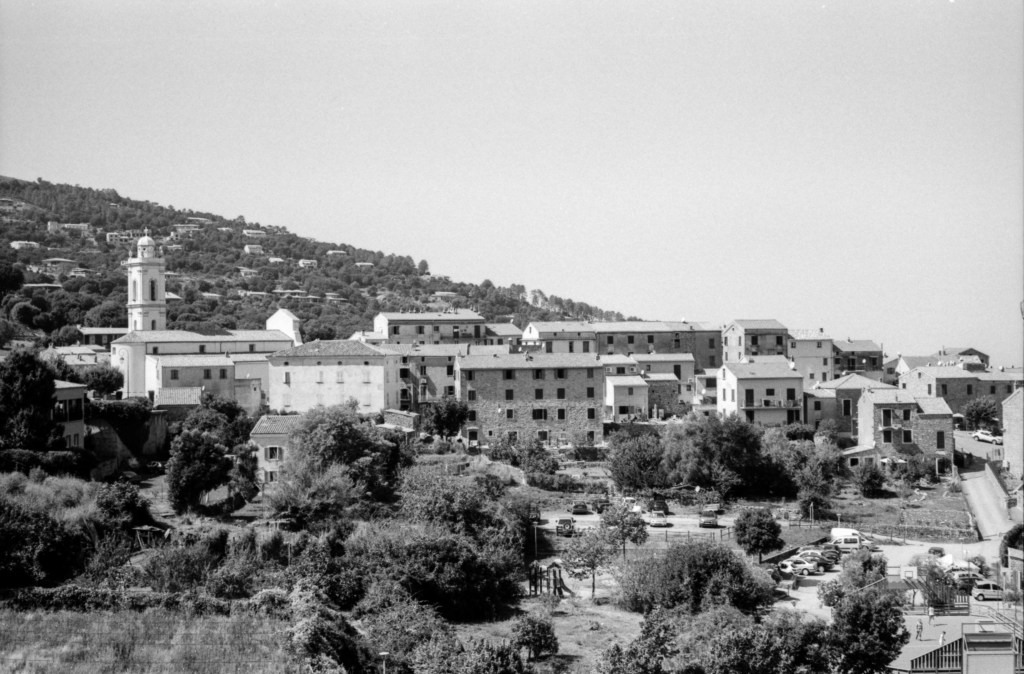
Best Time to Visit Corsica
Before figuring out how you’ll be getting to Corsica, you’ll want to nail down when you plan on visiting. An assuring fact to keep in mind when choosing your travel dates is consistent sun. Corsica’s average of 2,800 hours of sunshine throughout the year is impressive. This clearly means that summers are accordingly warm and enjoyable for beaches, camping and coastal activities such as boat rides. The remainder of the year remains mild near the coastline. The mountainous and inland areas will get appropriately cold with even heavy snowfall.
Unsurprisingly, visitors will most commonly head to Corsica in the summer to enjoy the beautiful beaches , crystal clear water and astonishing coastline. June – August are peak season months for tourists and will be the warmest months with temperatures hitting 27°C / 80°F. It’s highly recommended to book accommodation with plenty of time before your trip as availability begins to diminish. A budget friendly and fun alternative is to camp on Corse at one of the many phenomenal campsites instead.
→ ⛺️ Read More: Camping on Corsica Guide ←
The summer season on Corsica ends later than one may assume. Visiting as late as October means you’ll still be able to enjoy nice sunny weather. You’ll also be rewards with half the number of people visiting Corse. The best aspect of visiting during a shoulder month such as October are the deals you’ll find on hotels and apartments. Experiences and guided tours will also cost less as operators are trying to fill seats during slower times of the year.
Winter & Shoulder Season
A winter holiday in Corse can be enjoyed on the slopes as there are a few ski areas on the island. The mountains are modest but Station de ski de Ghisoni and Station de ski d’Asco are both beautiful and delightful options for enjoying a winter vacation on Corse. If you’re looking for a unique way to spend Christmas , consider staying in Corsica for the holidays. With being on an island, you’ll experience unique traditions different from the ones in mainland France or Italy. The Corsican culture in general can be very distinctive and there’s no better way to discover its magic than by observing Christmas on the island.
Traveling to Corsica in the fall and spring time is ideal for hikers or other outdoor sports such as mountain biking . The weather is not scorching hot and more than half of the month’s days will be dry. November – February is really the only time one would want to steer away from visiting Corse for spending time outdoors. With November being the wettest month of the entire year, the rain does begin to disappear by March and April.
→ 🌞 Find flights to Corsica in the summer ←
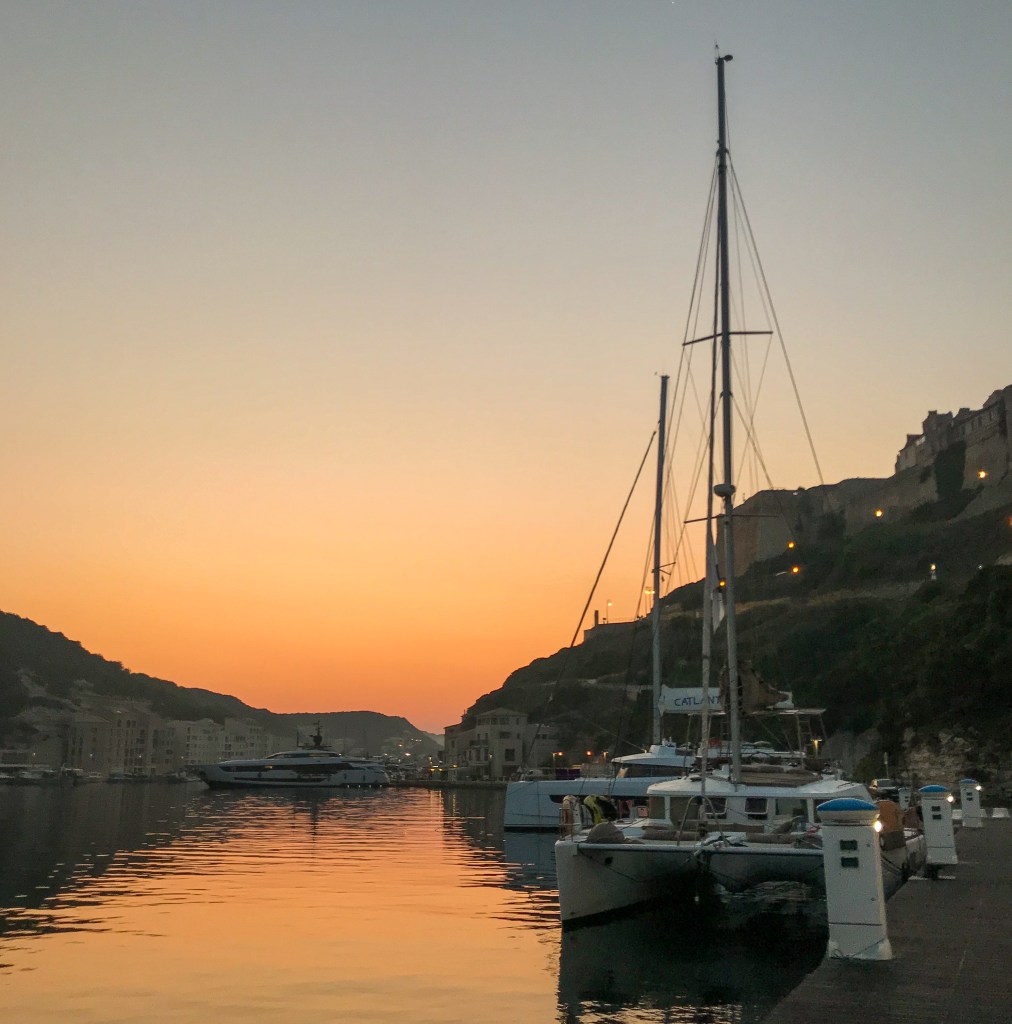
Taking a Ferry
The number of ferries to Corsica is abundant. This has resulted in ferry travel to be an incredibly popular way to get to Corse island. You’ll see below that the possibilities of arriving in Corse by ferry are very practical. Routes depart from various locations and arrive in Corsica on all sides of the island.
Taking a ferry to Corse is also feasible not only from France but other European ports . The most frequent and favoured Corsica ferry is operated by Corsica Sardinia Ferries which runs service between Corse, Sardinia and Elba. The vast amount of ferry routes and frequency of them makes taking the ferry to Corse an efficient and flexible option for getting there. We’ve included brief overviews on how to get to Corsica from a few popular departure locations such as mainland France and Italy below.
→ 🚢 Find and book ferries to Corsica ←
Things to Know About Taking a Ferry to Corsica:
- Crossing times will clearly depend on which port you depart from and arrive in. They can range anywhere from 2.5 hours to 12 hours!
- For longer haul rides, private seats and cabins are available for additional fees.
- There are a few different major companies who operate ferry routes to Corsica. They include Corsica Ferries, Corsica Linea, La Meridionale and Moby Lines. Unless you’re loyal to a specific company, there isn’t too much of a difference in terms of quality. Do not worry about choosing the best company as it’ll solely depend on your route and time preferences instead.
- The main ports in Corse for arrivals include Ajaccio, Bastia, Ile-Rousse, Calvi, Propriano and Porto-Vecchio.
- You can take the ferry as a foot passenger, bicyclist or passenger with a vehicle. Variables such as car size and length, pets and age of passengers can affect ticket prices.
📅 Despite the many ferries to Corsica, you’ll want to book your ferry tickets far in advance for travel dates in July and August , especially if you don’t like risking it.
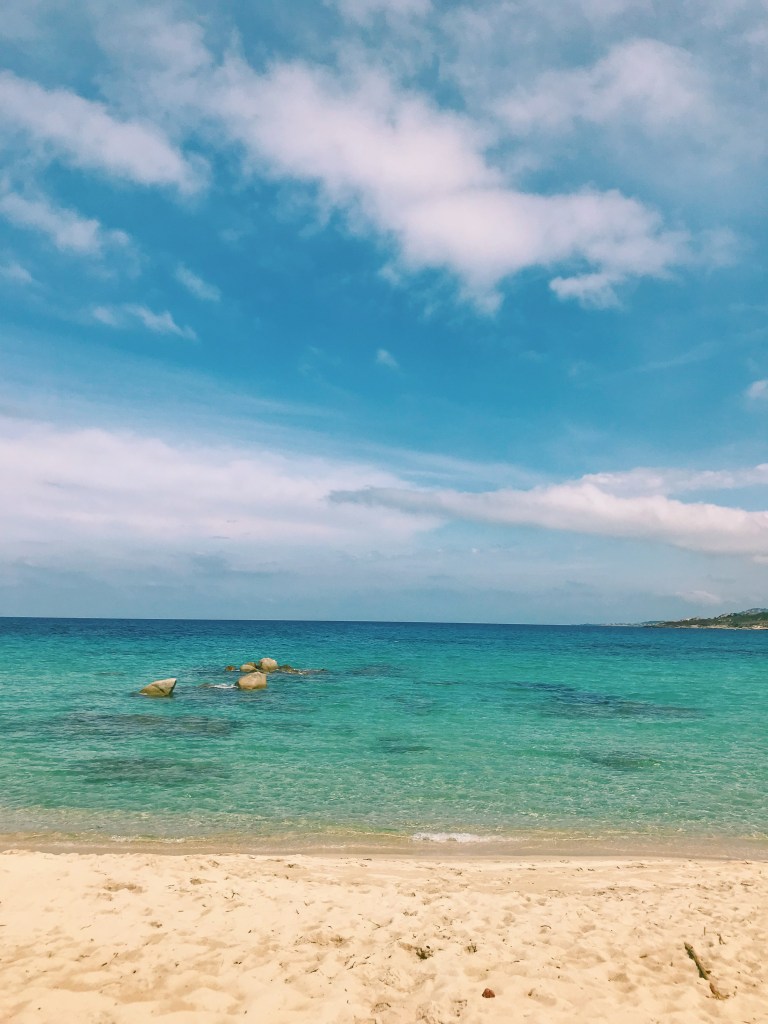
How to Get to Corsica From France by Ferry
Since taking a ferry from mainland France to Corsica is technically a domestic ferry , the departure and arrival locations are plentiful. Given the flexibility of ferry routes, you can precisely plan which exact location you want to arrive in on Corse instead of having to travel from the port to the area on Corse you wish to stay. These are the ports on mainland France from which ferries to Corsica depart:
Marseille Nice Toulon
From these main ports, you can reach all of the following ports and towns on Corse island. The ferries from France to Corsica routes are diverse which is especially beneficial for passengers without vehicles . This is incredibly convenient if you have a specific area in Corsica that you know you want to visit or found a hotel in.
Ajaccio Bastia Ile Rousse Porto Vecchio Propriano (Only accesible from Marseille)
The longest ferry ride from mainland France to Corsica is from Toulon to Porto Vecchio which takes 15.5 hours and only sails once a week. Nice to Ile Rousse is the shortest ferry ride in just under 6 hours. This orderly crossing time makes it convenient for those interested in combining a vacation along the French Riviera with a quick ferry from Nice to Corsica. Additionally, the France to Corsica ferry routes are available all year round and are not just a seasonal way of transportation.
→ 🚢 Find and book ferries to Corsica from France ←
How to Get to Corsica From Italy by Ferry
You may quickly notice the town names in Corsica are more Italian sounding than French. This is because of Corse’s long and interesting history of being part of the Republic of Genoa rule until the mid 1700s. Although most Italians are not visiting Corse for the deeply rooted historic connection to the island, Corse is very accessible from Italy by ferry. Ferries to Corsica from Italy are regularly serviced and depart multiple times per week . This makes Corse a very favourable opportunity for anyone traveling throughout Europe and planning on visiting multiple destinations. The major ports of departure in Italy include:
Livorno Genoa Piombino Savona Santa Teresa di Gallura (Sardinia) Moby Lines and Corsica Ferries operate a majority of the routes between Italy and Corsica. The Piombino to Bastia journey is the quickest and takes just under 3 hours. Piombino is located in the province of Tuscany and is a smaller scale port compared to the other major ones in Italy. Although Piombino is only one hour from the bigger port town of Livorno, it’s nearly a two hour shorter ferry ride to Corsica than if you were to depart from Livorno. The longest ferry route from Italy to Corsica takes 7 hours from Savona to Ile-Rousse on the northern tip of the island.
The Rome to Corsica ferry route is currently not available but has historically departed from Rome’s port of Civitavecchia. If you are visiting Rome and are interested in taking a ferry to Corse, you would need to depart from Piombino. By car or train, Piombino port is 3 hours away from Rome.
→ 🚢 Find and book ferries to Corsica from Italy ←

How to Get From Sardinia to Corse by Ferry
Travel between the two Mediterranean island s is fabulously easy and quick, both for foot passengers and passengers with vehicles. The port in Bonifacio on the southern tip of Corsica serves only one route, the route from south Corse to Santa Teresa Gallura in Sardinia. This route sails multiple times per day and only takes one hour . Even if you are flying to Corsica or Sardinia, taking this short ferry is a great solution to seeing both islands in one trip.
A ferry to Sardinia from Corsica is also possible from other ports on Corse but they do not sail every day. If you plan your itinerary accordingly, it’s achievable to take a ferry from Ajaccio, Porto Vecchio and Bastia to the norther end of Sardinia on select days of the week.
→ 🎟 Find routes and tickets for ferries to Corsica ←
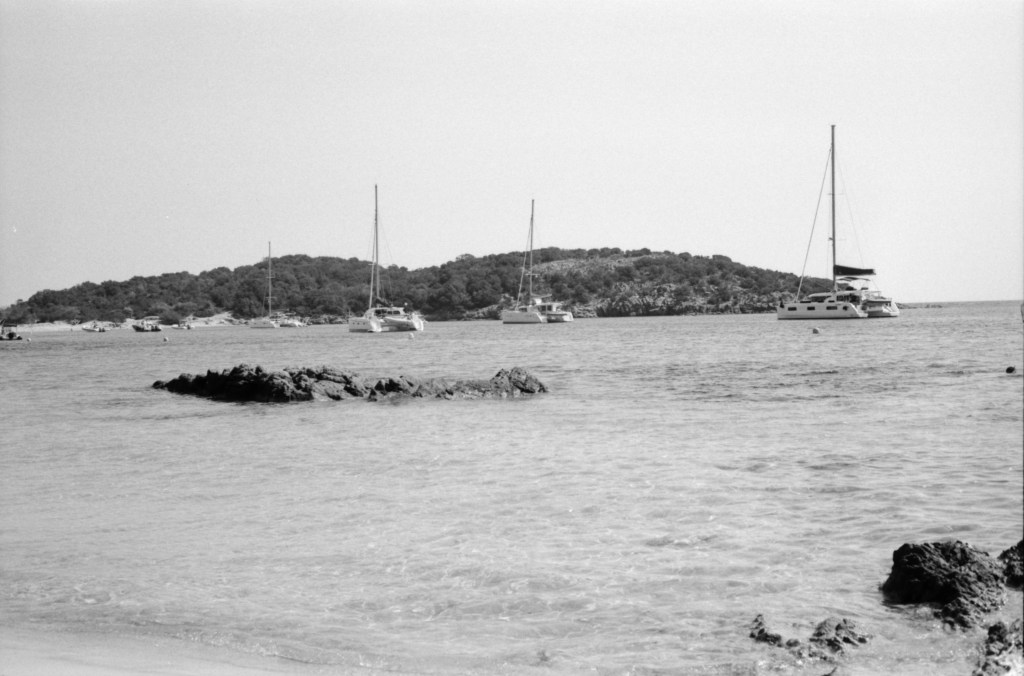
Flights to Corsica
It seems like a lot for a relatively small island, but Corse has four international airports available. There are technically even more airports but the ones that aren’t listed below are small and not used for typical commercial flights. If you are booking a flight from or to a destination with multiple airports, always be extra mindful and aware of the airport you booked. Nothing ruins a vacation like the silly mistake of going to the wrong airport!
Airports on Corsica:
Ajaccio Napoléon Bonaparte Airport (AJA) – located 10 minutes by car to the center of Ajaccio
Bastia Poretta (BIA) – located 30 minutes by car to Bastia town
Calvi Airport (CLY) – located 10 minutes by car to the city of Calvi
Figari Sud-Corse Airport (FSC) – located 25 minutes by car to the nearest major town of Porto-Vecchio
→ ✈️ Find flights to Corsica island ←
→ 🚙 Book a cheap rental car on Corsica island ←
Which Airlines Fly to Corsica?
All four Corsica airports serve flights by some of Europe’s most popular airlines. You’ll find exclusivity with a handful of airlines and specific airports but it really will just come down to your preference on route, ending location and date(s). You’ll find that Air Corsica and Air France have the most coverage and are operational at each airport in Corsica. Here is a full list of airlines which fly to Corsica:
Air Corsica Air France Amélia British Airways Easyjet Eurowings Lubeck Air Lufthansa Luxair Norwegian Air Shuttle Regourd Aviation Transavia France Volotea Vueling
Does Corsica Have Direct Flights?
The island of Corse is actually closer to mainland Italy than it is to France, but you’ll find the most direct flights to be domestic . Nonstop flights from any major French airport to Corsica are available any time of the year.
During the summer, many European cities also begin to offer direct flights to the island of Corse. It’s crucial to double check off season flights versus high season flights as routes are subtracted and added accordingly. Aside from French cities, there are some prominent nonstop flights to Corsica from European cities : Munich to Bastia (1 hr and 20 mins) Rome to Bastia or Ajaccio (1hr) Barcelona to Bastia (1 hr and 15 mins) Zurich to Ajaccio (2 hrs and 30 mins) Oslo to Ajaccio (3 hrs) Copenhagen to Bastia (2 hrs and 15 mins) Rotterdam to Bastia (2 hrs) Berlin to Bastia (2 hrs) Lisbon to Bastia (2 hrs and 30 mins)
→ 🛫 Find flights to Corsica island ←
How to Get to Corsica From The UK
Flights to Corse depart from all of London’s main airports including Heathrow, Gatwick and Stansted. Nonstop flights from London to Bastia are often operated by easyJet . British Airways also offers direct flights which are typically more expensive and land at Figari Airport instead. Flight time from the UK takes a little over two hours to reach the beautiful island of Corsica.
→ 🚉 Browse routes and book train tickets to France ←
How to Get to Corsica From The U.S.
Unfortunately, you won’t find a direct flight from the U.S. to Corsica but this doesn’t mean it’s a completely inconvenient place to get to from the Unites States. Since France is so well connected to Corsica, you just need to focus on the cheapest and quickest way to get to France. Nonstop flights from cities like Paris (Paris CDG and Paris Orly) are available daily and take less than two hours to reach all four airports Corsica airports. These domestic flights are typically operated by easyJet, Air France and Air Corsica the entire year.
→ 🏝 Find flights to Corsica island from the U.S.←
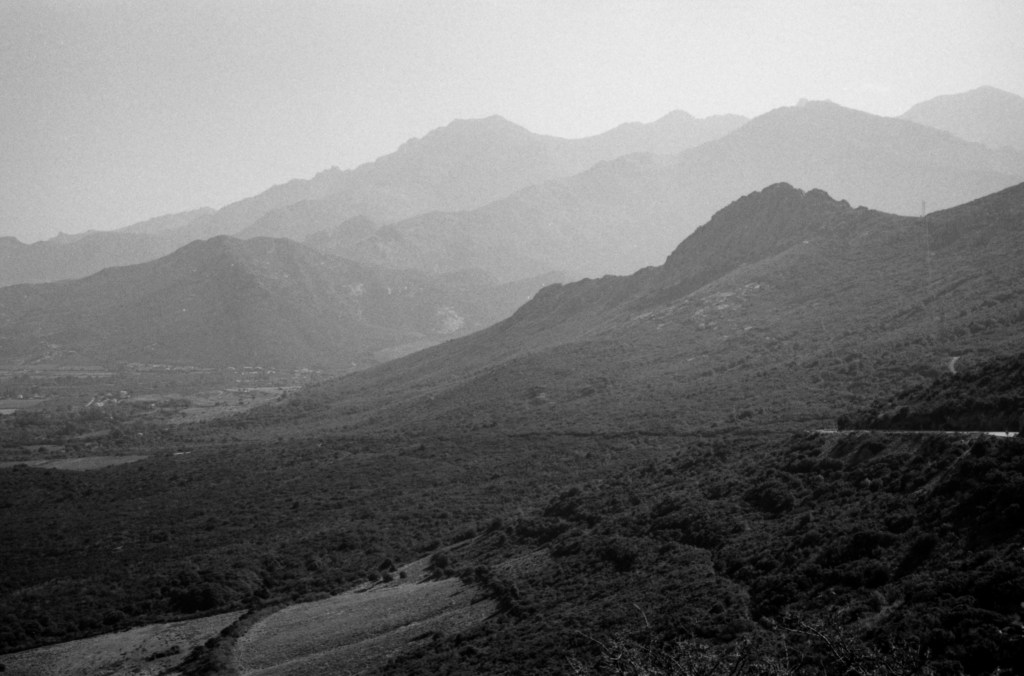
Getting Around Corsica
There are many places we’ve visited where we end up parking our car for a few days and explore the area on foot instead. These places tend to be super walkable or public transportation is efficient and accessible. Corsica is just not one of these places. If you do not have a rental car as part of your itinerary, we highly recommend considering it if you don’t plan on staying within walking distance of your hotel the entire trip. We understand everyone has their own style of traveling but to not venture far from your home base in Corsica would be a shame. Corse is one of the most spectacular places in Europe and to properly tour what it has to offer, you’ll want a car.
→ 🚗 Book an affordable rental car in Corsica ←
Driving your own car? Corsica island is an ideal destination for overlanding. Bringing an off-road vehicle to the island is a fantastic way to experience Corsica. There are many secluded and difficult to reach areas on Corse, ideal for those looking to do some 4×4 excursions or reach unfrequented beaches.
Travel Resources for Getting to Corsica
Affiliate Disclaimer: Please note that some links found in our posts are affiliate links. Should you choose to purchase through these links, we may receive a small commission at no extra cost to you.
Share this:
2 thoughts on “a complete guide on how to get to corsica”.
Pingback: The Best Corsica Beaches - Adventures of Ace
Pingback: Corsica Road Trip Guide: Sights and Itinerary
Leave a Reply Cancel reply
Discover more from adventures of ace.
Subscribe now to keep reading and get access to the full archive.
Type your email…
Continue reading

IMAGES
COMMENTS
Find the Best Things To Do in Corsica. Compare Prices and Book Online. Full Refund Available up to 24 Hours Before Your Tour Date. Quick & Easy Purchase Process.
The Trails of Corsica: Cap Corse, Corte & Bonifacio with Original Travel. Starting from £2,055 . Corsica from North to South: Mountains, Sea & Delectable Cuisine with Original Travel. Starting from £ 3,125 . Discover all the offers Your holiday at Le Home with Corsican Places. From £765 per person. Your holiday at Casa di l'Olivu with ...
Retrouvez toute l'offre en un clic! Site Officiel des vacances en Corse. Trouvez toutes les informations pour vous inspirer et préparer votre séjour en Corse: idées séjours, hébergement ( hôtels, campings, locations..), transports, sports et loisirs, incontournables.
Bastia 2. Cap Corse. Located North of Bastia, Cap Corse is among the best places to see in Corsica. What are the best things to do in Cap Corse? Take the customs officers' Path ("Chemin des douaniers" in French) that connects the Macinaggio and Centuri villages. During this 19 km long walk along the coast, you will enjoy splendid views.; This trail is divided into 2 sections:
Visiting Corsica: paradisiacal beaches, surprising citadels, majestic mountains… the beauty of the landscapes of the island of Corsica offers you unforgettable holidays! But to make sure your trip to Corsica is a success, it's best to have some information in mind and be well prepared. On this page, we have gathered all our travel tips to help you make the right choices and to find the ...
Col de Bavella. 17. Forêt de Valdo Niello. Map of Attractions & Places to Visit in Corsica. 1. Ajaccio. Ajaccio. Corsica's most famous native son, Napoléon Bonaparte, was born in this bustling capital city, pleasantly situated on the Gulf of Ajaccio.
9. View the clifftop beauty of Bonifacio from the sea. Bonifacio is not only the oldest town in Corsica (founded in about 830 CE), it's also the most spectacular. Perched atop 100m-high, layered white limestone and sandstone cliffs, it boasts phenomenal views south across to Sardinia (only 13km/8 miles away).
North-east. North-east Corsica includes the popular port towns of Saint-Florent and Bastia, as well as Cap Corse and the vineyards and villages of the Nebbio region, and also the remote beaches of the Desert des Agriates (the only region in Europe officially classified as a desert).. The peninsula known as Cap Corse extends north from Bastia to reach some of the more secluded parts of the ...
9. Discover the famous beaches of the south: Palombaggia and the others (What to do in Porto-Vecchio) 10. Visit Bastia. 11. Listen to a concert of Corsican polyphony. 12. Live a magic moment in Cucuruzzu. 13.
Corsica (French: Corse, Corsican: Corsica) is an island in the Mediterranean Sea southeast of mainland France and west of Italy.It is a region of France with a special constitutional status. Corsica is one of the least-visited of the large Mediterranean islands, but has many attractions including historical sights, incredible landscapes and - on the coast at least - a dependably warm and sunny ...
Corsica. Jutting from the foaming Mediterranean like an impregnable fortress, Corsica resembles a miniature continent, with astounding geographical diversity. Within half an hour's drive, the landscape ranges from glittering bays, vibrant coastal cities and fabulous beaches to sawtooth mountain ridges, verdant valleys, dense forests and time ...
Corsica (/ ˈ k ɔːr s ɪ k ə / KOR-sik-ə, Corsican:, , Italian:; French: Corse ⓘ; Ligurian: Còrsega) is an island in the Mediterranean Sea and one of the 18 regions of France.It is the fourth-largest island in the Mediterranean and lies southeast of the French mainland, west of the Italian Peninsula and immediately north of the Italian island of Sardinia, the nearest land mass.
A thousand journeys to live year-round. Corsica is a land of adventure. Whether you are a sports enthusiast, an epicurean, a culture enthusiast, a nature lover or an experienced gourmet, the island lends itself to a wide range of activities and stays all year round. Sublimated by all the seasons, it is a thousand experiences to live all year round.
The center of Corsica is mountainous all the way to 2,706 m (8,878 ft). It is a world of magnificent gorges and a hiker paradise. Its main town Corte has a long history and and one of the most breathtaking view in Corsica. Restonica Valley Corsica.
11. Saint-Florent. Often compared to Saint-Tropez, Saint-Florent is Corsica's second-largest marina after Ajaccio. Sandwiched between the mountainous wilds of Cap Corse and the spectacular, untouched Désert des Agriates, the charming town is known for being the gateway to some outstanding beaches.
Corsica is a wild island, in every sense of the word. Birthplace to Napoleon, Corsica is the least economically developed region in Metropolitan France. Compared with mainland France, Corsica is very sparsely populated. None of the towns on the island is large; even the capital of Corsica, Ajaccio, has a population of only 65,000.
The French call Corsica L'Île de Beauté (the Isle of Beauty) for good reason: with 20 mountains topping 2000m the Mediterranean island combines dramatic mountain scenery with beautiful beaches, hidden coves, age-old stone villages, and vegetation that ranges from Alpine to dry Mediterranean.. The mountains dominate the island's western and central regions and form the central bone of the ...
Two of the less common ways to visit Corsica are (1) if you have several weeks to explore at your leisure by car you could follow the Corsica Coast road that circumnavigates the island, and (2) see our guide to hiking in Corsica if you prefer to explore the hard way - on foot - by following one of the long distance paths across the mountains. With this guide we introduce many of the highlights ...
Here are seven of the best reasons why you should visit the French island of Corsica. " Corsica boasts a rich history, ancient buildings, winding cobbled streets, flavorful cuisine, and colorful art and music scenes. The weather in Corsica is gorgeous year-round. 1. The weather.
11. Erbalunga, a stunning coastal village in Corsica. Erbalunga was once the most important harbor on the Cap Corse, a fact supported by the magnificent houses that still stud the peninsula to this day. There's a small network of squares and streets which really give off that old city harbor vibe.
Canyoning nel Sud della Corsica con Corse Rando Canyon. Da 55€ a persona. Discover all the offers Soggiorno Gastronomico in Balagne . 290€ per persona. Discover all the offers Passeggiate in mare nell'Ovest della Corsica con Crociere Grand Bleu. Da 30 a 75 € a persona. Attività nautiche nel Sud Corsica con Bordemer Croisières ...
Maps can't tell the truth about Corsica. From above, it looks like any other island: a patch of green against the blue. But Corsica is first and foremost a mountain—sheer cliffs rise from the ...
How to Get to Corsica From France by Ferry. Since taking a ferry from mainland France to Corsica is technically a domestic ferry, the departure and arrival locations are plentiful.Given the flexibility of ferry routes, you can precisely plan which exact location you want to arrive in on Corse instead of having to travel from the port to the area on Corse you wish to stay.